Today TomTom has announced two new versions of their TomTom GPS watches. These new additions add in optical heart rate monitoring straight into the back of both the TomTom Runner and Multisport GPS watches. The new line – called the ‘Cardio’ utilizes the well known Mio sensor technology to measure your heart rate directly at your wrist, and does so in a form factor that’s waterproof to 50-meters.
I’ve been using the unit now on a number of rides and runs, and thus have a very solid grasp of how well they’ve completed the integration. Which, is really what this is. It’s essentially taking an existing TomTom Runner (or Multisport unit), and stuffing a Mio optical sensor in the back to measure heart rate and adding a couple of heart-rate specific information screens. Beyond that, it’s basically identical to the existing units. Of course, the addition of the optical sensor is a pretty huge thing.
Because I want to be transparent about my reviews – TomTom sent me a final production version of the TomTom Multisport unit. Once I’m complete here, I’ll send it back to them in Amsterdam and then go out and buy my own (to be able to support y’all in the comments section down the road). Simple as that. Sorta like hiking in wilderness trails – leave only footprints. If you find my review useful, you can use any of the Amazon or Clever Training links from this page to help support future reviews.
Lastly, at the end of the day keep in mind I’m just like any other regular triathlete out there. I write these reviews because I’m inherently a curious person with a technology background (my day job), and thus I try and be as complete as I can. But, if I’ve missed something or if you spot something that doesn’t quite jive – just let me know and I’ll be happy to get it all sorted out. Also, because the technology world constantly changes, I try and go back and update these reviews as new features and functionality are added – or if bugs are fixed.
So – with that intro, let’s get into things.
Unboxing and contents:
As is often the case with earlier units, I don’t actually yet have a full production box to unbox for you. I do however have a full production unit, with production firmware. Just…not the box…yet.
Still, as soon as I do I’ll quickly add those in.
In the meantime, the core contents are actually rather simple and straight forward. It consists of three things: The watch pod, the strap, and the charging/sync cable:
The pod is virtually identical in size and shape to the previous pods (more on that in a minute), and is fully compatible with previous straps.
The core difference though is the backside, which now contains the optical sensor. This sensor will read your heart rate via your wrist, by using optical light sensors to view down into your capillaries and then read your heart rate, which is typically transmitted to you in beats per minute (BPM).
Next, is the strap. The bright red and white won’t easily be lost. And, thankfully they’ve tweaked the band a tiny bit to fix one issue myself and others had with previous editions: It falling out and hitting the ground.
There is also a black edition of the strap as well:
This new strap has a bit more rubber around the edge, making it rather difficult to pull the pod out accidentally (or, even on purpose). I suspect the additional rubber is actually dual-purpose. First is to reduce incidents of the pod hitting concrete when taking off the watch. But likely more importantly is because the rubber edging acts as a light barrier. Light is the evil arch enemy of the optical sensor. If light gets in, it reduces accuracy.
Just to be clear, I’ve tested the old pods in the new strap, and it works great. And, for fun, you can also place the new pod in the old straps (not sure why you’d want to, but you can).
Adding the strap in with the pod and turning it on, here’s how it all looks:
Finally, we’ve got the USB charging cable. This is used to to both charge the unit as well as to synchronize activities via your computer (PC or Mac).
The cable is identical to the existing cable, and works with new and old units alike. Note that you can also use your phone to sync activities, which I’ll cover a bit later on. Note that the unit does not enumerate as a standard USB mass storage device (like a thumb drive), thus, if you’re running a computer operating system outside of Windows/Mac, it won’t show up.
Size Comparisons and Weight:
As you’ll see shortly, the TomTom Cardio variant of the Runner and Multisport is identical in size to that of the non-cardio versions. And, both the Runner and Multisport Cardio units are visually identical as well to each other.
But first, we’ll look how it compares to other units in the running and triathlon realm. I tried to put as many competitive units as possible into the same picture, including those that compete with both the Runner and Multisport editions.
From left to right (above/below): Garmin Fenix2, Adidas Smart Run GPS, TomTom Cardio, Polar V800, Soleus Pulse, Suunto Ambit2 R (2S is identical), Timex Run Trainer 2.0, TomTom Runner/Multisport (non-cardio), Garmin FR620, Garmin FR220.
Depth wise you can see that the TomTom is among the skinner of the watches. However, be aware that it does have a bit more of a curved plastic chunk sticking out the bottom where the button is.
Finally, here’s a bit of a closer look at the TomTom and some of the higher end units.
As I noted earlier, the differences between the previous TomTom units and the new Cardio ones are nearly physically indistinguishable. Below, you can see the two from the front (ignore the screen, I had an older unit not updated with the phone option).
Below, you can see the back of the same units. In this case, the only physical difference is that the new Cardio unit has the optical sensor, versus a solid backing of the other unit.
So how does that affect weight? Well, it doesn’t seem to very much. First, let’s start at the full weight including the newly designed strap – 63g:
If you compare that to the previous unit with a sorta similar strap, you’d see a 10g increase.
Except, that doesn’t really tell the whole story. Instead, check out the actual pod portions. Below, is the Cardio at 32g:
And then, the non-cardio at 31g:
In other words, it all really comes down to the strap adding the weight. But I don’t find the weight excessive, and it’s certainly far less than most other multisport watches on the market (most of my reviews have weights in them).
Running – Outdoors:
The TomTom watch is really a runners watch, that happens to bike and swim on the side. So in many ways, I find that it’s at its best while I’m running. To start off an activity, we’ll dive into the menu using the button below the display. This buttons acts like a little joystick to control the unit. The display itself can be tapped along the right edge to turn on/off the light, as well as to create laps in certain situations.
Once we’ve selected running we’ll go ahead and wait for the unit to get satellites and initialize the optical sensor. Neither take very long. The TomTom unit will pre-cache satellite information each time you connect it to your computer. In doing so it knows the satellite locations and can pickup satellites in just a few seconds. My testing has found that I’m rarely waiting more than those few seconds (literally, a few, like 3-7 seconds).
The optical sensor is generally also quite quick, finding my HR in under about 10-seconds. Though sometimes I’ll notice it takes a little bit longer (upwards of 20-30 seconds) to find HR and start displaying it.
Once that’s ready, we’ll press to the right to start the run. As we do so the unit will immediately start recording data and displaying the metrics we’ve chosen.
The unit will always display two metrics up top (known as ‘left’ and ‘right’), as well as one metric down below on the main screen. You can press up/down to change the main screen metric, and you can customize the left/right metrics in the settings.
For example, here’s the current pace:
And here’s my lap distance on the main screen, which in this case equals my main distance (shown in the upper left):
Or my heart rate in beats per minute:
I can then press to the right to trigger some of the heart rate training features. This includes the ability to see visually where I’m spending my time zone-wise, as well as a heart rate graph of the last little bit of the activity:
When it comes to breaking up the data, you can use the lap function, which is found in the training menu. The lap function allows you to tap the screen and create a lap whenever you’d like. It’ll give you the lap count and the average pace for that lap:
This then also enables the lap data fields such as lap time and lap distance, which will be shown during the activity. Within laps you can manually set them (as I do when running my custom workouts), or you can have them automatically created based on distance (as I do in my long runs, every 1-mile), or based on time (such as every 10 minutes).
Note that TomTom puts the lap function as a ‘Training’ option, which means it’s not compatible with the other training options, such as goals, intervals, pace, race or zone training…which, I’ll describe next.
In the case of goals, you can set a predefined end-state goal – such as 10KM or 60-minutes to run. When you do so the unit will show a pie chart (like Pacman) of your progress towards that goal:
Along the way you’ll get notified at 50%, 75%, and 90% of your goal. Goals can be defined based on calories, time, or distance.
Next, there’s the ability to train towards a zone. This allows you to specify a target for a workout, using either pace or HR. If you select pace, you can choose a specific pace range. I like this implementation, as it recognizes the fact that it’s virtually impossible for a GPS to pace you to exactly 7:35/mile. Rather, it’s much easier to keep you in between 7:30/mile +/- 20 seconds.
Next there’s the interval function. TomTom has made some solid progress here in the last year, implementing a fairly solid interval function on the unit. Within this you can define the warm-up (time/distance), the work period (time/distance), the rest period (time/distance), and the cool-down period (time/distance). Then, you’ll simply define the number of reps, and it’ll walk you through the workout:
Note however that there’s no method to define a target – i.e. ‘7:30/mile’ or HR Zone for any portion of the workout, so you’ll have to remember what those are. Though I suppose most people generally know the defined level of pain of the workout fairly well going into it. But that means you won’t get any sort of alerting or pacing either.
Now, as you’re running in any of the modes you can pause the workout at any time by holding the left button down for 3 seconds. This ensures that accidental button presses don’t trigger an immediate pause and then end to the workout. If however you want that, you can turn off the ‘Lock’ setting within the unit settings.
Finally, to end a workout entirely (and thus automatically save it), you’ll go ahead and repeat the same procedure from the paused screen, holding for three seconds again.
In looking at accuracy between the units, I saw it perform within 1% of any other GPS I was using at the time. For example, below, the TomTom measured 8.03Mi, while the Fenix2 measured 8.05Mi.
Or here, the TomTom measured 20.75mi, while the Fenix2 measured 20.83mi. Well within the range of any consumer GPS device for accuracy differences.
Running – Indoors/Treadmill:
Next, we’ll look at treadmill capabilities. The TomTom utilizes an internal accelerometer to measure pace and distance indoors without the use of GPS. It does this by evaluating arm swing and cadence to determine pace. TomTom was among the first major companies to introduce this on their units a year ago, and so I was curious to see how things have progressed since then. Last time I looked at it upon launch, it generally didn’t work too well for me.
Treadmill mode is a separate standalone mode that simply enables only the optical HR sensor and the accelerometer for measuring the pace/distance. Note that you’ll get most of the same training options as in outdoor running modes – so you can still do functions like laps/zones/intervals.
Once you start it, it’ll immediately start recording pace/distance like other modes.
However, upon completion of a treadmill workout it’ll give you the opportunity to ‘Calibrate’ the unit. So I started off with a short run to calibrate things. Interestingly, out of the box it was only .01KM away from what I had just ran.
All you do in the calibrate menu is simply enter in the actual distance that you ran, and it then adjusts the file:
As I often do for these tests, I find it easiest to just work my way through a step ladder of paces on the treadmill. I start at a pace slower than my usual, then iterate every minute until a much faster pace than my usual long run pace. In this case, I went with 10KPH (about 6MPH) up to 17KPH (~10.5MPH). I’m using KPH/MPH simply because that’s what my hotel treadmill offered to me.
Here’s the result below. In my case, the actual distance on the treadmill was 2.03KM, not 1.85KM. Now, the trick is actually being able to see the data in the tiny little chart they give you.
It’s really hard to see there, so I had to zoom in and figure out where things were good and where things were bad, one little piece at a time by hovering over the top of the line and matching it to my known paces for each minute.
In doing so I found that even though I topped out on the treadmill at 17KPH, the unit thought I topped out at 12.8KPH. What’s also strange is that for the last minute I actually dropped back down again to 12KPH (from 17KPH). Which, you can see isn’t reflected at all in the graph. Essentially, changing my pace had no effect on it.
So, for the fun of it, I tried another run on the treadmill – a different treadmill no less. Not that it would have mattered, my body is very clear when I’m running nearly twice as fast in one section as the other.
In this case, I did the first part of the workout on my left wrist, and the second half on my right wrist. Repeating an abbreviated 4-5minute pyramid build for each section. Here’s what it looked like from a treadmill pace standpoint:
And from the TomTom’s perspective? Another flat line, just like the first time.
Essentially, best I can tell, the unit and me only have one basic speed. When I speed up, it doesn’t really do anything (actually, eventually it says I’ve slowed down). When I slow down significantly – it does slightly shift my pace, but only by about 10% of actual.
Ultimately, this is similar behavior to what I saw last year. At the time, they were the first to attempt wrist-based speed detection in a mainstream GPS watch (Bryton had done it previously, as had a few other non-GPS watches). Since then, others have joined them, including Garmin, Suunto and Polar. While the jury is out on Polar’s attempt for a bit longer, in my testing of Garmin’s latest watch – the Fenix2, it pretty much nailed my indoor running based purely on wrist detection. And Suunto was right behind it as well.
In discussing it with TomTom, they’re working on an update for Q2 that they believe should fix many of the treadmill issues I saw, and should give proper speeds.
Cycling:
(This section applicable only to Cardio Multisport edition)
The TomTom Multisport Cardio variant supports a cycling mode, which enables you to have a dedicated cycling mode. Within this mode you can configure slightly different display screens, while also connecting to a cycling speed/cadence sensor. Further, if you purchase the ‘Performance Bundle’ edition, you’ll also get a barometric altimeter. Note this is a physical hardware change, and thus, is a separate physical unit and not just a simple firmware update.
In many ways, the cycling mode works very similar to that of the running mode. The key difference however is that the default metric is ‘Speed’ (i.e. MPH & KPH) versus ‘Pace’.
In the cycling mode you can also connect to a Bluetooth Smart Speed/Cadence combo sensor. This enables two scenarios. First is that you can get cadence (both indoors and outdoors). Second is that you can get speed indoors on a trainer, as well as outdoors in scenarios where GPS may not be accurate (i.e. a tunnel, or mountain biking in heavy tree cover with many switchbacks).
Now, you will want to be aware that the speed/cadence sensor needs to be manually configured with your wheel size. If you don’t do this, you’ll get inaccurate distance. Also of note that I discovered is that the speed sensor speed value will override GPS. Thus, if you happen to have the magnet fall out of alignment with the sensor, you’ll get a zero speed/distance value (been there, done that). This is a bit different than other units on the market that will look at situations where either GPS or speed sensor values equals ‘0’, and use the other speed source instead.
In addition to the speed data, you’ll get the cadence data, which can be added as a data field onto the unit itself. Further, that data will be recorded for later viewing:
In addition to the speed/cadence sensor you can also mount the unit to your handlebars using bike mount kit. This easily straps on using a rubber band type system, and securely holds the unit in place.
Now, the obvious problem here is that in doing so it’ll no longer measure heart rate via your wrist optically. So instead you’ll need a Bluetooth Smart heart rate strap if you want to gather HR data. The TomTom unit does indeed support connecting to external straps via the sensors menu.
In my case, I just kept the unit on my wrist so I could gather HR data while cycling. I also paired it to a speed/cadence sensor.
Living in Paris, many of the streets have cobblestones. It’s well known that vibrations and repetitive bumps cause issues with optical sensors (as well as accelerometers in other applications), and thus, it was the perfect place to test the validity of the HR data while riding. However, instead of covering exactly how that test ended up, I’ve included all my comparison test data later on in the accuracy section.
Next, I took a look at the elevation data on one of my rides – the only ride with a big hill in it. In this case I completed a nearly identical out and back – with the top of the hill being my turnaround point. Now it was ‘nearly identical’ simply due to the reality of one-way streets limiting my choices. But the elevation differences between the slightly different routes for a few blocks was minimal. Below, you can see the graph I made.
Except, here’s the thing – in my case, I was using the non-performance bundle, and thus, the elevation data shown on the site is actually from the server based on my GPS route, rather than recorded by the unit itself. This is true of the runner as well.
Ultimately, only the ‘Performance Bundle’ unit includes the barometric altimeter, and is/was not one of the units I was provided to test with. In that unit, you can add/select the ‘Elevation’ data field into the list of data fields shown on the watch in cycling mode. Down the road, they’ll be enabling it in running mode as well in a software update.
Finally, it’s worth noting that while the Multisport unit defaults to speed for cycling, you can actually use the TomTom Runner Cardio in running mode and just change the metric to speed instead of pace. It’ll label your workouts as ‘Runs’ on TomTom MySports, but ultimately if you export to any other 3rd party sites you can easily just change the activity type to ride.
Swimming:
(This section applicable only to Cardio Multisport edition)
The TomTom Cardio Multisport includes the ability to capture swim metrics while in pool. This includes distance (i.e. 2,100 yards/meters), strokes, time, and SWOLF. It does not include heart rate while swimming. Again, let me be really clear – as it stands today, the TomTom Cardio Multisport does NOT capture heart rate while in swimming mode.
Today, it focuses on the standard indoor pool metrics. In this mode you’ll start by selecting your pool size. The unit allows you to enter in any size from 15y/m to 50y/m. What’s a bit annoying though is that it doesn’t allow you to entire either a yards pool or a meters pool. Rather, you have to go back into your settings and change everything to yards or meters. Given many swimmers, especially in the US, will alternate between a 25y and a 50m pool depending on availability, it’s sorta frustrating this is still an issue nearly a year later. It also doesn’t allow you to enter partial yards (such as the 33.3M pool I swim in). (Update: They’ve released a fix to enable this).
In any case, the size is saved, but you’ll need to remember to switch back your total unit settings if your pool size doesn’t match what units you normally want displayed in running/cycling.
Once that’s done, you’re ready to start swimming:
Once you press to the right to start the unit, it’ll track each length of the pool. In doing so it captures strokes, lengths, distance, time and SWOLF. SWOLF is a combination of Swimming and Golf, and produces a swim efficiency score based on how many strokes you take per length. In theory, less is better, but in practice you have to be sure you aren’t artificially producing less strokes (with paused gliding) simply to hit a number. All major swim watches on the market today capture this metric.
You can press the up/down button to change display fields, and like in running and swimming you can specify the upper two display fields be whatever you’d like.
The unit in my testing has no problem with either flip turns or open turns (non-flip turns). For the swim below, I pretty much alternated each length doing one or the other. So you can mix them as well. It’s important to note that the way all swim watches on the market work today indoors is not via GPS, but rather via accelerometers. As such, pushing off the wall is ultimately what tells the watch whether or not you’ve completed a lap.
Thus it’s really important to push off the wall in a crisp manner, and to avoid random wanderings around the end of the lane when not in a paused mode. Or, going to the bathroom while not in paused mode. If you’re not swimming, pause the watch – simple as that.
I found it very stable in my pool, which on one day when I was testing I had 9 people in my lane, which meant I was constantly accelerating to pass folks, as well as slowing down when I couldn’t pass. It matched the exact distance that I swam, and the Garmin Swim on the other wrist also matched that distance.
Upon completion you’ll be able to see your swim totals online:
As you can see above, it’s pretty minimal. What you see above is the entirety of what you get. That’s it.
Now, before we move onto the heart rate while swimming piece, I do want to briefly mention a few modes that are within the unit in swimming. In my case, I just went with a straight ‘swim forever’ mode. In this mode there isn’t actually a way to mark any laps (kinda annoying), so you can’t easily divide up sets. But they do include the below modes which can help a bit:
Goals Mode: This allows you specify a total distance, time, or calorie target to aim for and gives you progress updates towards that goal.
Interval Mode: This works just like it does in running. The difference though is that you’ve got to enter in the distances in miles or kilometers. Which, isn’t really how most people swim. For kilometers it’s easy, but for miles it’s a mess.
Lap Mode: This allows you to automatically create laps after a specified time or distance. Like above, distance is entered in either in miles or kilometers.
Swimming – Heart Rate Metrics:
Now, I know all of you are wondering: How can I get heart rate while swimming?
Well, in the ‘Swim’ mode per the watch and as I’ve outlined in the previous section, it doesn’t turn on the optical HR sensor, nor will it pair with an external one. However, for fun, I decided to see what happens if I just told it to use treadmill mode instead. Treadmill mode on the TomTom Cardio is what I’m using as my ‘catch-all’ bucket for anything that I want optical HR on, but don’t want GPS on.
So, I turned on treadmill mode and waited for it to find my heart rate. Standing at the end of the lane line (wet), it took longer than normal – almost a minute (versus the usual 5-15 seconds). But, once it found it, it appeared accurate just standing there.
I then headed on out to swim some laps. I watched as the heart rate rose steadily and seemingly in concert with my effort, then, I watched as the heart rate stabilized after about two laps. The screen was incredibly easy to see underwater by just twisting my wrist slightly at the beginning of the ‘pull’ phase of the stroke, or pushing off the wall.
In doing so, I was able to monitor the HR pretty much constantly during that effort, and at no point did I see the HR veer out of control, or do anything unexpected. Upon completion of the set, I went ahead and just stood at the wall with my hand still underwater to see how well it would return to normal. In doing so, I saw no issues returning back to a resting/standing heart rate.
Below, is the heart rate snippet from that time period:
Again, because it’s in treadmill mode – there’s no strokes/distance/length data. There’s just a bunch of random junk distance data from the watch thinking I’m running on a treadmill. But, for those wanting the heart rate data, you now have a method of capturing it in a single unit. Remember that the unit can easily export out to CSV file, or any other file type including .FIT and .TCX (more on that later in the review).
In talking with TomTom about enabling heart rate during swimming mode (so you get swim distance/stroke/pace metrics), they noted it’s something they’re looking at, but are at the moment focused on ensuring the running experience with the optical sensor is the priority.
Multisport Mode:
(This section applicable only to Cardio Multisport edition)
Like the regular TomTom Multisport unit, the Cardio Multisport unit does not actually have a ‘multisport mode’. Traditional triathlon focused watches tend to have such a mode, which enables you to quickly switch between different sports in a race or brick (training) scenario.
It’s a bit puzzling that the unit still doesn’t have this functionality nearly a year later – especially given it’s focused exclusively on the multisport market. However, I suspect that lack of feature likely comes from the fact that the unit doesn’t do openwater swim tracking and thus, it’s limited in usefulness in a full end to end race scenario.
Further, given the typical quick satellite reception, you can easily save (hold left three seconds, then again three seconds) very quickly and then re-start a new session near immediately from the same locale in just a couple seconds. All of which most triathletes can do while running within transition.
I can only hope down the road we’ll see both outdoor swim functionality, as well as a multisport mode.
Optical Heart Rate Sensor Accuracy:
Before I dive into accuracy, let’s start back at the beginning though and explain what exactly an optical heart rate (HR) monitor is. These are heart rate monitors that use optical light sensors to view down into your capillaries and then read your heart rate, which is typically transmitted to you in beats per minute (BPM). While the end metric is the same, the measurement technology is different from heart rate straps of the last 30 years, which have been worn around your chest and pickup your heart rate electromagnetically. In the photo below you can see this green light emitting from inside the band of the watch.
Mio initially introduced this technology about 21 months ago with their Kickstarter funded Mio Alpha unit, which I subsequently reviewed once they produced final units. They subsequently launched their latest edition, the Mio Link, three months ago, which start deliveries in about 10 days.
Following Mio’s initial launch, another company – Basis, launched an optical HR device, the Basis B1 watch. However, that device wasn’t aimed at the sports crowd, but rather more at the activity monitor/tracker crowd. For example, it worked well for the 23 hours of the day you weren’t exercising, but didn’t measure HR during exercise. Ultimately, it uses slightly different technology and algorithms on the optical side.
Finally, fast forward to last fall, and Adidas launched their Smart Run GPS with the optical HR sensor built in. That sensor was provided by Mio. And just like the Alpha and Link, it worked spot-on for me as well in measuring heart rate optically.
There are other companies as well in this space, for example Texas Instruments supplies sensors to some companies. And 4iiii’s recently announced their optical HR pod products as well. And further yet other companies utilize various white label and internally developed solutions. Below, you can see such a solution on the Soleus Pulse watch (non-GPS).
So with that background in place, let’s take a look at accuracy on the TomTom Cardio unit, and see if it continues the tradition of quality heart rate data from an optical sensor.
Hard VO2Max Interval Run:
This was an interval run that started off with a 15-minute build period. Then, it transitioned into 8x800m, each at a fairly quick pace – resulting in a high intensity workout at pretty much my absolute max heart rate values. Here’s how things looked on the TomTom Cardio unit:
And then next, using a traditional heart rate strap (Garmin HRM-RUN):
In this case, you see that the HRM-Run for some reason struggled a bit on the 6th and 7th interval. I wiped away the sweat behind the strap and it immediately went back to normal. It was a fairly warm night, and combined with the higher intensity workout, I was drenched. On the first interval you see a bit of a delayed pickup on the HR strap as well.
In the above run, I saw no abnormalities with the Mio optical sensor within the TomTom unit. It worked flawlessly.
Long Run: 2 hours 30 minutes
This was a long and steady run, once I warmed up into zone, I stayed with it and was completely constant based on heart rate for the entire run. Here’s how things looked, first, the TomTom Multisport:
You’ll see one minor odditiy around the 7-8 minute marker, with a spike. I noticed it while running, and then tightened the strap. It was a little bit loose. Once I did that, the spike immediately went away.
Next, we’ve got data from a traditional heart rate strap (Garmin HRM-RUN):
As you can see looking at the two they are virtually identical after about the 8 minute marker once I tightened the strap. Throughout the run I’d glance and they were always the same or +/- a single BPM. Very impressive.
Cycling…Cobbles and All:
This was an hour long ride through the streets of Paris. In this case I wore the unit on my wrist, as opposed to using the bike mount – specifically so I could collect accuracy data. My route included long stretches of cobbles (upwards of a half a mile at a time), which are notorious for throwing off all sorts of sports technology devices.
First, the TomTom Cardio optical HR data:
Then next, the traditional HR strap data from a different non-TomTom unit:
They are very similar. The one difference you see is around the 33 minute marker, the HR strap seemed to produce a bit of a spike to 110BPM. I’m actually not clear if this was correct, or if the TomTom was correct here. I was descending (hence the lower HR’s), and thus I would have been surprised to see a spike. But since I was descending at night on cobbles, I was slightly less focused on the HR’s there.
The Girl’s Long Run: 3 Hours
In addition to my running and rides, The Girl has also spent some time with the unit, or more specifically, a long 3 hour run with the unit. I helped her get all set with the unit and then sent her along her way. Here’s the data from the TomTom unit first:
Looking at the above, there’s one spot at about the 12 mile marker where the unit seems to drop by about 20bpm. It’s unclear if that was reality or not (since the strap below doesn’t show it). You can also see a bit more variability in the second half of the run with the strap, as she increased intensity. She noted to me that the numbers were nearly always the same or within 1BPM or so when she looked at the displays. So from her HR zone pacing perspective, they were both valid.
And then, the data from the traditional HR strap (HRM-RUN).
In her case, you can see a single spike early on in the run on the heart rate strap. I checked with her, and she said that was erroneous and was not some sprint she did. That brief HR strap spike only lasted a few seconds out of 3 hours of running.
Given we’re talking about The Girl’s run, I do want to point out that while she found the optical HR piece just fine and dandy, she was not terribly thrilled with the pod on the watch itself. Specifically, she felt it dug into her wrist bone quite a bit and found it fairly uncomfortable for the run she used it on. This is likely because the pod is hard plastic and leaves no room for movement or flexibility.
Overall though, looking at all the optical heart rate stats from all the above rides/runs, I don’t think anyone could realistically say that the optical HR measurement didn’t perform better than the HR strap. It seemed to in almost every case, both for myself and The Girl.
All Day Activity/HR Recording:
First off, the TomTom Cardio does NOT record your daily steps. Nor, is it an all day activity tracker like a FitBit or Fuelband. Those products are designed for that purpose. Again, this is not one of them.
With that out of the way, I was curious. I was mostly interested in how well it’d be able to track my heart rate over the course of an entire day. Both in terms of accuracy, but also in terms of battery life. I previously did this experiment with the Mio Alpha (first generation of the sensor used in the TomTom Cardio). In that case I had to pair it to a phone in order to capture the data.
In this case though, I simply used just the TomTom Cardio itself. I started by ensuring I had a 100% full charge. Then I simply started a ‘Treadmill’ activity. In this mode the unit keeps GPS disabled, but turns on the optical HR sensor. It also tracks distance via the accelerometer inside the unit. Obviously, it’s meant for running on a treadmill.
The watch quickly found my heart rate as usual and off about my evening I went. For my walk to the grocery store the distance was roughly accurate, however, upon returning and starting to cook dinner the distance was no longer in the ballpark of reasonable. It had chalked up some three miles in about 45 minutes worth of prep work in my kitchen. My kitchen is roughly the size of two port-a-pottie’s floors. I couldn’t walk three miles in there if I tried. So with distance not really accurate, I focused on the heart rate side.
I’d occasionally glance down and see where things stood accuracy-wise, with each time the unit being right where I’d expect it to be. While sitting around watching TV I saw my HR fairly low (50’s). And while riding the city share bikes across town I saw it a bit higher (110-130bpm, with a slight spike once trying to make a light). All was good there.
But perhaps the most impressive feat was the battery. By the end of the first night the battery was still showing a full charge. And it wouldn’t be too far from the truth. It would end up taking 26 hours for the battery to drain fully – far longer than I ever expected. In talking with TomTom, this mode would get anywhere between 24-36 hours, dependent on a bunch of factors, but partially influenced by how hard the sensor has to work to read through your skin (darker skin/hair, etc…).
Looking at the graph at the end, I didn’t see a single HR spike in the entire day. The recording started around 6PM, and you can see when I went to sleep some number of hours later and the corresponding dip in heart rate, then when I woke up and set about my day. The higher chunk towards the 20hr marker is when I had to bike across a chunk of the city on the bike share bike.
I did note however that the TomTom site failed to display/load my 26-hour journey. Instead, I just used an export of the file and uploaded it to a 3rd party site that would take the file. I suspect having a file longer than 24 hours was the issue.
Now obviously, there are devices that are better suited for this purpose. The Basis B1 comes to mind specifically. However, for those that want to record heart rate data at a much higher accuracy level than the Basis, this is definitely an option. I wouldn’t use it for activity tracking (distance) though.
Sensor Support:
The TomTom Cardio supports two types of Bluetooth Smart sensors: The bike speed/cadence combo sensor, and the external heart rate sensor. While you might think it odd that it supports the external heart rate strap given it has a heart rate sensor in the unit itself, with the strap you can then easily mount the watch to your bike for riding and still get heart rate data.
You’ll pair both sensor types under the sensor menu:
Within the heart rate section you can simply choose ‘external’ (for the heart rate strap). For internal, you’ll just leave it as ‘on’.
For the bike sensor, you’ll enable it here as well. The unit will pair to any Bluetooth Smart Speed/Cadence combination sensor on the market (that uses the official Bluetooth Smart Speed/Cadence device profile). I happened to use the Wahoo Fitness Blue SC.
Somewhat frustratingly however, it won’t pair to the Bluetooth Smart cadence-only device profile. This meant I couldn’t use the new tiny Wahoo RPM cadence sensor pod. So, just be aware in case you’re buying a speed-only or cadence-only sensor.
Finally, note that the unit ONLY supports those two types. It does NOT support any ANT+ sensors, nor does it support any analog sensors (such as older Polar straps). It would support new Polar Bluetooth Smart straps, since those follow the Bluetooth Smart standard. And lastly, it doesn’t support any of the Nike straps, as those don’t follow the standards either.
Day to Day Watch Mode, Backlight:
The unit functions as a day to day watch in non-GPS mode for an extended period of time (many weeks). Within this you can setup a single alarm, such as for waking up.
When in standby the unit will always display the time of day (hours:minutes), as well as the date. It does not have an option to display the day of week, nor seconds. You can configure the time to display in either 12-hour or 24-hour format (i.e. 1:50PM or 13:50).
The backlight can be enabled at any time in standby mode by simply tapping the right side of the display. Additionally, the backlight can be switched to enabled for an entire activity, such as a night run. When you do this however you’ll burn through battery much quicker than normal – so be aware. Below, you can see the backlight in action:
With the backlight on I found it quite easy to see the display and numbers, even while on the bike with the unit on my wrist in a slightly awkward position (for cycling with hands on handlebars).
TomTom Mobile App:
TomTom recently introduced support for uploading completed workouts via your mobile phone to the TomTom MySports site, via Bluetooth Smart. When this was introduced back in January I did a full (and rather detailed) post on it, so I’d refer to that for more details. However, I’ll run through the basics here.
First, you’ll need a compatible phone. That means a phone with Bluetooth Smart support. On iOS that’s the iPhone 4s or newer, or the 2nd generation iPad or later. Once that’s done and Bluetooth is enabled you’ll download the MySports app. From there you’ll open the app up directly. You do not need to wander into your phone’s Bluetooth settings control panel.
You will however need to go into the phone option on your TomTom unit to start the pairing process.
Next, you’ll see the watch listed along the bottom in bold when it’s in range. Or, later once paired in a lighter color when not in range.
Simply tap on that line to start the pairing process. Once you do so it’ll show you a pin code on the watch, which you’ll enter in on the phone to validate you’re not trying to commit some sort of devious hacking of other people’s TomTom units within a few meters of you.
As soon as that’s completed the phone app will immediately enumerate the workouts from the watch and transfer them over. It’ll then upload them to the MySports site:
From the phone app you can also view workout overview information as well:
Note that with the phone app you won’t get exports of other file formats like .FIT for export to 3rd party services, so that’s one downside. TomTom has previously stated that they intend on adding in support for popular 3rd party companies directly from the app (i.e. a sync to Training Peaks for example). However, that hasn’t quite materialized as of yet.
TomTom Training Website:
As part of the platform TomTom makes available a training log site called TomTom MySports, which allows you to see information about the activities recorded on your TomTom unit. Like many sites in the industry, the backend is ultimately handled by MapMyFitness, and thus, one of the options you have is to link your MapMyFitness account to your TomTom unit.
For the purposes of this review though, I’ll just focus on the core MySports site experience. To begin, you’ll need to get data uploaded to the site. For that, there’s two options. The first, as previously shown is to use your mobile phone. The second, is to use the TomTom MySports Connect upload agent that can be installed on your computer. Once you plug the unit in via USB, it’ll automatically upload the workout to the MySports site:
Once on the site you’ll start at the dashboard. The dashboard shows you a list of your activities, along the top, the most recent activity on the left, and then activity totals along the right.
If we click on ‘View Activity Details’, we’ll be brought to the activity detail page for that particular activity, where we can dive further into charts and graphs.
The upper half of the page shows your activity totals, such as calories, pace, time, distance and elevation gain.
Meanwhile, if you scroll down you’ll get charts shown for a handful of metrics, including pace, elevation and heart rate. While the Multisport bundle will add barometric altimeter information, all TomTom units will show elevation on the site derived from the GPS path and then calculated by servers once uploaded to TomTom’s site.
You can mouse over any given spot on the chart to get the exact value for that particular point in the run:
Finally, there’s the option along the top to show your activity totals across a given timeframe. In this case, I went with the month of March.
In addition to reports and graphs, you can also tweak a few settings from the site. First up is the ability to modify your heart rate zones as shown on the unit. You’ll define a maximum heart rate, and then you can use the little sliders to change the zones. You are unable however to change the labels. This is kinda a bummer, because most training plans don’t use those terms, but rather use terms like ‘Zone 1’. I’d really love to be able to tweak the names as well.
Lastly, you’ve got the ability to change settings within the account. For most people here, the primary item to tweak will be the measurement units. You can change from miles to kilometers, as well as changing the weight from kilograms to pounds. Why my country is currently showing as ‘Brazil’ in the below…I have no idea. Maybe it’s telling me I should go to the beach.
Now, while it may seem like I rushed through this section – in reality, that’s all there is. Seriously, there’s no other things to show or display. What you see above in these half a dozen screenshots is the entirety of the MySports site. There’s no ability to dive deeper intro metrics, nor any ability to display stats like laps that were recorded on the unit. And the granularity of the data leaves much to be desired, due to how smoothed it is. Finally, you can’t tweak any other settings on the unit, such as data field display options.
All of this is sorta mind-boggling, because the MapMyFitness backend allows for much more depth than the TomTom site provides. And every other training log site on the internet provides more depth as well, many of those sites totally free.
The good news here though is that TomTom makes it easy to use all those other sites. As part of the MySports Connect desktop upload agent, you can configure the software to export out a multitude of file types that you can easily upload to any of the major services:
I’ve uploaded these files to all sorts of sites from Strava, to Training Peaks, to Sport Tracks, and even Garmin Connect, with no issues at all. Plus, all those sites offer tons more options for slicing and dicing the information.
And, starting tomorrow (April 3rd, 2014), TomTom will enable automatic sync to Strava, which means as soon as you sync your watch via either phone or desktop, the watch will send the data to Strava. TomTom plans to enable this for other services in the coming months.
As a side note, the unit does not enumerate as a standard USB mass storage device. Thus, in order to access the files you must install either the Windows or Mac MySports Connect software.
Bugs and Notes:
As I’ve been doing on all reviews over the past year or so, I’ve been including a section on bugs and/or issues that I’ve seen within my timeframe using the unit. Do remember that a ‘bug’ is different than ‘by design’. For example, the lack of a feature is something I highlight within a given section is considered ‘by design’, whereas something not really working right is considered a bug. In the case of the TomTom units, such bugs fall into one of two categories: The device, and the platform (uploader/site).
Device: These are items that I’ve seen on the device itself – outside of uploading to the web:
1) I see the GPS pace dropout occasionally on the display (it just shows a dash line). Sometimes for no particular reason, though sometimes closer to buildings (2-3 story ones). That said, it hasn’t seemed to impact distances at all.
2) I saw a single case where the unit failed to turn on the optical sensor, and appeared to have some sort of failure of the accelerometer. As if the software had sorta crashed internally. I only saw this once.
3) I’m not seeing accurate readings on a treadmill. This was continued from the first generation device.
Website: These are items that are specific to the TomTom MySports website.
1) I often saw a scenario where when I plugged in the device and completed upload and the site would automatically upload, the page would fail to load any data metrics. I’d have to refresh for a few minutes until it finally loads the metrics. In talking with TomTom, they are working to minimize this time delay, however, it still seems kinda silly to me to have any delay at all.
As far as the rest of bug-type issues on the site, it’s honestly a bit hard to find bugs. As I discussed in a previous section about it, the site is so overwhelmingly underwhelming that to talk about specific broken things is actually really tough. Thus, I kinda have to leave it at that.
Product Comparison Tables:
I’ve added both the TomTom Cardio Runner & Multisport units to the Product Comparison Tool, which means you can mix and match it against any other watch/unit that I’ve ever reviewed for feature comparisons. Now, I’ll save you a tiny bit of time and just point out that the TomTom Runner and Runner Cardio are identical except for the line item regarding optical HR sensor. That’s it. Same goes for the Multisport and Multisport Cardio.
For the below, I’ve compared the TomTom Runner Cardio, Garmin FR220, and Suunto Ambit 2R. However, you can easily make your own change with any device you want here at this link.
| Function/Feature | TomTom Runner Cardio | TomTom Multisport Cardio |
|---|---|---|
| Copyright DC Rainmaker - Updated June 9th, 2016 @ 10:43 am New Window | ||
| Price | $269.00 | $299 |
| Product Announcement Date | Apr 2, 2014 | APR 2, 2014 |
| Actual Availability/Shipping Date | Mid-April 2014 | Mid-April 2014 |
| GPS Recording Functionality | Yes | Yes |
| Data Transfer | USB/Bluetooth Smart | USB/Bluetooth Smart |
| Waterproofing | ATM5 (~50m) | ATM5 (50m roughly) |
| Battery Life (GPS) | 10hrs with GPS-on | 10hrs |
| Recording Interval | 1-second | 1-second |
| Alerts | Audio/Visual/Vibrate | Vibrate/Sound/Visual |
| Ability to download custom apps to unit/device | No | No | Music | TomTom Runner Cardio | TomTom Multisport Cardio |
| Can control phone music | No | |
| Has offline music storage and playback | No | Connectivity | TomTom Runner Cardio | TomTom Multisport Cardio |
| Bluetooth Smart to Phone Uploading | Yes | Yes |
| Phone Notifications to unit (i.e. texts/calls/etc...) | No | No |
| Live Tracking (streaming location to website) | No | No |
| Emergency/SOS Message Notification (from watch to contacts) | No | No |
| Built-in cellular chip (no phone required) | No | No | Cycling | TomTom Runner Cardio | TomTom Multisport Cardio |
| Designed for cycling | No | Yes |
| Power Meter Capable | N/A | No |
| Speed/Cadence Sensor Capable | N/A | Yes |
| Strava segments live on device | No | No | Running | TomTom Runner Cardio | TomTom Multisport Cardio |
| Designed for running | Yes | Yes |
| Footpod Capable (For treadmills) | No, has internal accelerometer | No (Can use internal accelerometer) |
| Running Dynamics (vertical oscillation, ground contact time, etc...) | No | No |
| VO2Max Estimation | No | No |
| Race Predictor | No | No |
| Recovery Advisor | No | No |
| Run/Walk Mode | No | No | Swimming | TomTom Runner Cardio | TomTom Multisport Cardio |
| Designed for swimming | No (protected though just fine) | Yes |
| Openwater swimming mode | N/A | No |
| Lap/Indoor Distance Tracking | N/A | Yes |
| Record HR underwater | N/A | No (not enabled in swim mode) |
| Openwater Metrics (Stroke/etc.) | N/A | No |
| Indoor Metrics (Stroke/etc.) | N/A | Yes |
| Indoor Drill Mode | N/A | No |
| Indoor auto-pause feature | N/A | No |
| Change pool size | N/A | Yes |
| Indoor Min/Max Pool Lengths | N/A | 15m-50m |
| Ability to customize data fields | N/A | Yes |
| Captures per length data - indoors | N/A | Yes |
| Indoor Alerts | N/A | Goals only | Triathlon | TomTom Runner Cardio | TomTom Multisport Cardio |
| Designed for triathlon | No | Sorta |
| Multisport mode | No | No | Workouts | TomTom Runner Cardio | TomTom Multisport Cardio |
| Create/Follow custom workouts | No | No |
| On-unit interval Feature | Yes | Yes |
| Training Calendar Functionality | No | No | Functions | TomTom Runner Cardio | TomTom Multisport Cardio |
| Auto Start/Stop | No | No |
| Virtual Partner Feature | Yes | Yes |
| Virtual Racer Feature | Yes | Yes |
| Records PR's - Personal Records (diff than history) | No | No |
| Tidal Tables (Tide Information) | No | No |
| Weather Display (live data) | No | No | Navigate | TomTom Runner Cardio | TomTom Multisport Cardio |
| Follow GPS Track (Courses/Waypoints) | No | No |
| Markers/Waypoint Direction | No | No |
| Offline Maps | No | No |
| Back to start | No | No |
| Impromptu Round Trip Route Creation | No | No |
| Download courses/routes from phone to unit | No | No | Sensors | TomTom Runner Cardio | TomTom Multisport Cardio |
| Altimeter Type | GPS | GPS (Barometric for Performance Bundle) |
| Compass Type | N/A | None |
| Optical Heart Rate Sensor internally | Yes | Yes |
| Heart Rate Strap Compatible | Yes (also internal optical HR sensor) | Yes (also contains optical HR sensor) |
| ANT+ Heart Rate Strap Capable | No | No |
| ANT+ Speed/Cadence Capable | No | No |
| ANT+ Footpod Capable | No, has internal accelerometer | No |
| ANT+ Power Meter Capable | No | No |
| ANT+ Lighting Control | No | No |
| ANT+ Bike Radar Integration | No | No |
| ANT+ Trainer Control (FE-C) | No | No |
| ANT+ Remote Control | No | No |
| ANT+ eBike Compatibility | No | No |
| Shimano Di2 Shifting | No | No |
| Bluetooth Smart HR Strap Capable | Yes (also internal optical HR sensor) | Yes |
| Bluetooth Smart Speed/Cadence Capable | No | Yes |
| Bluetooth Smart Footpod Capable | No | No, has internal accelerometer |
| Bluetooth Smart Power Meter Capable | No | No |
| Temp Recording (internal sensor) | No | No |
| Temp Recording (external sensor) | No | No | Software | TomTom Runner Cardio | TomTom Multisport Cardio |
| Desktop Application | MySports Connect | MySports Connect |
| Web Application | TomTom MySports | TomTom MySports |
| Phone App | iOS/Android | iOS/Android |
| Ability to Export Settings | No | No | Purchase | TomTom Runner Cardio | TomTom Multisport Cardio |
| Amazon | Link | Link | DCRainmaker | TomTom Runner Cardio | TomTom Multisport Cardio |
| Review Link | Link | Link |
Again, remember that you can mix and match and make your own comparison table quickly via the product comparison tool here.
Summary:
Sometimes, it’s the simple things. It’s the ‘just works’ factor. And in this case, the TomTom unit really delivers, especially on the heart rate monitoring side. A little less than a year ago, when the TomTom units first came out, I felt they were a bit unpolished, and somewhat rushed to market. Since then, the company has polished most of those edges on the device itself. The addition of the optical sensor – and most importantly, the fact that it just works, makes this an awesome running watch.
However, while I feel that TomTom has made strides on polishing the device (except indoor running), I still feel that the website is complacent at best. It just lacks even a fraction of what every other company in the industry is doing when it comes to web enablement.
Now they have done well with implementing the phone upload support a few months back, as well as offering what I see as the widest file format export options in the industry. For that specifically, I give them huge credit. And to some degree it makes up for the fact that the web site lacks, because it’s so easy to use other 3rd party sites with more functionality.
Overall, I’m impressed with it. While I’d love to see the option to enable heart rate recording while in swim mode, I think that the watch as it stands today is now definitely a contender in the mid-range running watch category. True it lacks some of the advanced features of the Garmin FR220, but in many people’s eyes, getting rid of the heart rate strap will balance that out quickly.
Found this review useful? Or just want a good deal? Here’s how:
Hopefully you found this review useful. At the end of the day, I’m an athlete just like you looking for the most detail possible on a new purchase – so my review is written from the standpoint of how I used the device. The reviews generally take a lot of hours to put together, so it’s a fair bit of work (and labor of love). As you probably noticed by looking below, I also take time to answer all the questions posted in the comments – and there’s quite a bit of detail in there as well.
I’ve partnered with Clever Training to offer all DC Rainmaker readers exclusive benefits on all products purchased. You can read more about the benefits of this partnership here. You can pickup the TomTom Cardio units or accessories through Clever Training using the link below. By doing so, you not only support the site (and all the work I do here) – but you also get to enjoy the significant partnership benefits that are just for DC Rainmaker readers. And, since this item is more than $75, you get free US shipping as well.
TomTom Runner Cardio (select dropdown for color)
TomTom Multisport Cardio (select dropdown for color/performance bundle)
Additionally, you can also use Amazon to purchase the TomTom unit or accessories (though, no discount). Or, anything else you pickup on Amazon helps support the site as well (socks, laundry detergent, cowbells). If you’re outside the US, I’ve got links to all of the major individual country Amazon stores on the sidebar towards the top.
As you’ve seen throughout the review there are numerous compatible accessories for both units. I’ve consolidated them all into the below chart, with additional information (full posts) available on some of the accessories to the far right. Also, everything here is verified by me – so if it’s on the list, you’ll know it’ll work (note that the bike sensors only work on the Multisport unit). And as you can see, I mix and match accessories based on compatibility – so if a compatible accessory is available at a lower price below, you can grab that instead.
| Product | Street Price | Amazon | |
|---|---|---|---|
| 2014 Summer Recommendations: Running Watches | |||
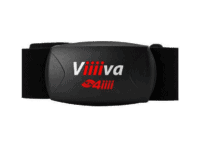 | 4iiii Viiiiva ANT+ to Bluetooth Smart HR Strap & Bridge $79.00 | $79.00 | Amazon |
| Polar H6 Heart Rate Strap (Bluetooth Smart Only) $58.00 | $58.00 | Amazon | |
| Polar H7 Heart Rate Strap (Gym equipment + Bluetooth Smart) $60.00 | $60.00 | Amazon | |
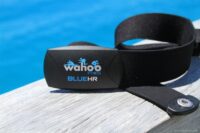 | Wahoo Blue HR - Bluetooth Smart Heart Rate Strap $69 | $69 | Amazon |
Thanks for reading! And as always, feel free to post comments or questions in the comments section below, I’ll be happy to try and answer them as quickly as possible.


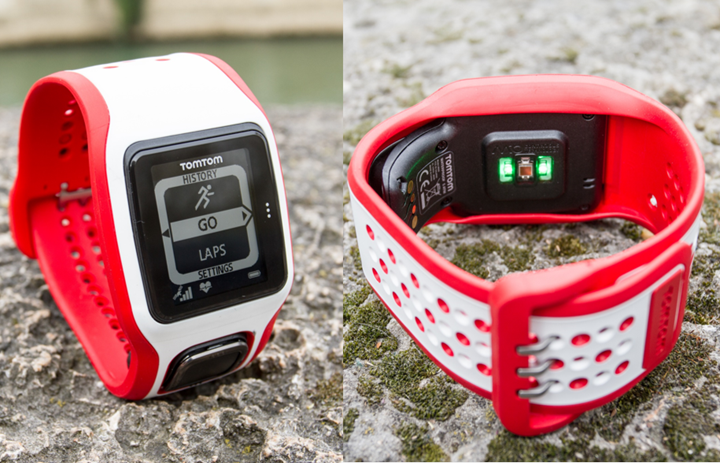
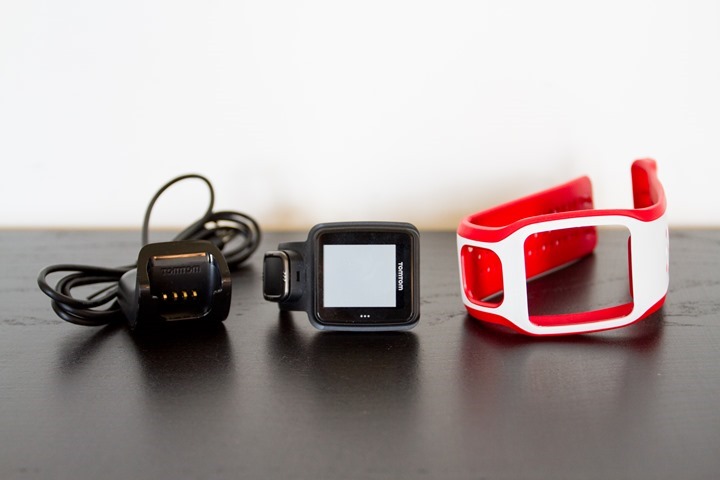
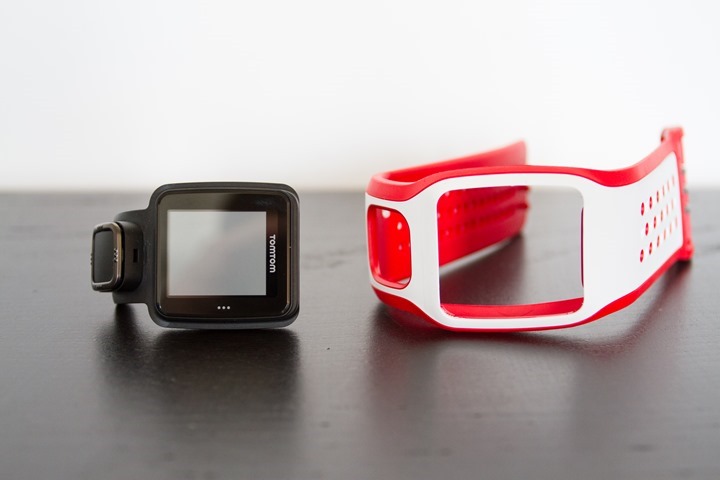
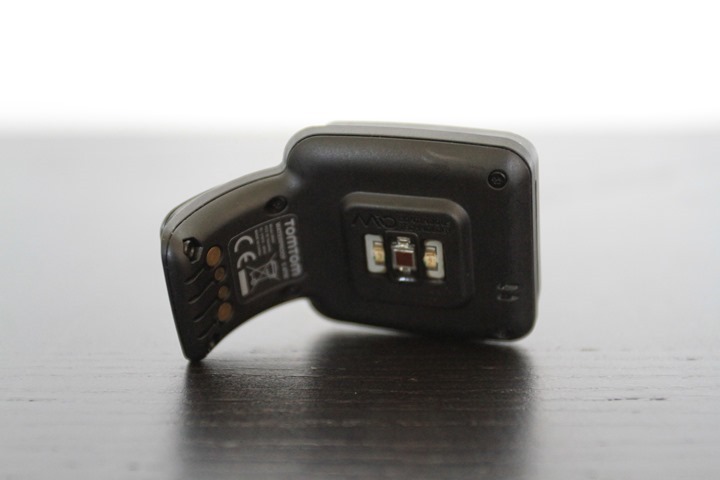
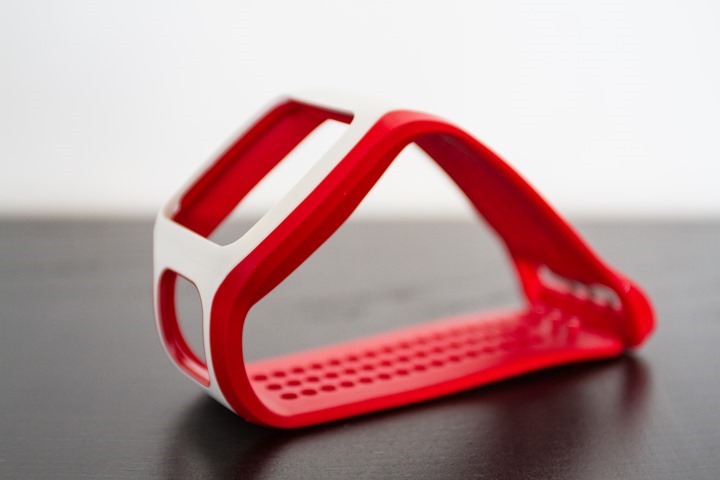
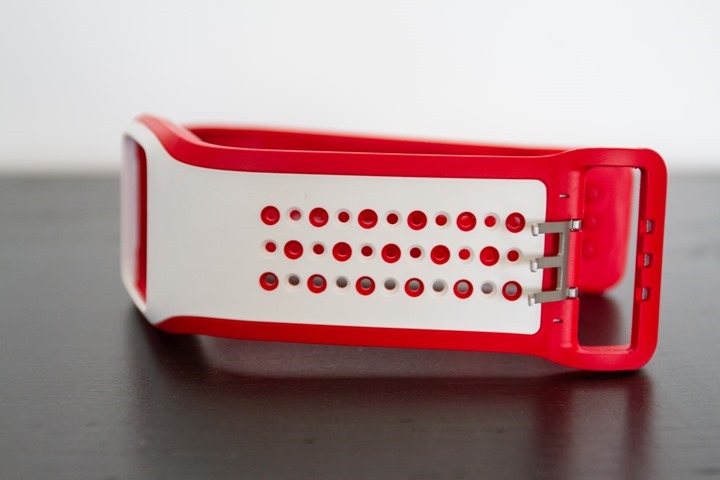
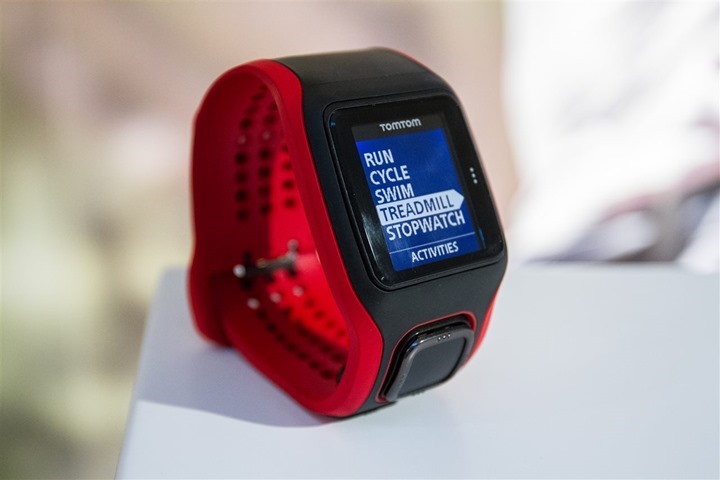
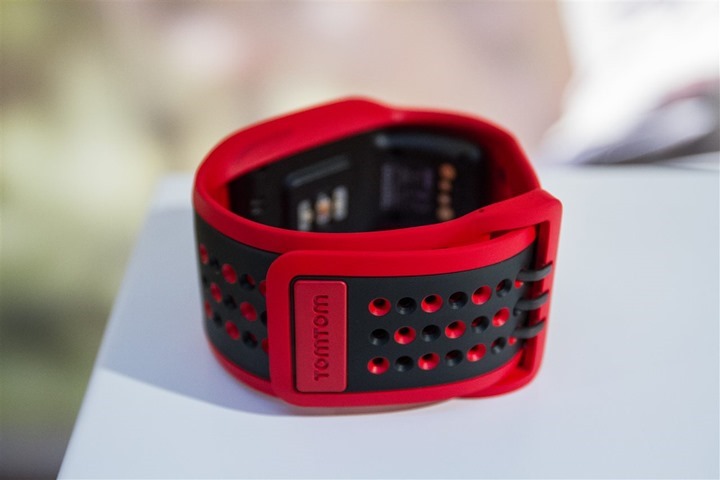
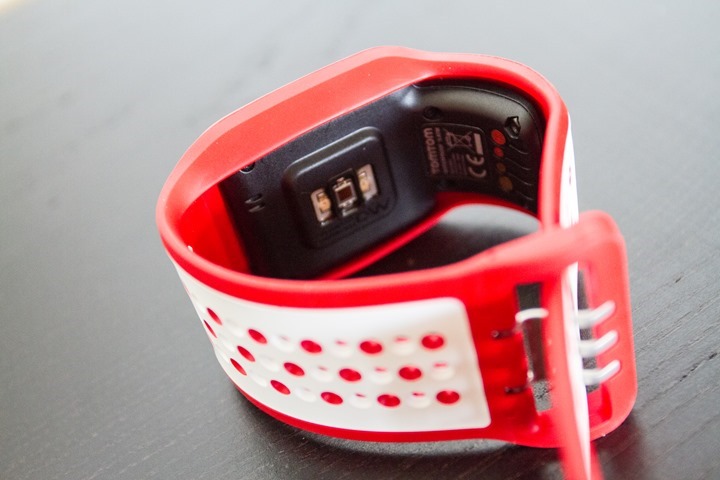
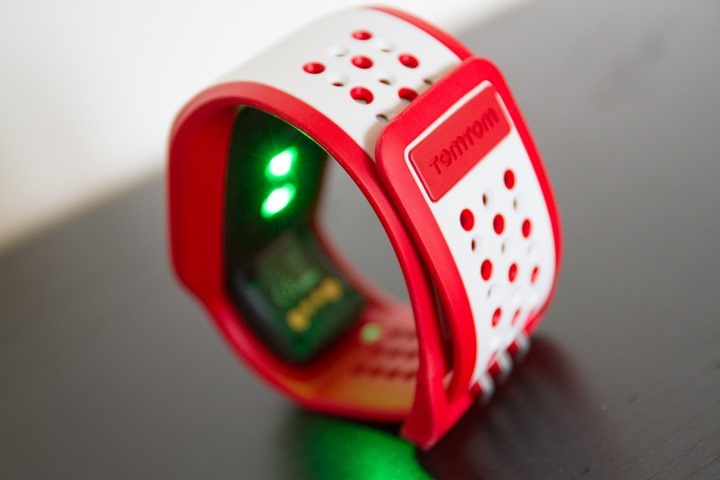
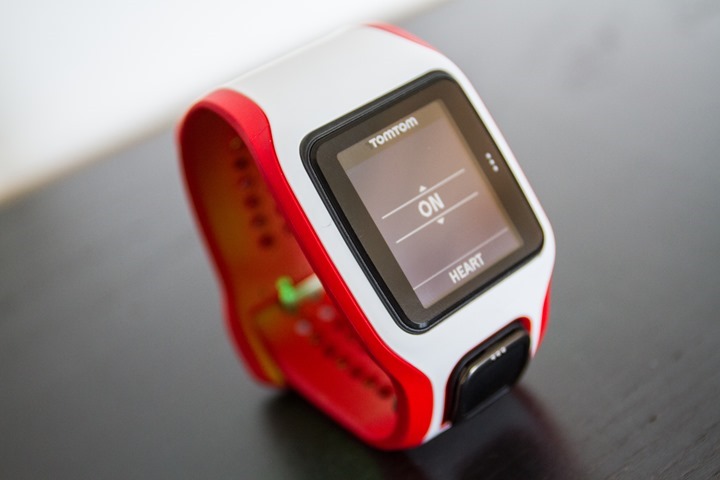
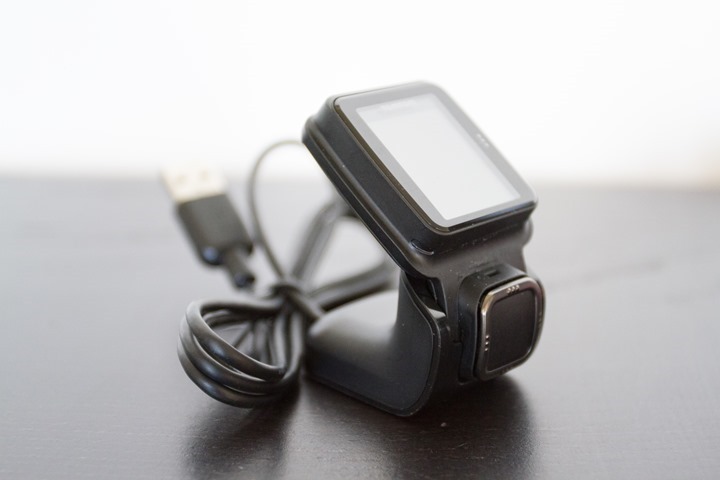
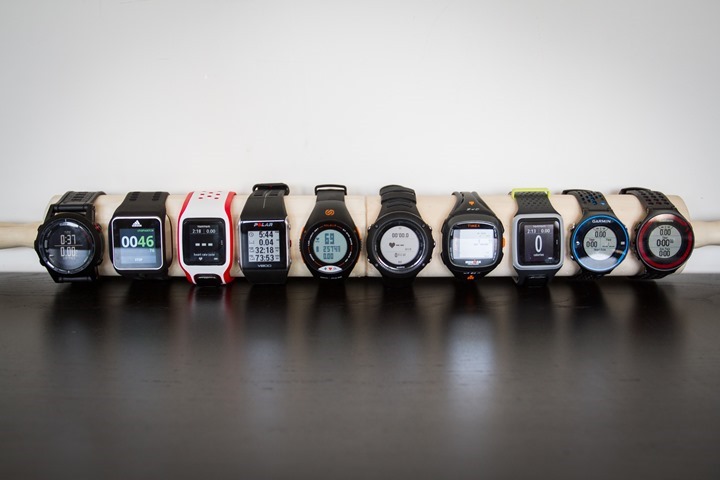
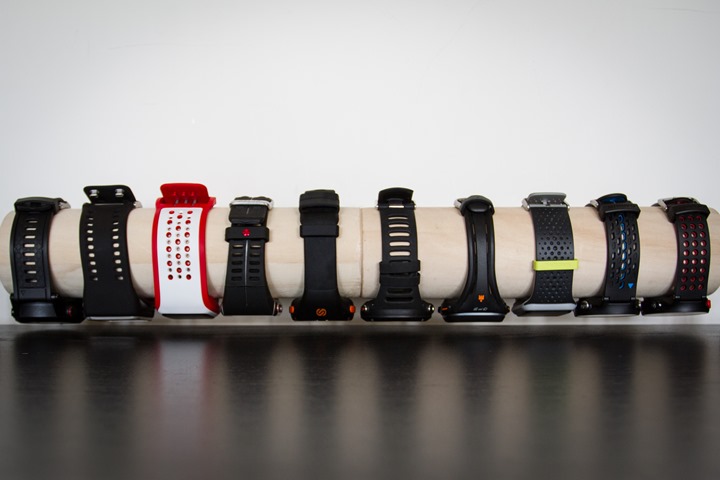
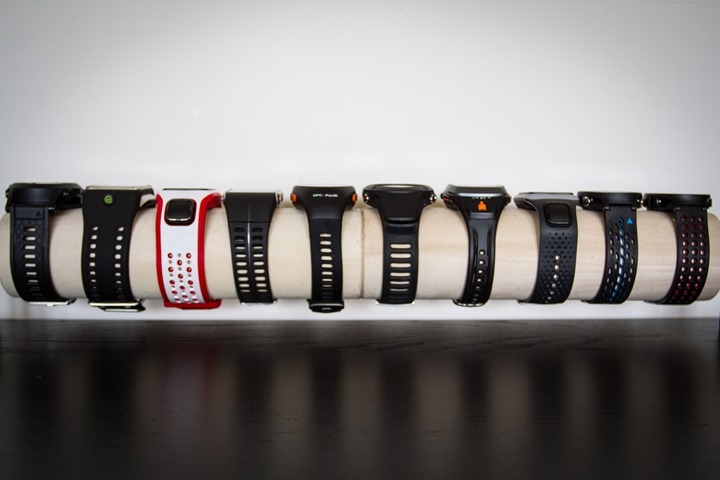
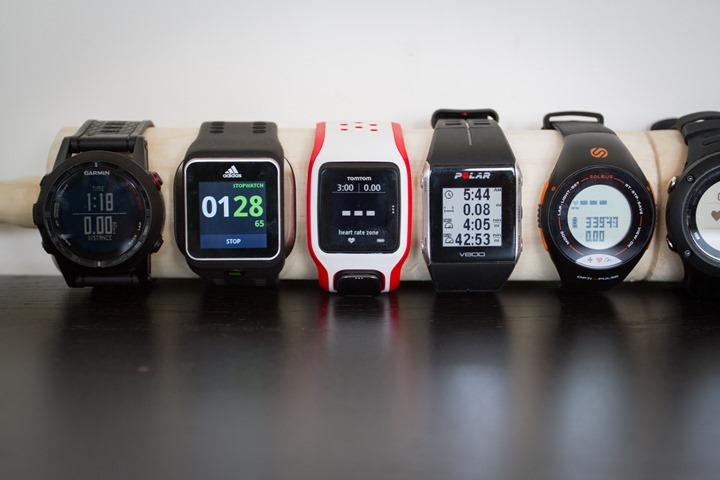
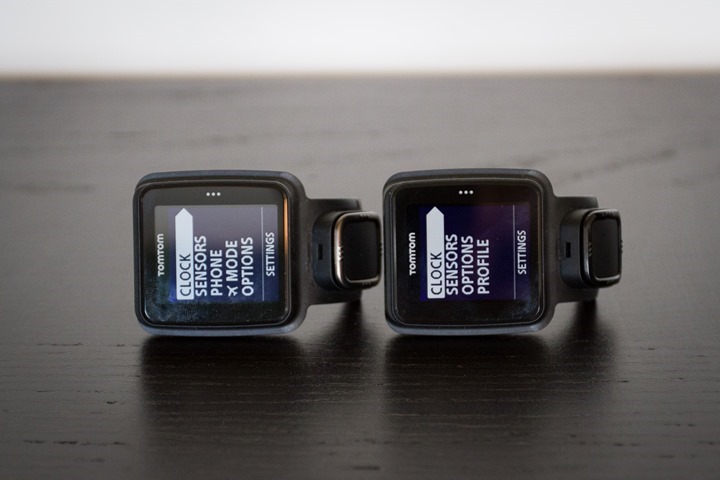
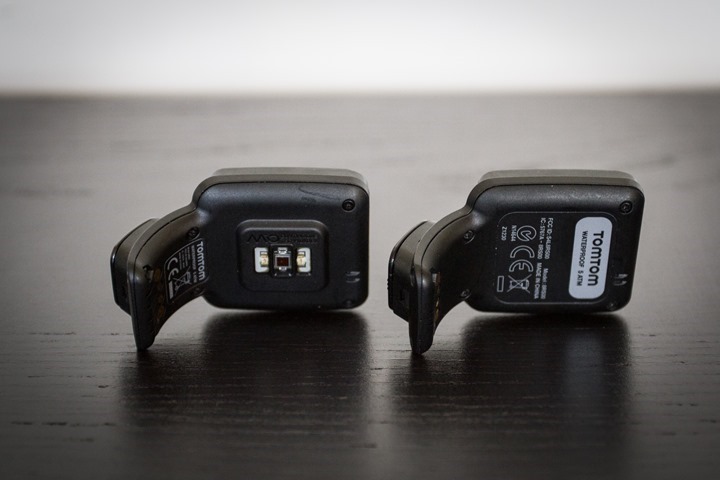
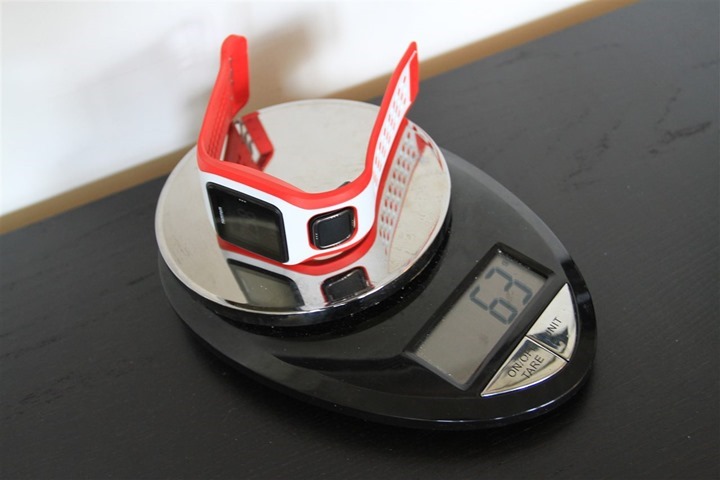
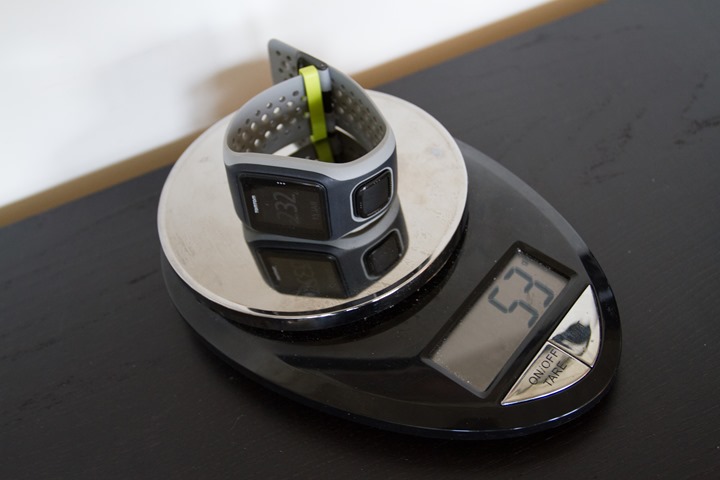
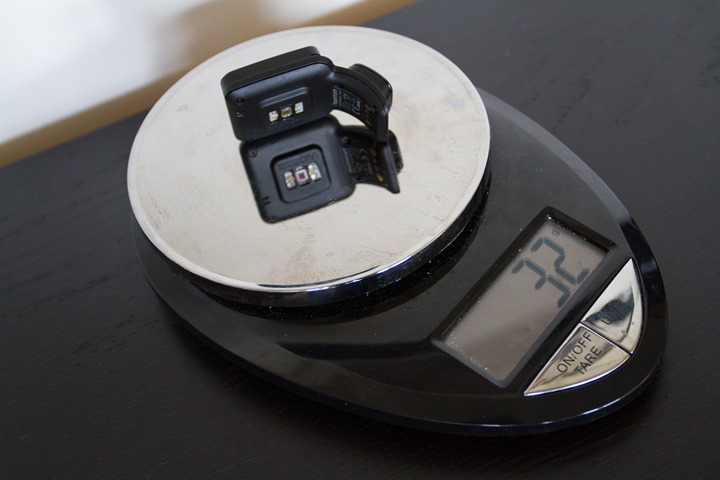
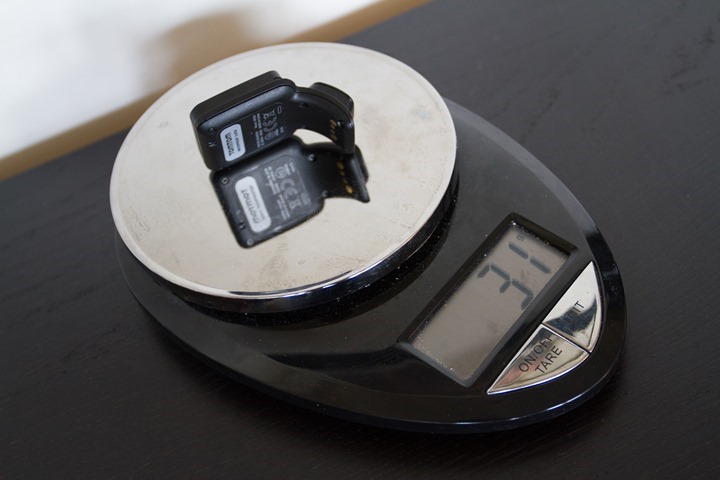
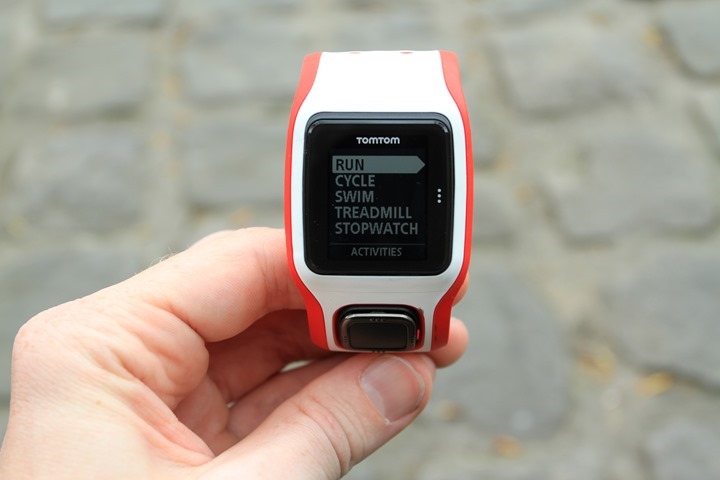
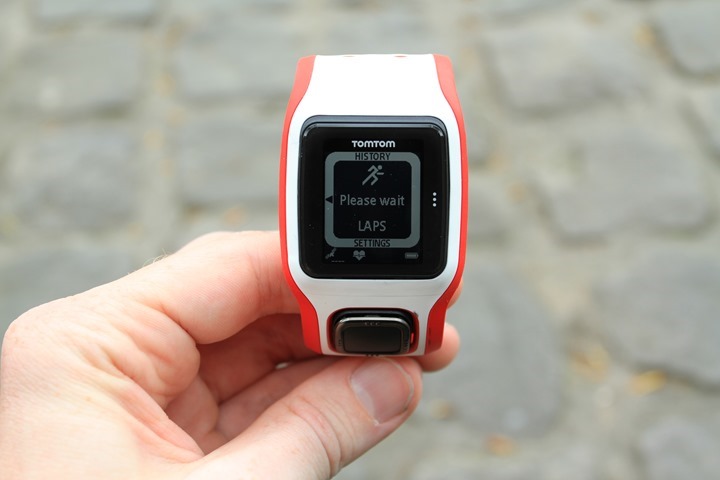
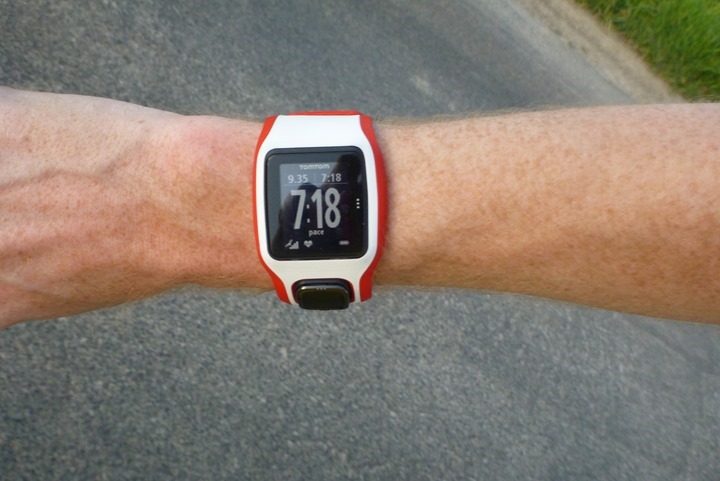
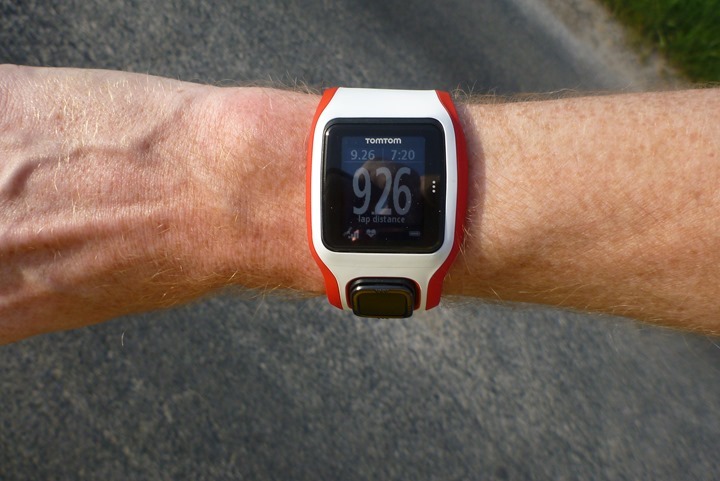
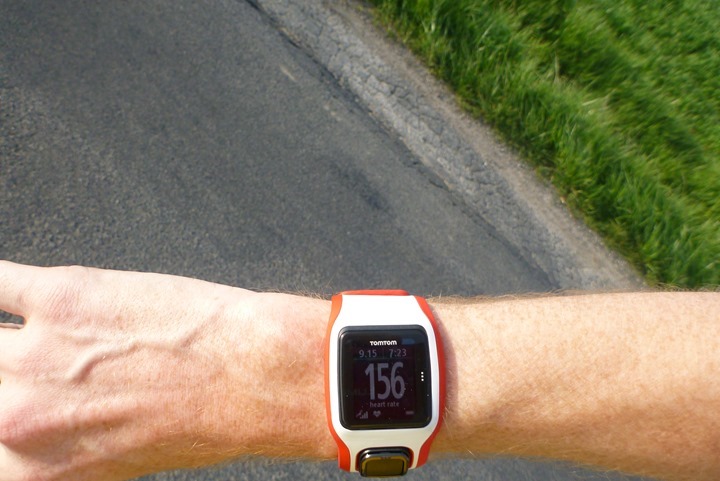
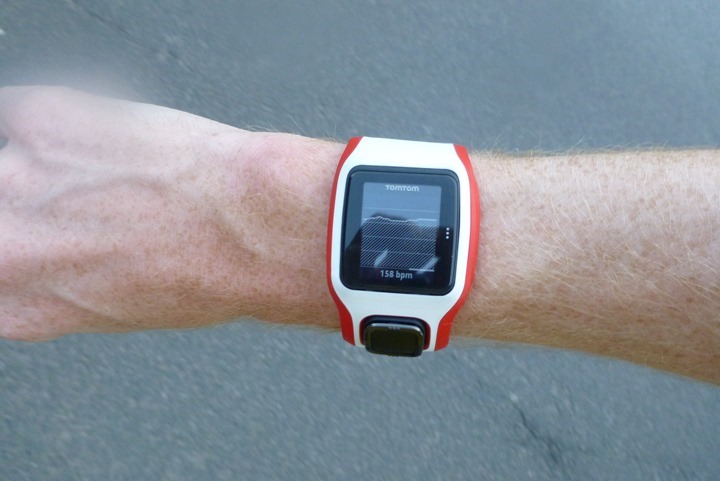
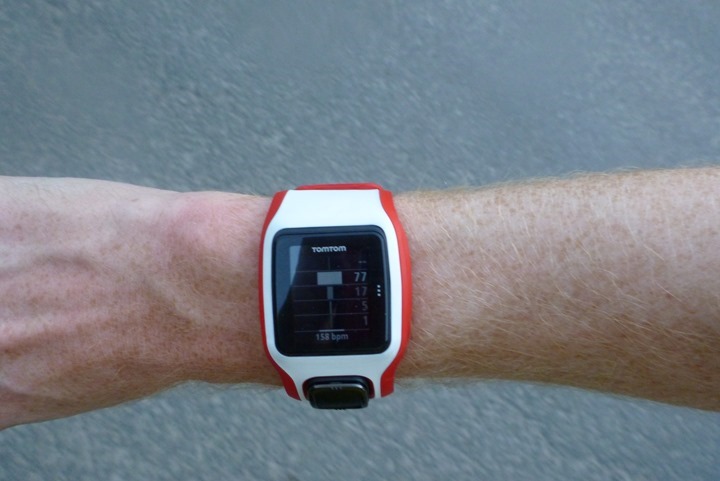
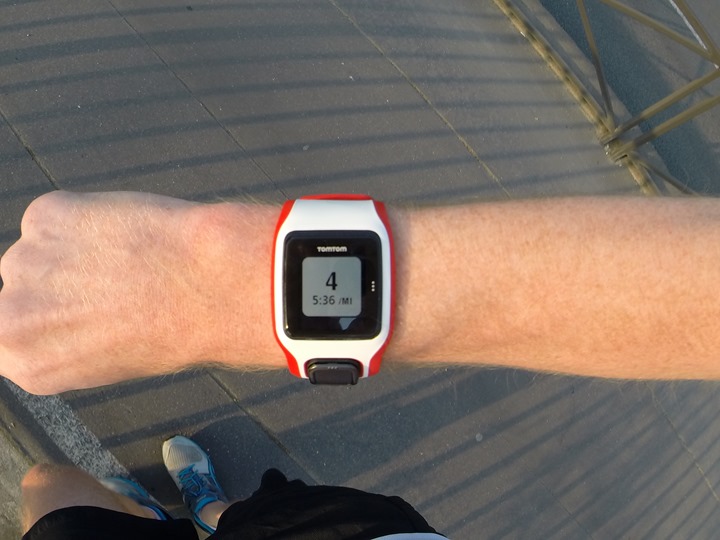
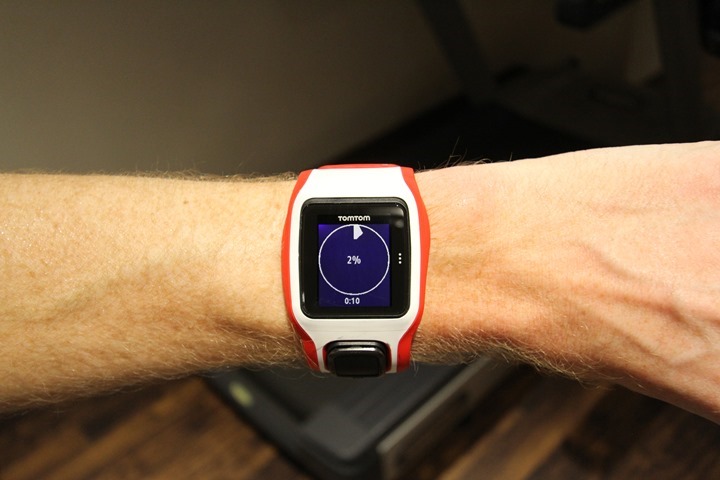
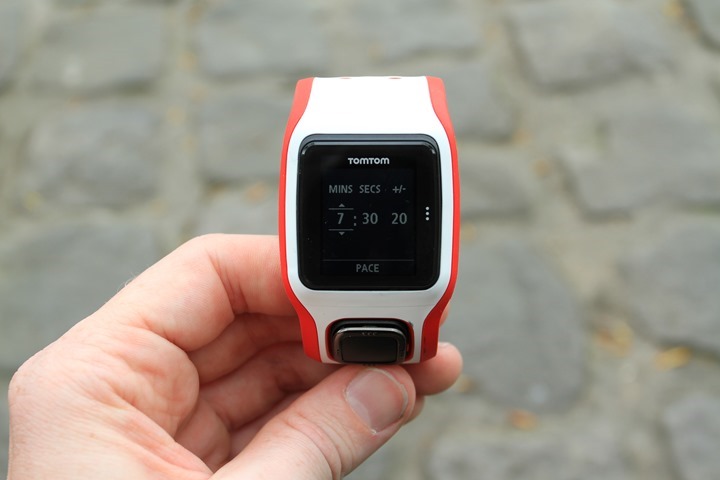
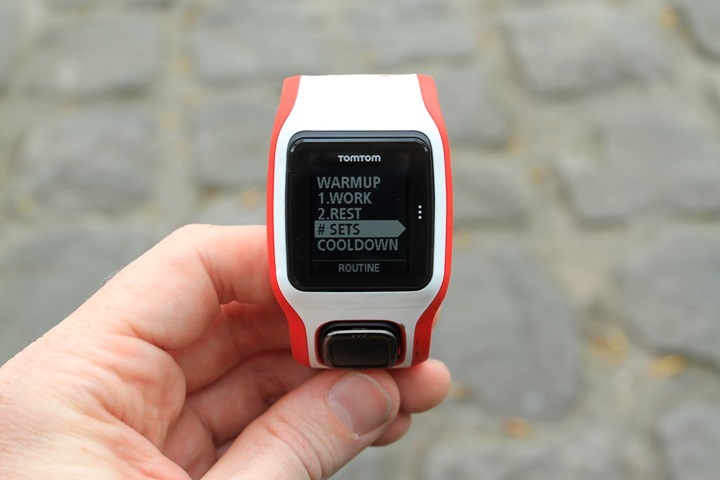
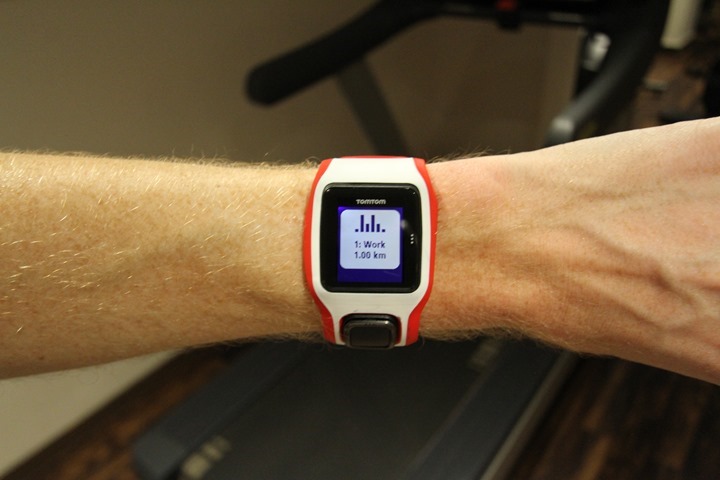
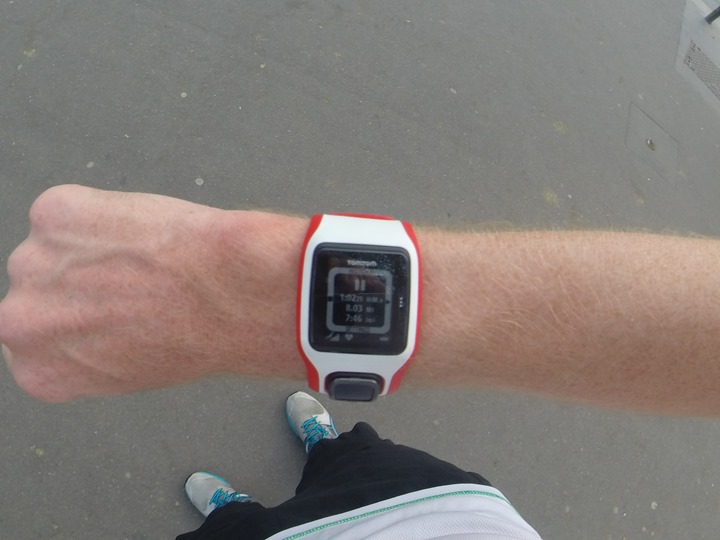
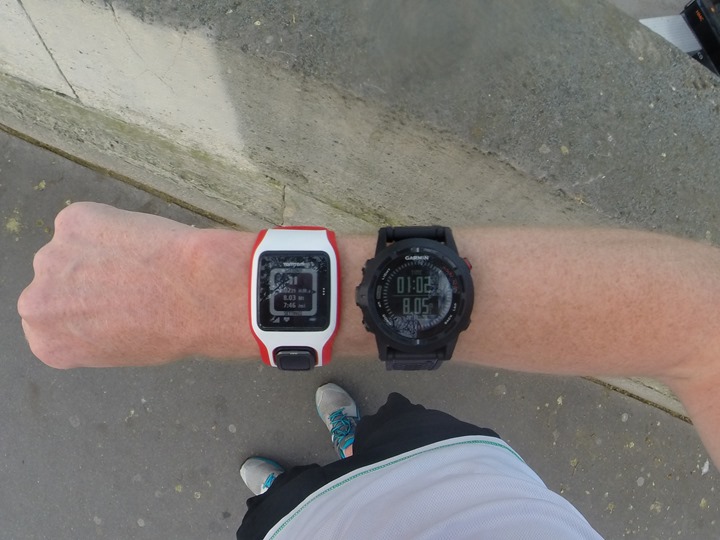
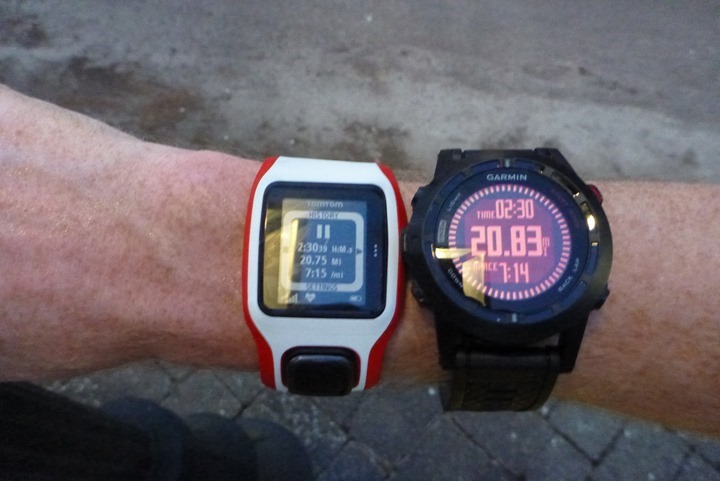
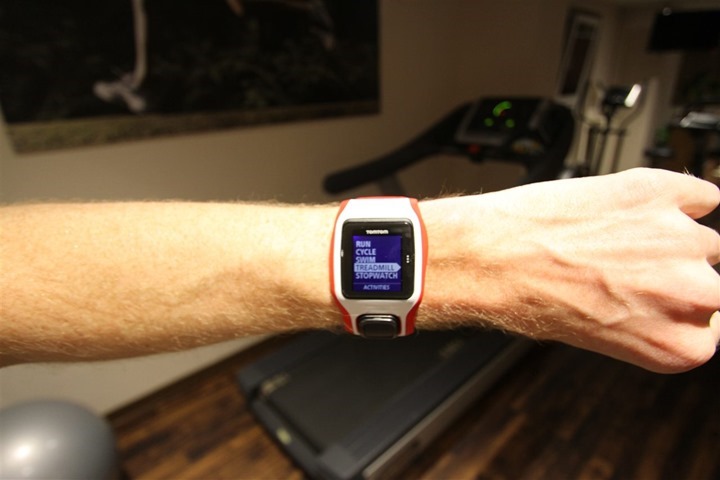
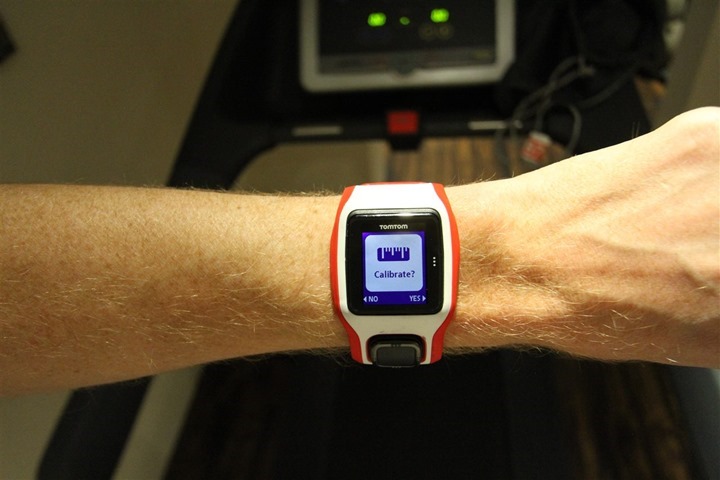
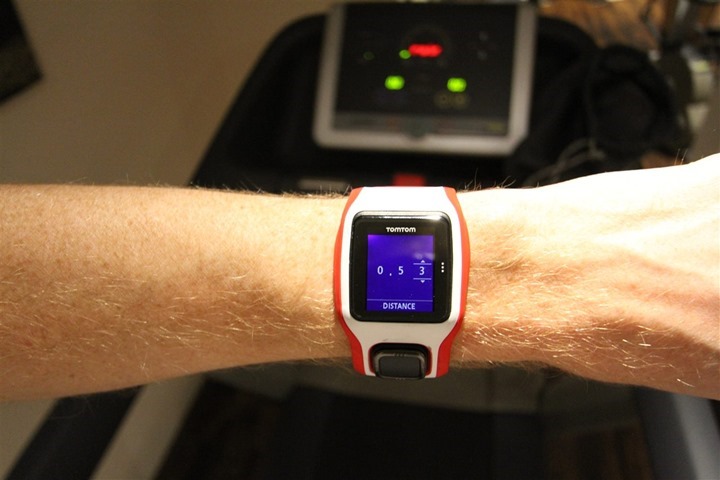


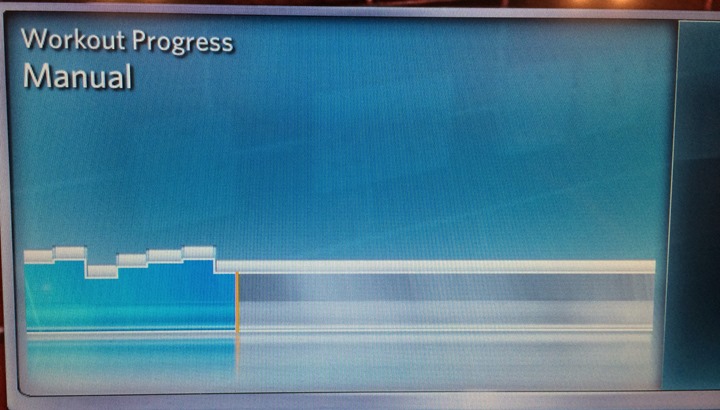
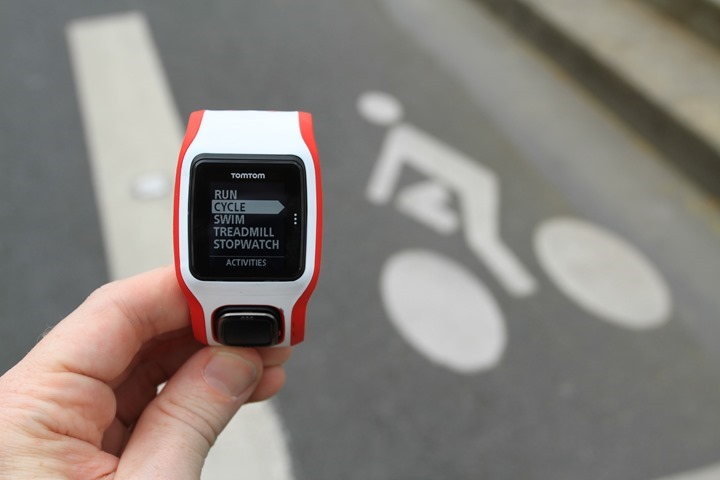
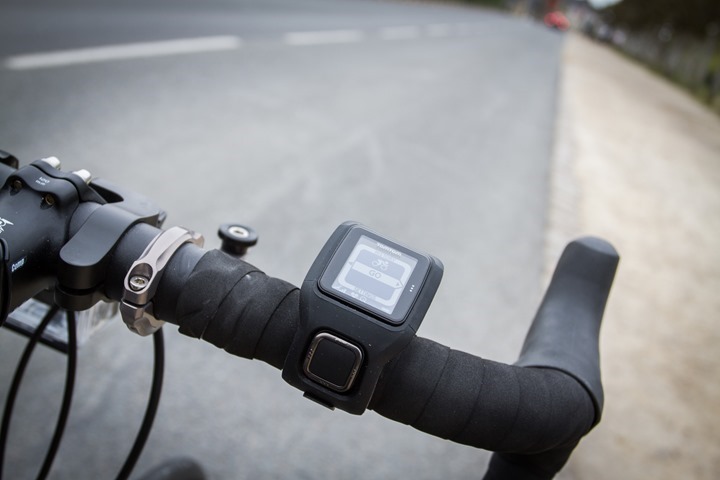
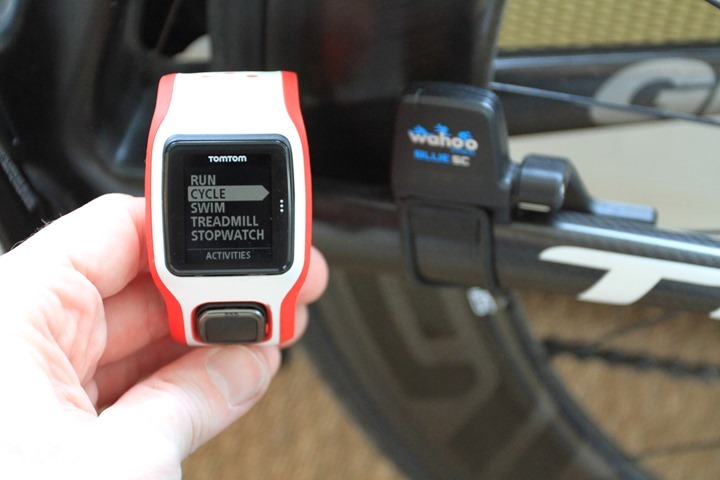
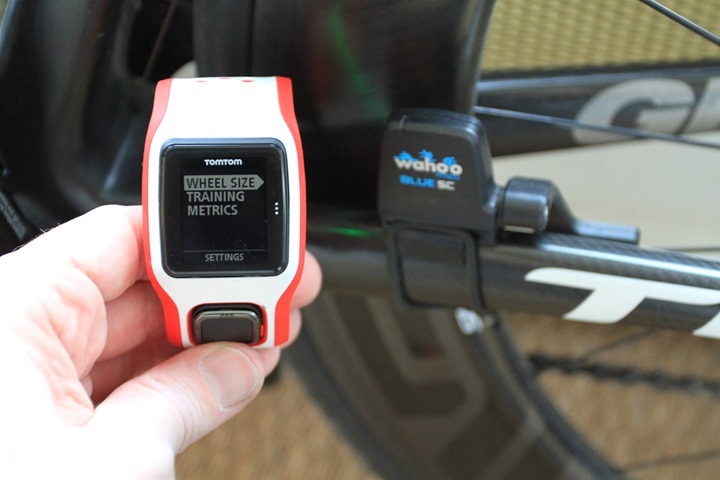

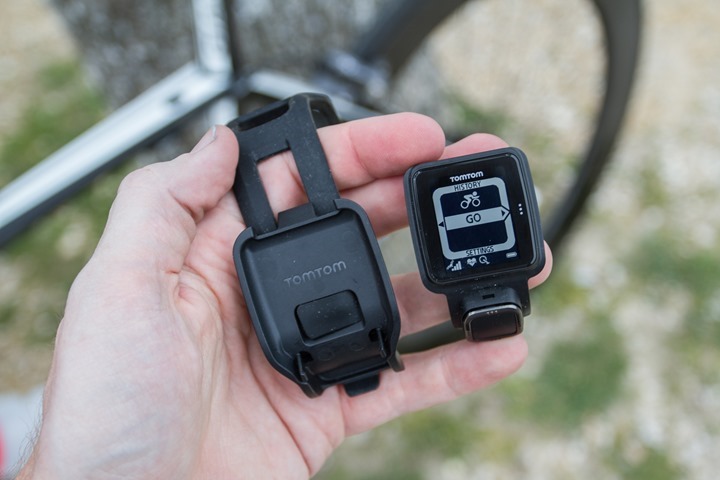
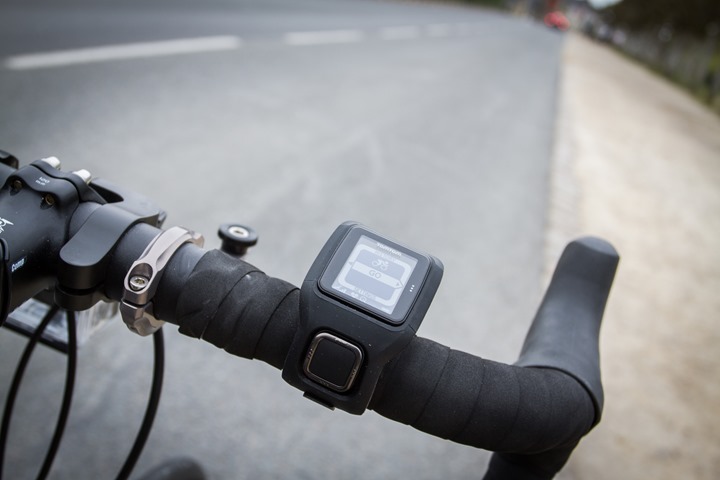

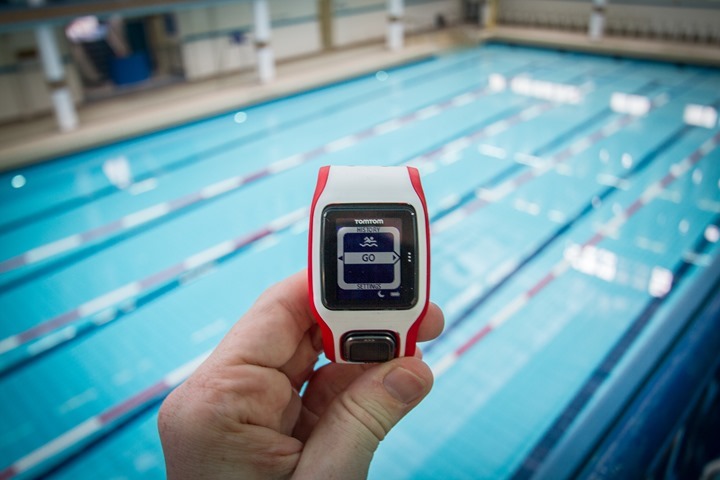
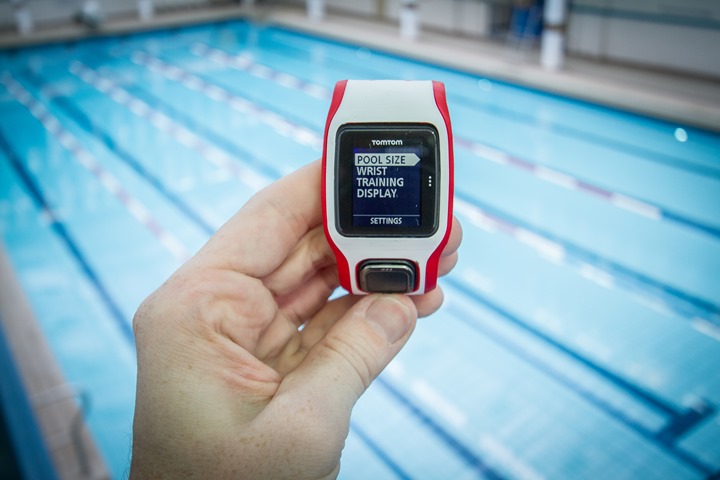
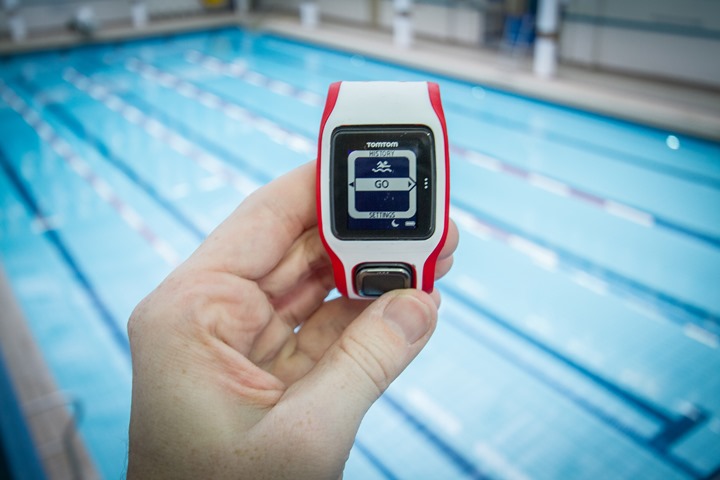
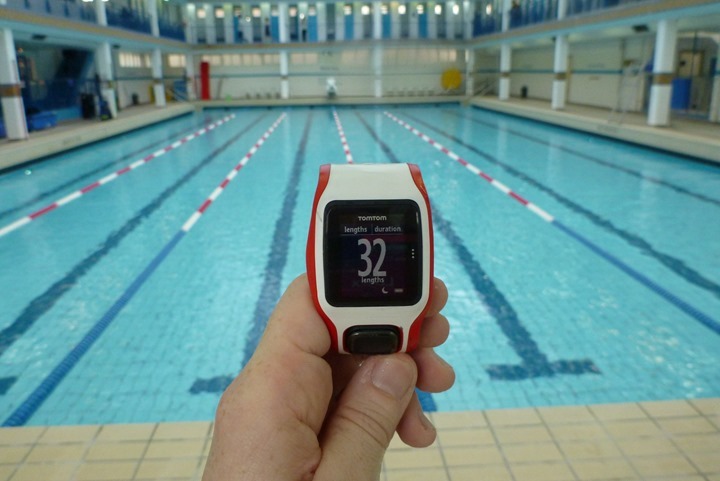
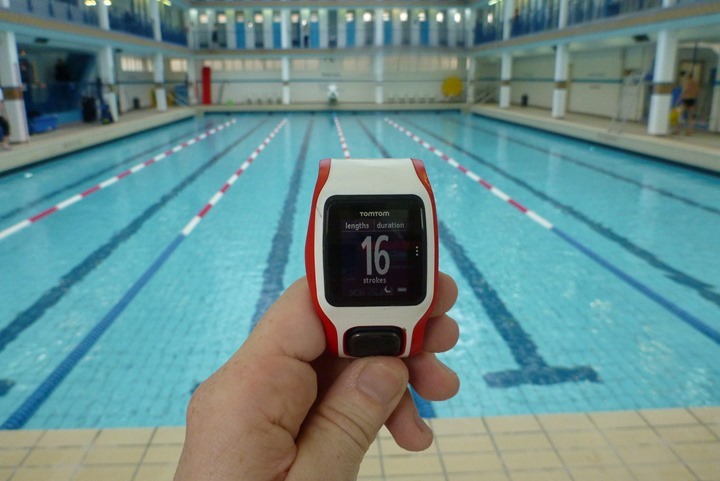
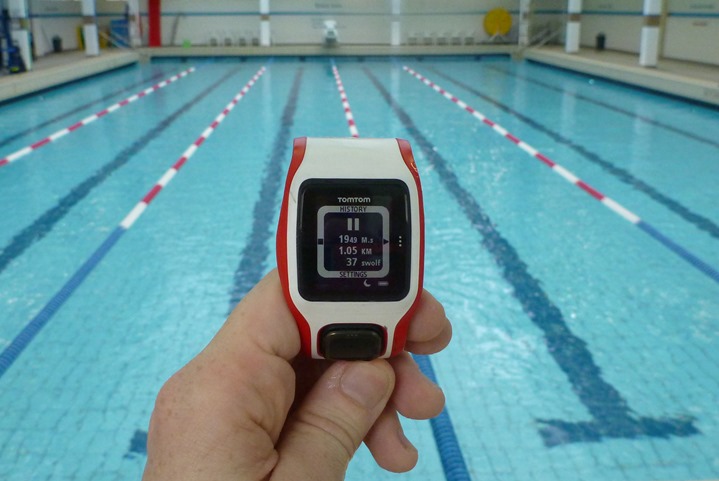
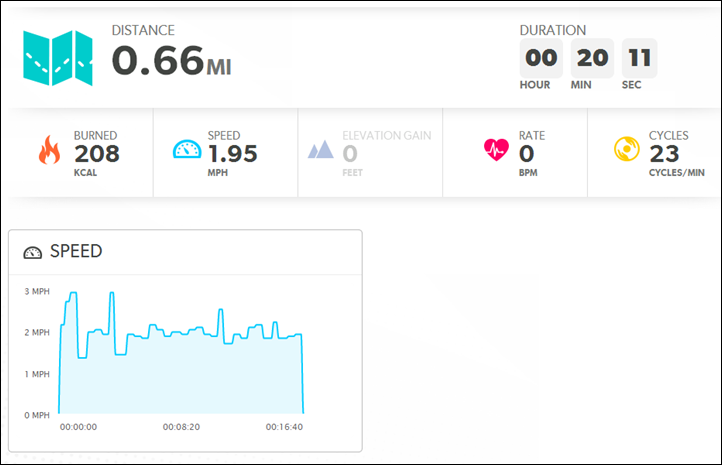
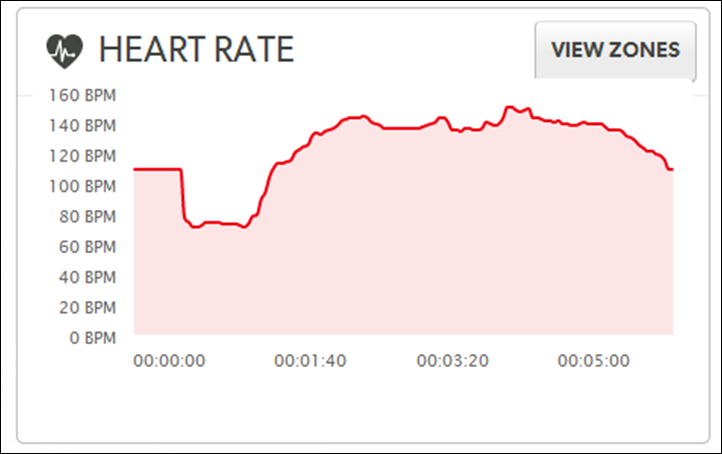
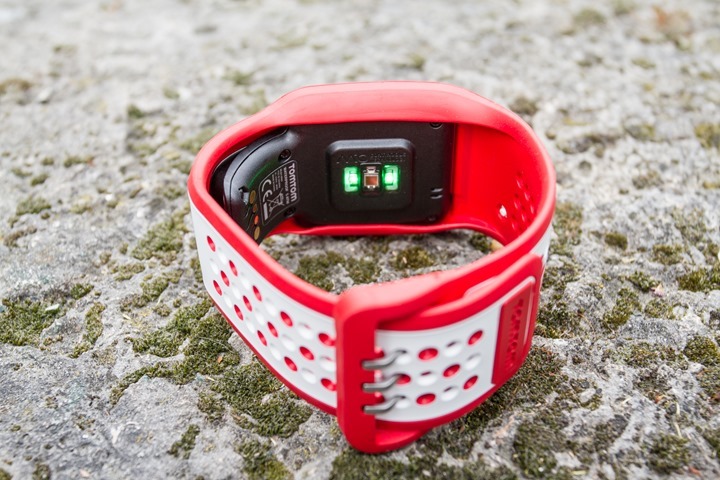
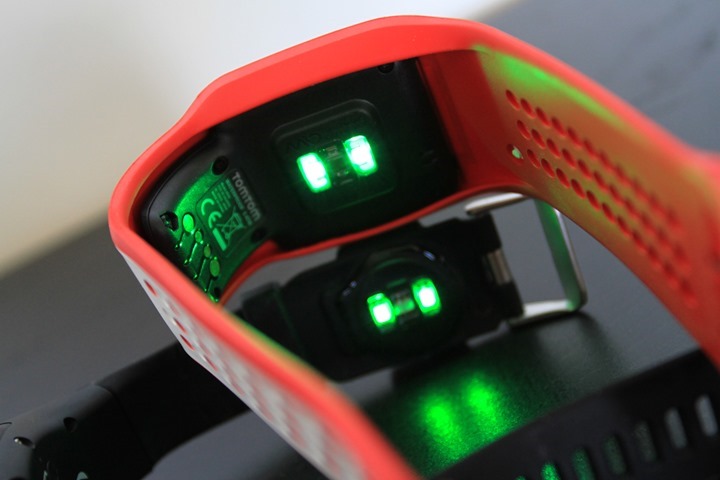
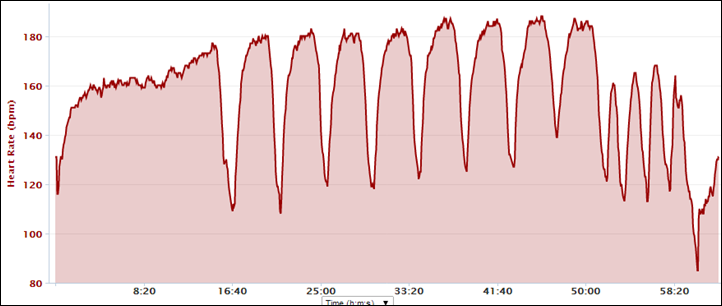
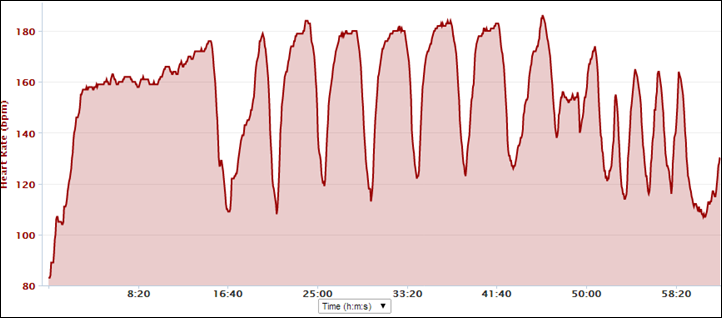
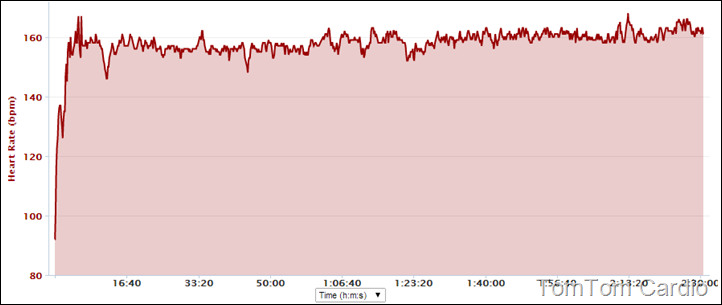
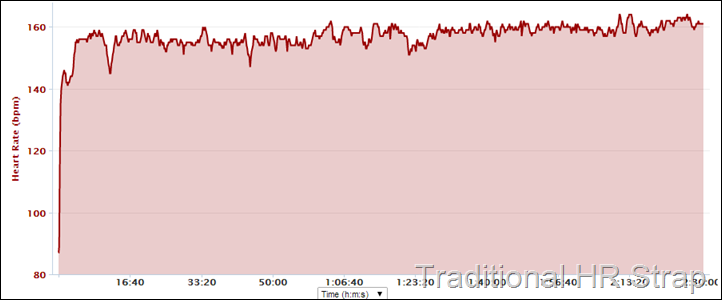
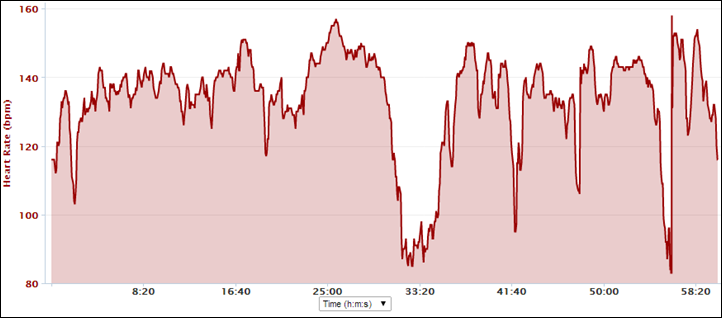
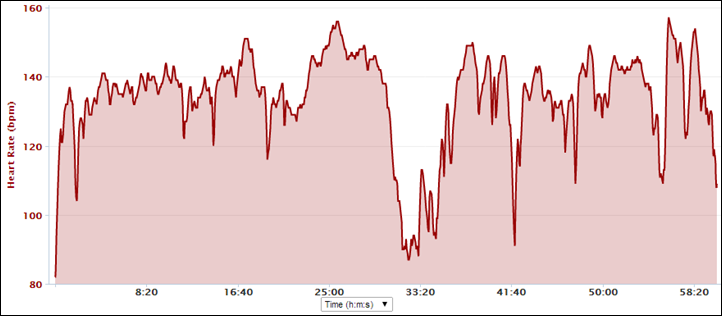
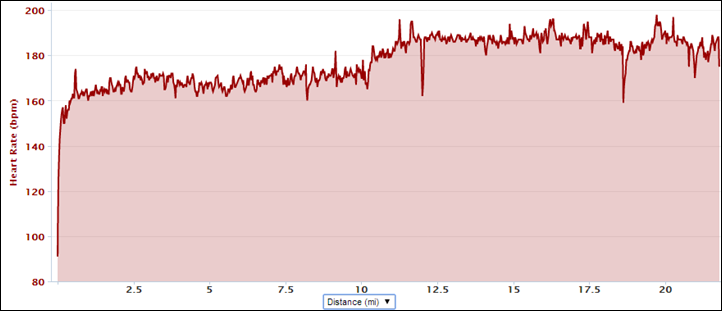
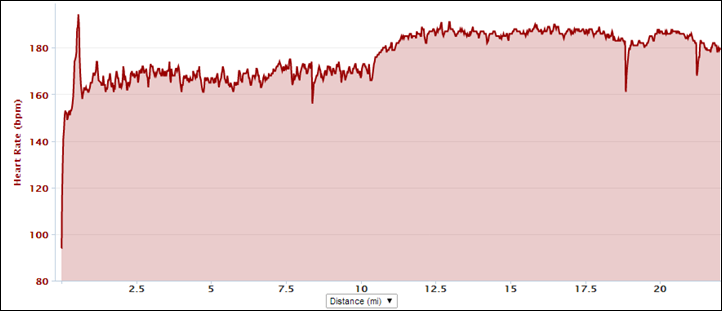
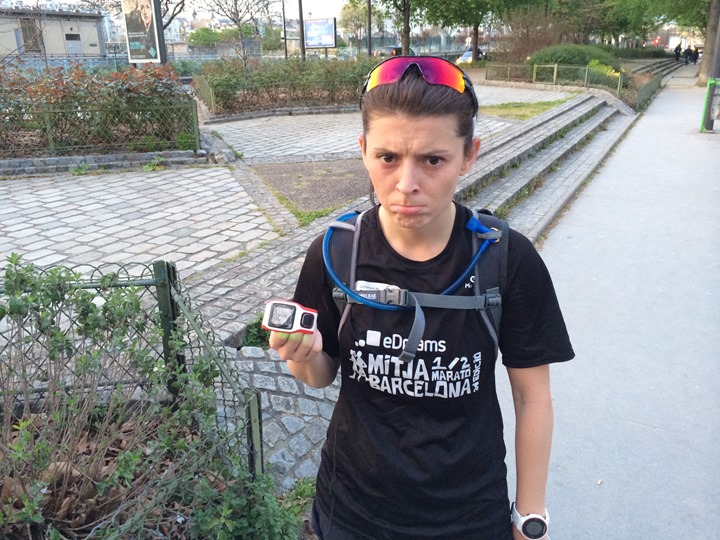
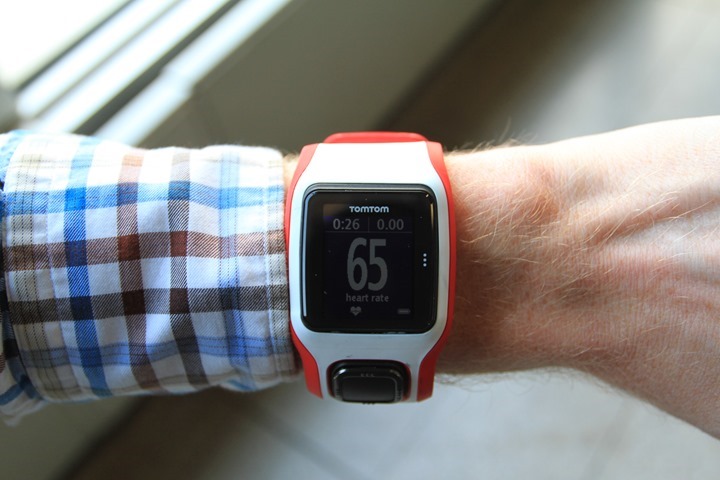
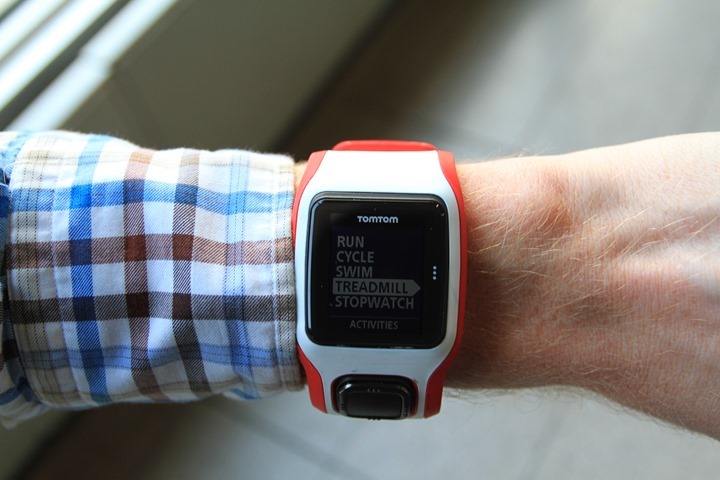
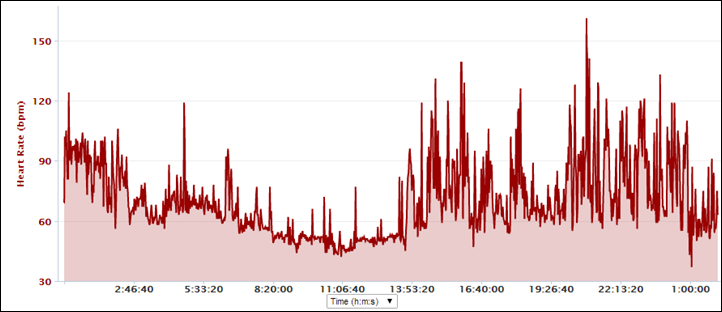
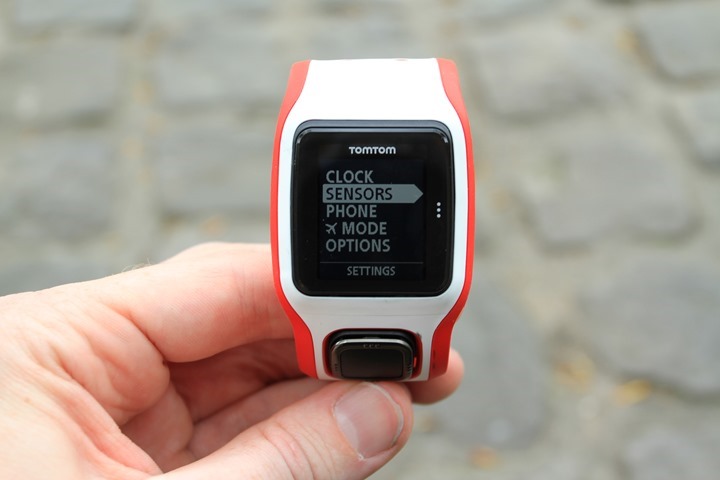
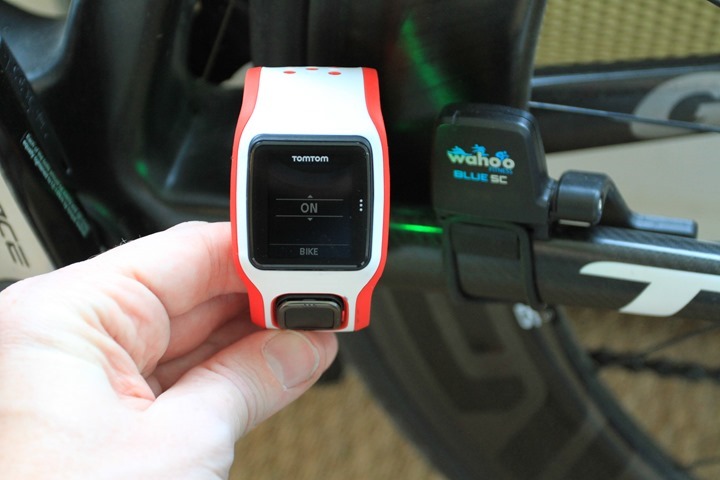
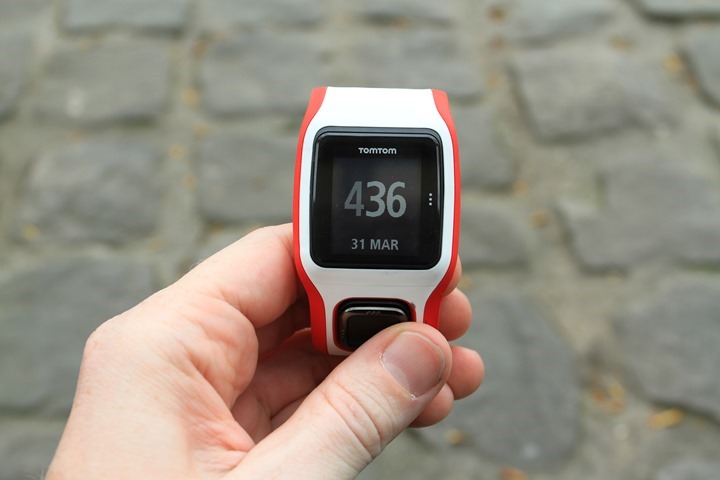
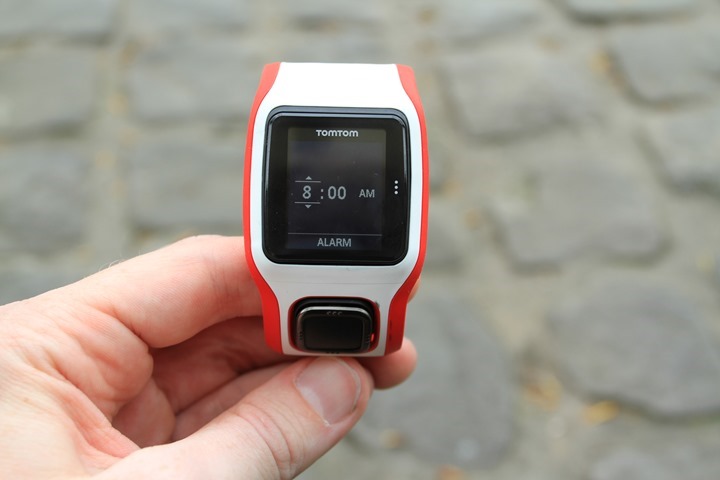
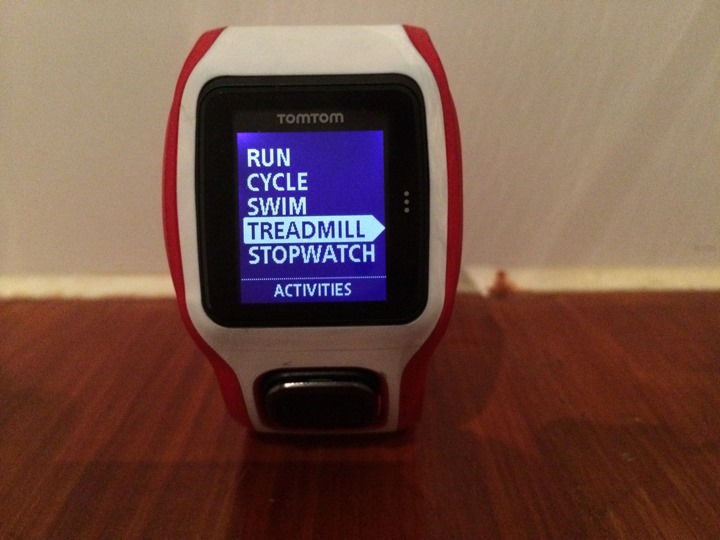
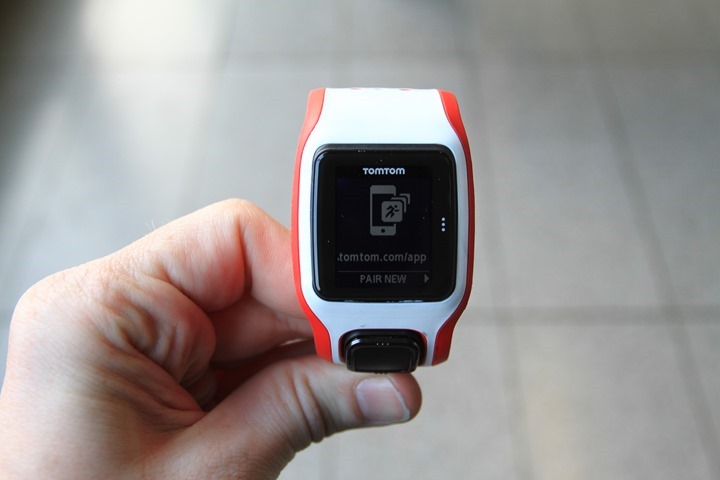
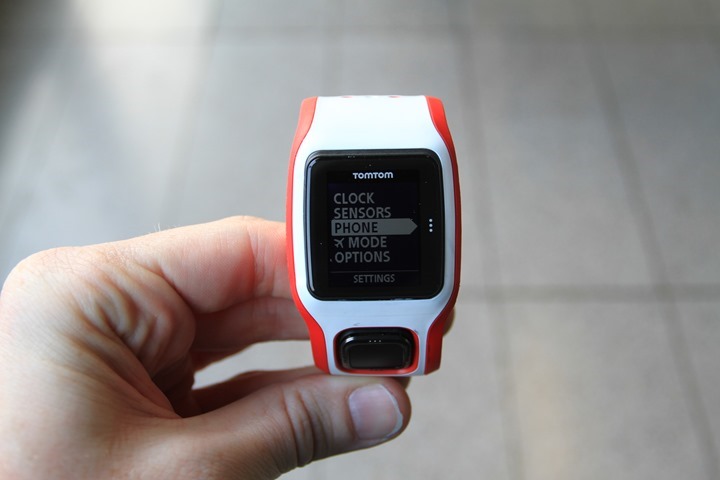
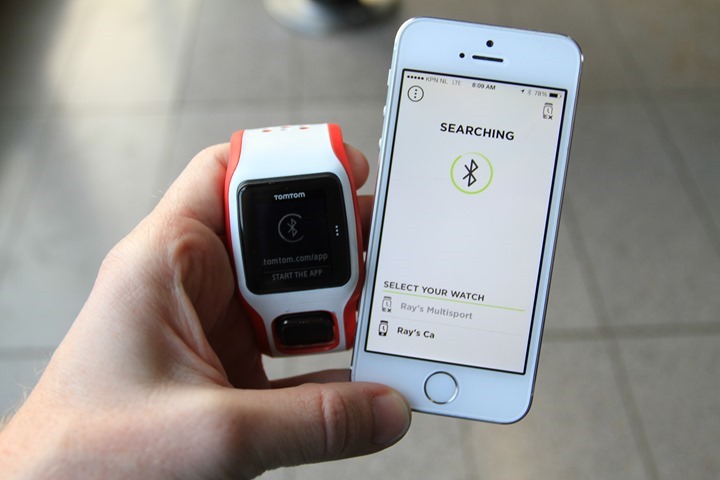
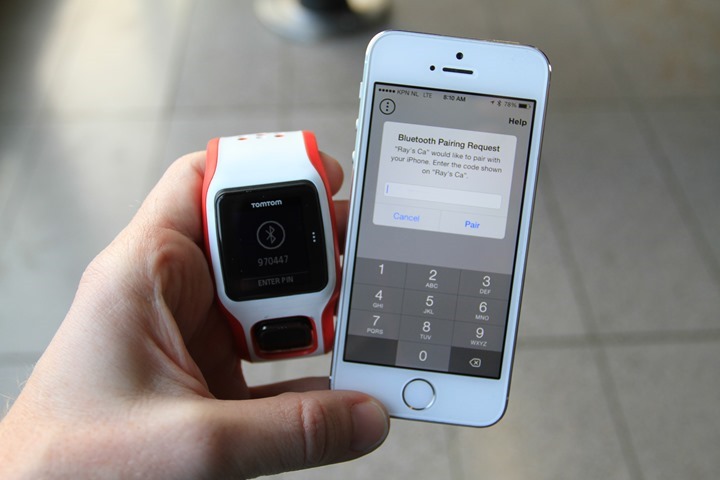
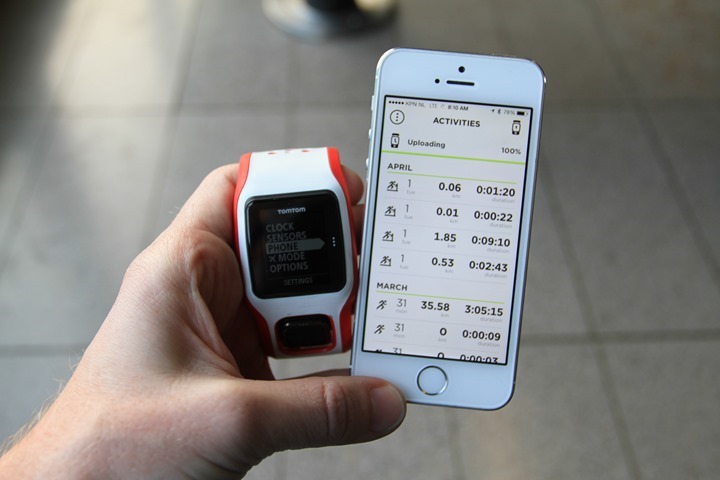
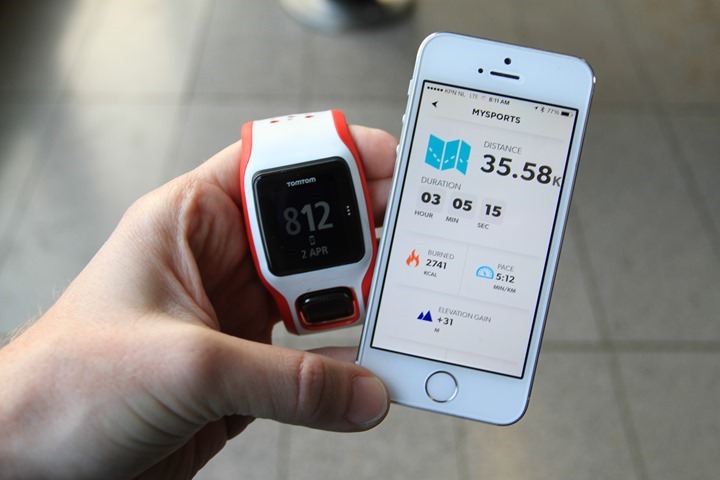
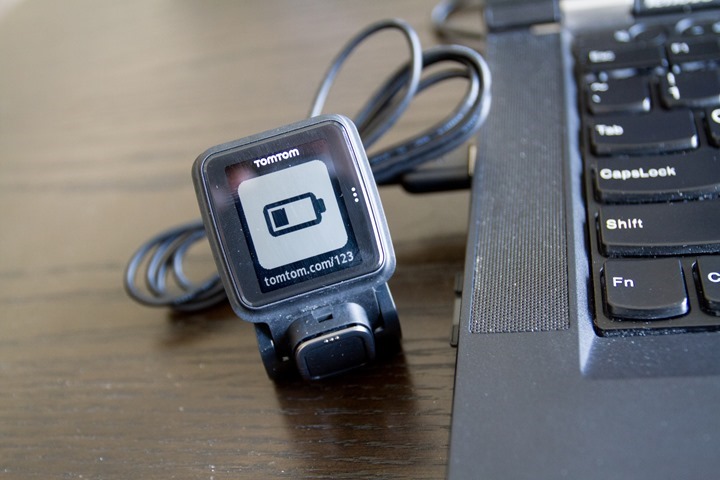
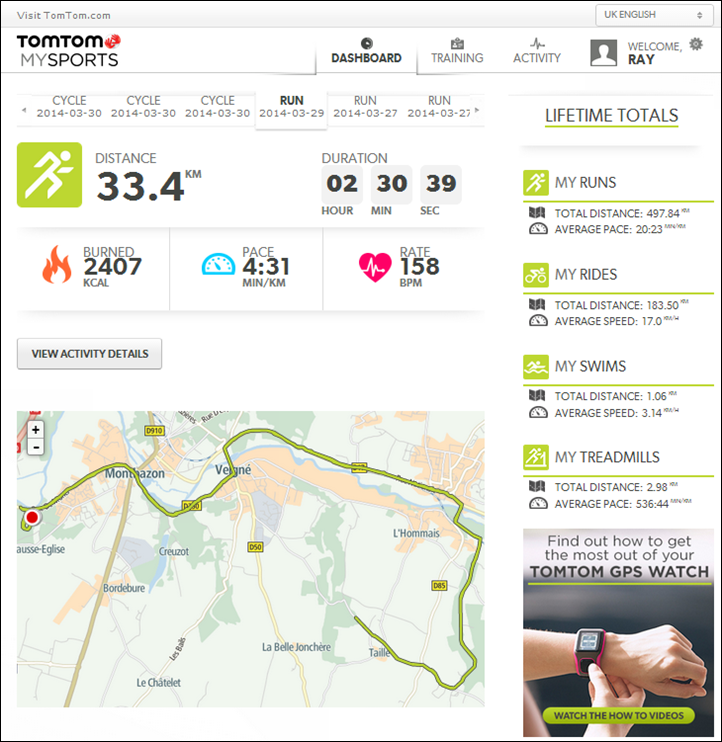
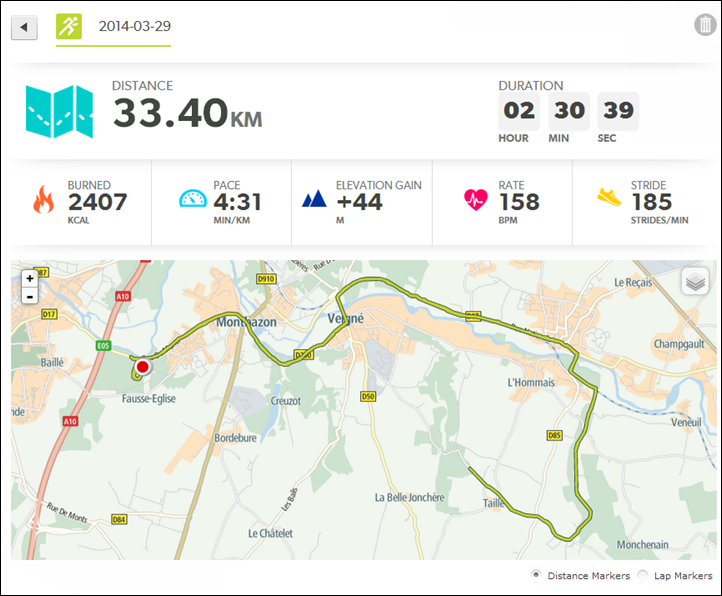
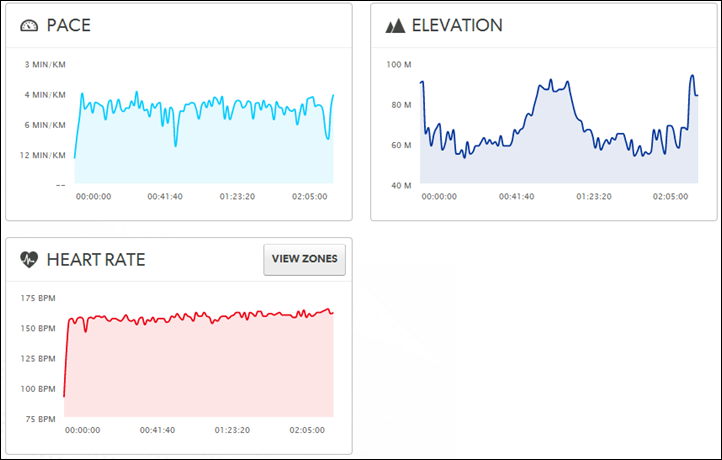
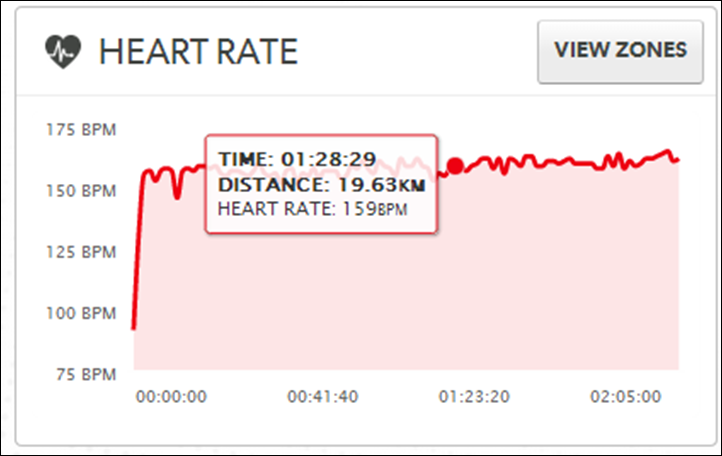
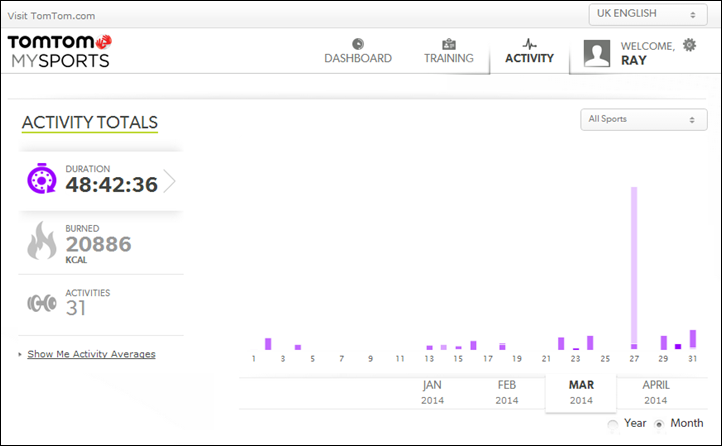
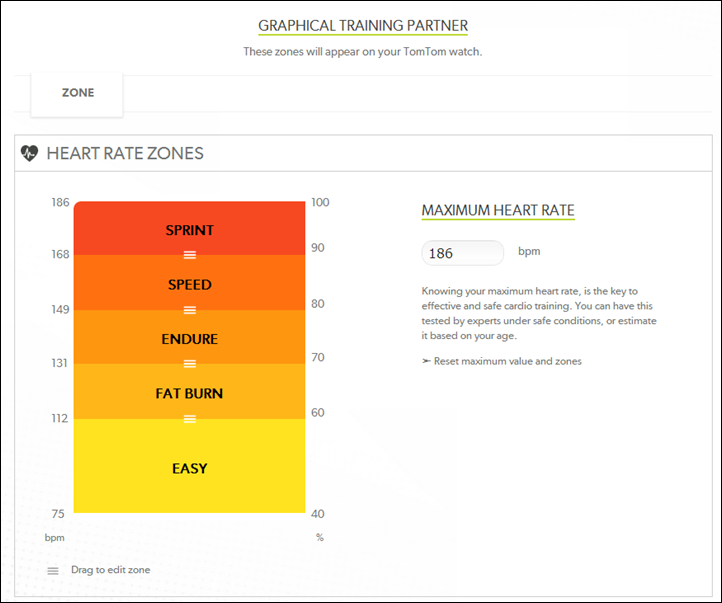
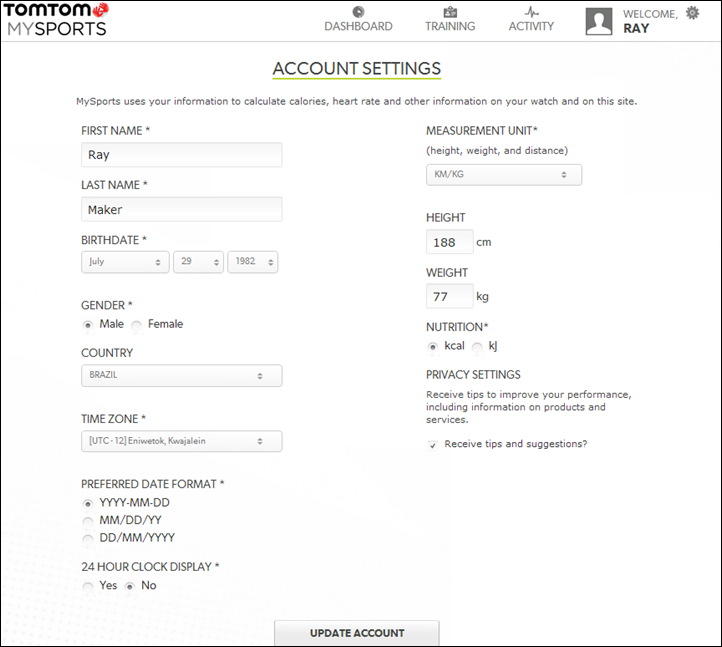
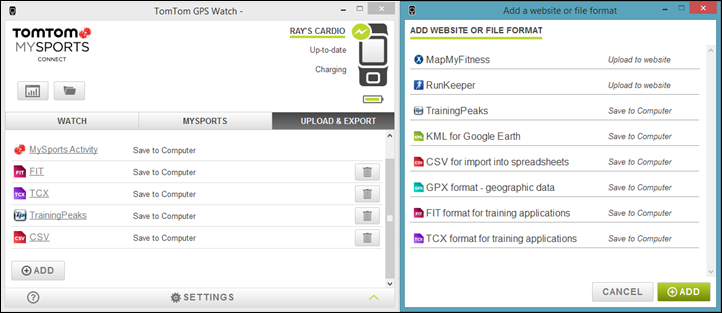
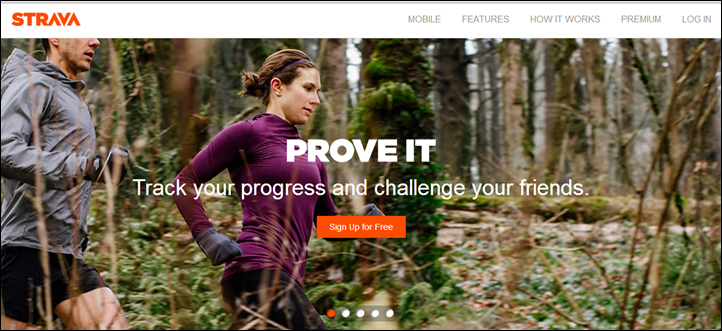
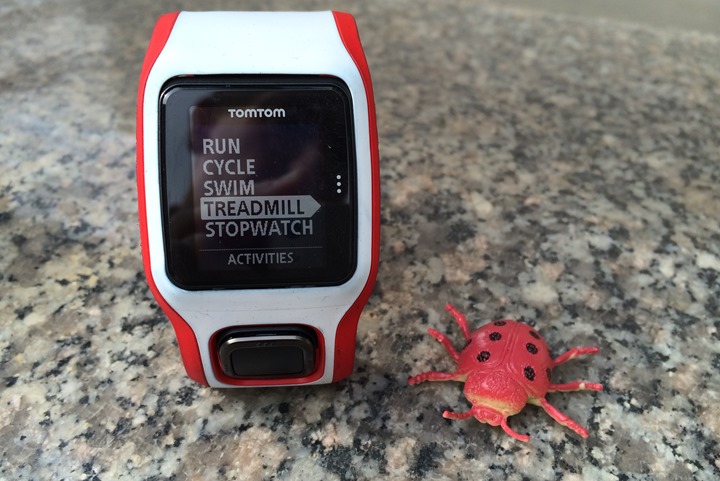
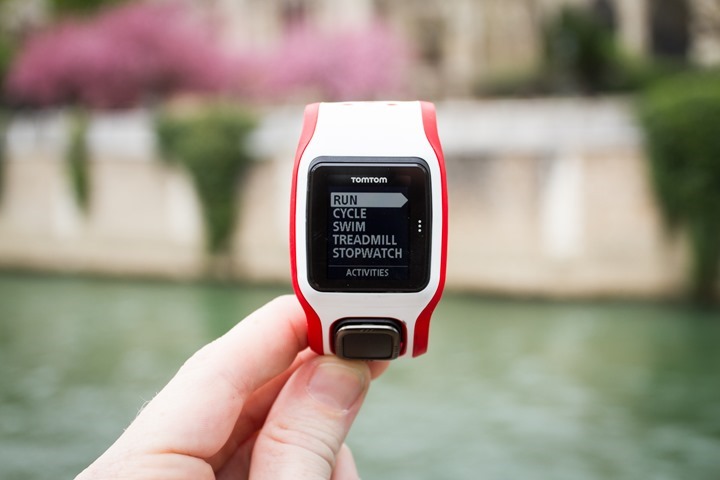



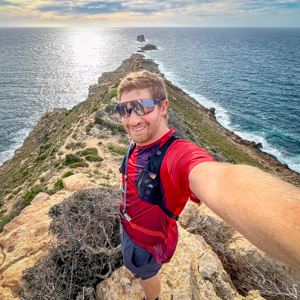





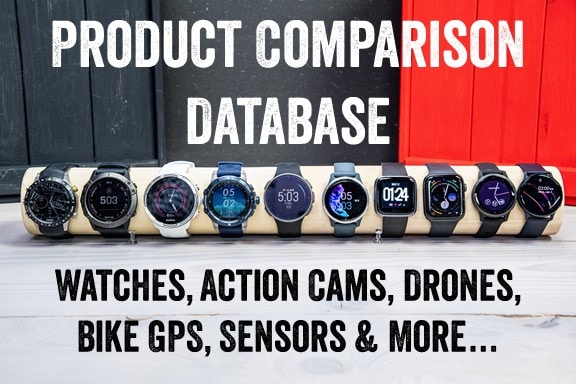
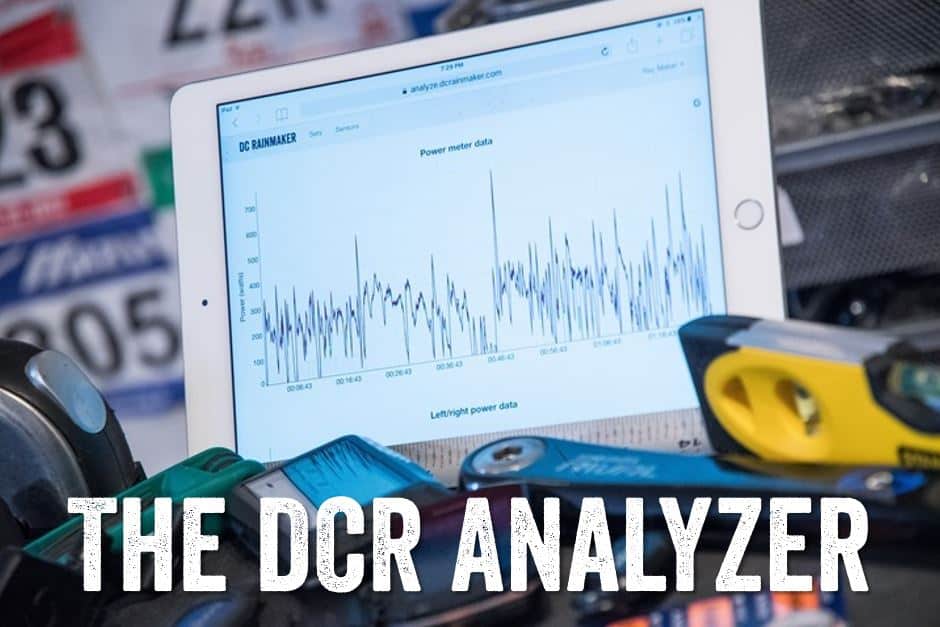
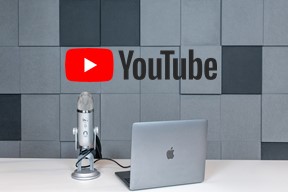
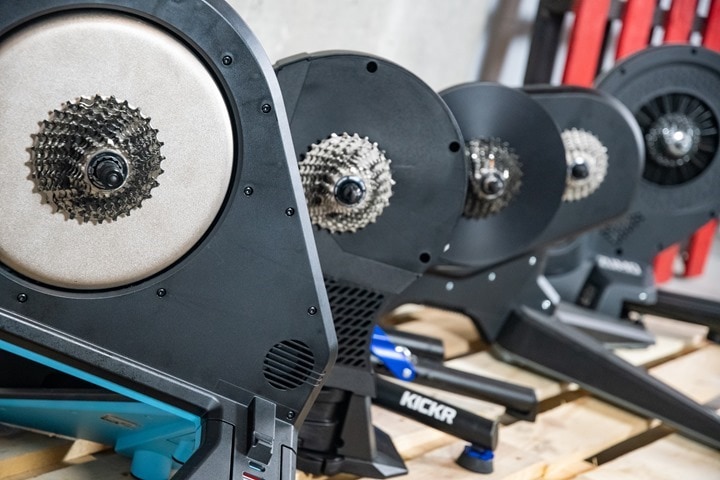
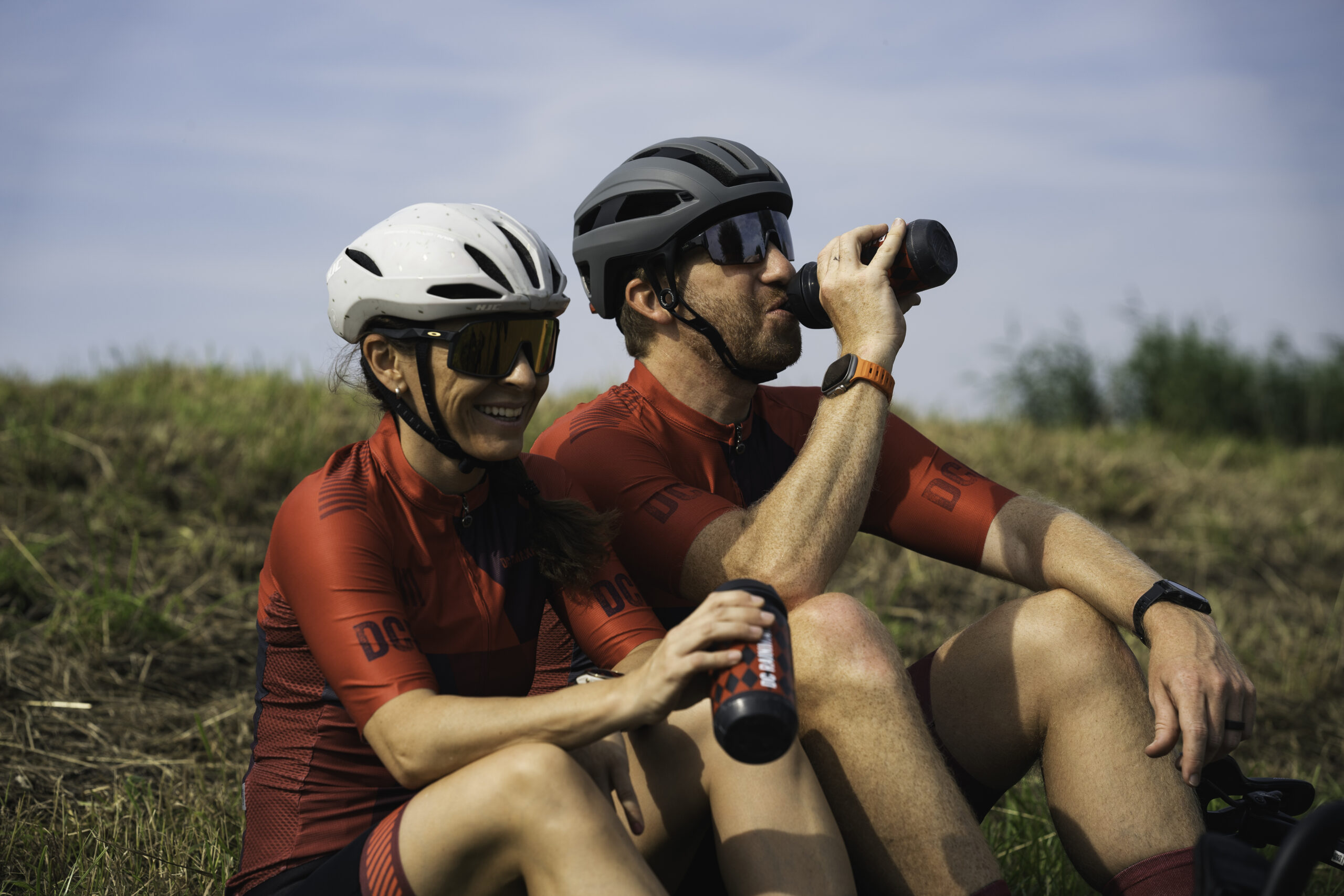
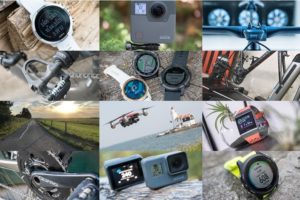
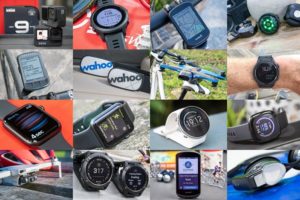

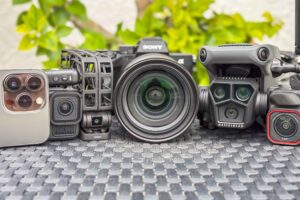

Hey ray,
Do you think TomTom may add daily tracking activites in near future via software update or there’s no chance at all ?
Je me permets de vous remercier en français !
Merci!
I don’t know if they will. I’d like to think they’d make the smart business decision to, but at the same time beyond the first few months of bug fixes, there was only one substantial update (Bluetooth phone connectivity), so it’s hard to say since there isn’t yet a clear historical trend established for where on the scale they fall with respect to adding big ticket features.
I’d just like to echo the comments above about how responsive TomTom has been on this. I’ve been very impressed with their commitment to fixing the issues. Unhappy to be having the problem but hopeful TomTom’s efforts will let the cardio be the awesome product the specs should make it.
I too experienced failure of the HRM display on a new TomTom Runner Cardio. It worked flawlessly for the first four runs (at dusk/night), then commenced dropping out and finally failing (during some bright daylight running). I am an experienced runner and the unit was properly and identically placed in each instance. I perceive my sweat volume to be more or less the same at day or night.
I have emailed a (very) detailed summary to inbox.reviews@tomtom.com as recommended above and hope for resolution before I need to return the watch.
Hum i really hesitate to ordre one until the problème is solved …
Hey Ray,
I want to buy a new sport watch. Wich one do you prefer? Tom tom multisport or FR910 xt?
Thx & grtzz
They’re a bit entirely different product-wise. The 910XT is far more powerful/capable than the TomTom Multisport, which TomTom agrees with. By the same token, the TomTom unit has built-in HR while the 910XT doesn’t.
For triathlon though, since the TomTom doesn’t today have a multisport mode, nor openwater swimming, it’s really hard to truly recommend it for triathletes.
Hi Ray,
Apologies if you have answered this already, but I am looking to purchase my first GPS watch. I am torn between the Forerunner 220 and the TomTom Cardio (I haven’t really looked at other brands). Previously I have just used the Strava app on my phone, and it would be nice to have something that can link with that. If it were your money which would you go for?
Thanks
Travis
In general I prefer the FR220, but at the same time, if you don’t like the HR strap – I’d go the Cardio. I’d say it really comes down to that. Meaning, that if you want HR but don’t want a strap – go TomTom Cardio, but if you’re looking for more functionality then for the same price range I’d go FR220.
Thanks, I have decided to go for the Garmin in the end. Think they seem the most reliable, and I will get used to the strap.
The heartrate monitor is affected by sweat in hot countries like Singapore. Already after 35 minutes it stopped reading because my arm was wet. I pauzed, took of the tomtom dried my arm put back on and yhen the reader started again. Have you heard that before?
If you’re having issues with sweat and the unit ceasing to read your HR, see this comment post from TomTom, as they’re looking for examples: link to dcrainmaker.com
I’m really wondering how many people with sweat issues are just not wearing the watch properly. It has to be pretty tight. I doubt the optical sensor can continuer to read if it’s moving up and down your arm as you sweat. The sweat probably just makes it move more. I found that if I lose HR, I pull the watch about an inch up my forearm, pause and restart the workout. I ran a 50 miler, hot, sweaty and with deep creek crossings. It worked fine. Works better than straps for me.
I can assure you I was wearing the device properly–sweating equals a very erratic HR detection to the point where I sent it back. There is no value in HR data like this when the alternative method has proven so reliable.
Then it has to be either a defective product, or some people are physiologically incompatible with the watch. I have some inaccurate readings from time to time, which has gotten better since the update. But I never have it drop out completely, like my polar strap did. I’ve done multi-hour runs in 85 degree heat in 75 percent humidity. I was sweating so much I was dripping and my clothes were soaked. No issues.
I’m in a wheelchair and got this as a gift. I’ve tested it in watrer as I am a swimmer and found it to be problematic. Often it would lose readings and sometimes it’s just down right inaccurate. Now I know it says it does not work in water but I thought I would share my experience for you. Maybe I’m not wearing it right?
Yeah, as you noted it can be a mixed bag there since they don’t officially support it underwater.
That said, try putting it on the inside of your wrist, and definitely try ensuring it’s a bit more snug than usual.
Well done again, Rainmaker! Such a thorough job of reviewing the product (TomTom cardio watch). I own a Garmin Forerunner 10 and your review of that watch is much better than the instructions that came with the watch! I was looking for a watch that could read heartrate without a strap and after your review of the TomTom, I can now purchase with confidence. Thanks a lot and keep up the great reviews! Cheers, Dave
Hi great review!
I’m skiing and biking, for both I would like to use HR and GPS.
Couple of questions;
1a) I have used Endomondo for some time. The iPhone app is perfect at autosync when I get to a wifi (without even opening the app). Is there some way I can easily autosync to Endomondo? Like autosync to Myworkout (or something else) and then again autosync to Endomondo?
1b) You “trick” the sports modes to get the functions you like (HR/GPS). Is there an easy way to f.ex. use the runner mode and then change it to biking (or skiing) afterwords? Is there a way to do it on the watch, like “edit session” or something? Or do you have to change it on the pc/mac? (I really don’t want to turn on my mac and do all this; change mode, export to mac, import to endomondo).
I fully trust the product reviews you provide, and it’s what I based my decision to buy the TomTom Cardio Multisport. I finally received it with excitement–a little taken aback by the unnecessarily wide wrist band. Nevertheless, I eagerly put it to the test and by the next day it was being sent back to Amazon.ca. The heart rate feature is what sold me on this–so much so that I sold my Garmin FR 620 to buy this (I hate chest straps). Heart rate on this is simply terrible–you must have had a much better device in your reviews. Even though the treadmill algorithm was updated in my model it’s so useless I would never use it (not that there is a real need to track anything other than HR on a treadmill-but wait, this device can’t really do that–even though it claims otherwise). Even to get decent HR detection one needs to almost cut off the circulation in one’s hand to have it–and don’t sweat because that means the end of your heart rate recording. Yet, you managed under water HR data!!! Wow. In any case, I’m wondering if the individual variability is related to individual biology, sweat contents/skin color/heart rate parameters/ect… Now I’m certainly regretting letting go of the 620, it worked flawlessly–yet the chest strap I hated. Man, I wish they would simply make peel-n-stick sensors that don’t require any strap at all!
Hi David-
If you’re seeing a case where sweating causes the unit to produce erratic/unreliable readings, TomTom posted here a few days back that they are looking for examples to try and track down the issue. Here’s the exact comment with e-mail instructions: link to dcrainmaker.com
Hopefully they can sort out why a handful of folks are seeing it. Cheers.
I am on the fence between the Garmin FR910xt and tomtom multisport cardio. This question may have been asked already; there are so many comments I haven’t had time to read them all. Would it be possible to record a swim in RUN mode and then change the activity type to swim? I am mostly concerned with distance and overall time. I mostly swim in openwater, so I was a bit disappointed when I learned that the tomtom multisport cardio doesn’t support openwater swims. I am hoping there is a way around it. Also, I understand that the multisport feature on the FR910xt is really simple. The review says that the tomtom is a little more in depth when switching sports. This is something that I’m willing to sacrifice for the $100 difference, it’s the openwater feature that keeps me on the fence.
On most 3rd party sites you can without issue.
I have bought the TT Multisport Cardio as I train for triathlons. I liked the all-in-one of that watch. However, I am experiencing a couple of issues: i) HR when biking works for about 20km and then out… each time… and the watch is tightly set (strange enough, it works much better when running), ii) elevation gain is never accurate on the websites and far from reality: tweaks ago I rode 85km / 2300m gain (Garmin) and the watch gave me 600m more elevation gain than the Garmin, today I rode 45 km and had 200m more elevation gain (which I compared with reality by calculating uphills gain on maps and it is indeed wrong), iii) sometimes, when I run, I reach a speed that does not look like me (unless I’ve trained so much and improved so much), iv) swimming… it usually counted more, but looks like if I tighten it more than usual it gets more accurate but still more. Has anyone experienced such issues ?
Thanks
I’ve tried again to give it a chance while I was on my push with the wheelchair, again I got erratic HR readings. I had to wipe it clean of sweat ( I dont sweat much) and resync. This is a watch for sports, so I cannot fathom why it wouldn’t work with sweat. I do give TomTom points for trying to get in touch and dealing with the issue though.
Just bought one after reading her on this website. Big peaks in the starts of my runs. Everytime I went in my shoes. Trye to replace and tightened the watch. Still peaks with 30-40 up in pulse. Tried the simple interval-program. Current pace frozen for several hundreds meters:-o Unfinished watch. Delivered back!!! Sorry to say
I’ve had the TomTom Cardio for a few weeks now and I love it. It’s simple to use with great displays. I agree it does lack some training features, but I suppose you can’t have simple and complicated!
My only real bug with it, is that the current pace displayed is often some 30secs to a minutes per mile faster than I am actually going, which is a real pain when trying to train to a specific pace. I have confirmed it’s out by using an App on my phone and by checking the pace graph on the computer after a run.
For instance I did a km section, the watch constantly showed my pace as below 6:30p/m however when I looked at the graph for that stretch my average pace was 7:04p/m and at no time had my pace dropped below 6:45p/m.
I wondered if you (or anyone else had noticed this problem, or whether it is just my unit. Incidentally the average pace works fine.
I have been using the TomTom Cardio for a week, and have a few questions;concerns.
I love the ease of use, the look, the quickness and accuracy of GPS.
However, is there a way to set it to autopause when cycling or running? With the garmin, anytime you go below 3mph, the time and therefore average speed stops. TomTom does not seem to do that which makes data almost irrelevant if you have to ride through stop lights, etc.
Can you change the HR zones? I know my max HR is higher than many peoples, but would like to use it to program the various zones for more accurate feedback.
I don’t think either the max speed or elevation gain is accurate when downloaded. In a triathlon on Sunday, I glanced down to see 47mph on one big descent but when downloaded, my top speed appears to be 30mph. Also, the elevation is just the difference from minimum to maximum, whereas the total climbing on a ride would be more informative.
As everyone has stated, I really hope they truly update the open water swimming and the ability to switch between sports. Even holding the button for 3 seconds in a race to switch sports is not something I have time for. Right now it’s a single sport watch.
Thanks for the fantastic review and responses to feedback!
Hello Kathy,
Thank you for the feedback and comments. I’ll share your experience with elevation and max speed with the product team.
Regarding changing your Zones – that’s indeed possible. You need to log in to MySports and go to the Training tab. You will then see a graph with the ranges of your heart zones from Easy to Sprint. You can drag the ranges to the numbers that make sense for you. You can also change your maximum heart rate.
How does the functionality of this watch compare to its previous generation? Was the only upgrade adding the optical heart rate monitor? I am tempted to buy the (non-cardio) multisport performance bundle for the same price. Any advice?
It’s identical feature-wise.
HR issue when sweeting… I was experiencing the same issue essentially when biking long distances even if watch was always tight. And then I tried something: I shaved the air where the captors are on the wrist -> it worked perfectly and with more precise data !
Now the only issue remaining for me is the inacuracy of the GPS data ie not distance on the watch which seems to be ok but total gain calculation by websites which is totally wrong.
BTW I also used the watch for open water swimming in the lake on run mode and worked well except maybe a slightly longer distance
Hi Alex,
Thanks for sharing your approach. In general, we recommend anyone experiencing heart rate dropping out mid-activity (after first getting an accurate reading) to contact us as soon as possible. This should not be happening and we would like to help people experiencing it.
You can contact our Customer Care department directly via: link to bit.ly or send me an email on inbox.reviews@tomtom.com.
Hello TomTom,
If I order one on your website, is that sure that i’ll not have this sensor problem ?
Thank you.
I didn’t see we can’t order this on the website. Is the sensor problem is the reason ? When do you think this problem will be fixed ? Thank you
I just bought this product as my number one goal was to get rid of the strap. Quite pleased so far, but distance calculation on treadmill is way off. Is it possible in the future that an update will be offered to allow the unit to accept a foot pod?
They’ve said a future firmware update should address treadmill issues using wrist based calculation – but they haven’t yet agreed to add footpod support (wish they would).
Does it give a calorie count??
Yes.
Hi,
Great review. First time in your site. I found it excellent. However, I still have a couple of questions:
– How can I make sure I am getting the watch with the barometric altimeter?
– Will it work ok in a country like Colombia? I am buying it for my father who loves cycling but he lives in Bogota. He normally goes cycling through mountains and roads around the city. Will the watch track his trajectory properly?
Thanks,
Paola
1) You need the Multisport Performance bundle
2) Yes, no problems with GPS anywhere (The “G” in GPS stands for Global).
In the end, the several cons (intermittent HRM failure, only 3 data fields available on the screen at one time, “pace” taking way too long to update to an accurate number) outweighed the one big pro (integrated heart monitor) for me, and I returned this to Clever Training today. I’m going with the Garmin 620 instead. I love the concept of this unit – I just don’t think it’s ready for prime time yet.
I will tell you that my dealings with Clever Training have been wonderful, and I will definitely use them for future purchases via your website. Excellent group to partner with!
-Mark
I was really excited about this watch, its my first GPS watch moving from a phone for run tracking. I am not a fan of the chest strap so having the HRM in the watch was a big sell for me.
I have used the watch 4 times now and every time the HR drops, last tights run was just after a mile and the only way to get the HR to work again was to take it off wipe my wrist and then the sensor on the watch. HR might pick up but if it did it was only for a few moments.
I called TomTom support today and after a brief hold I was told they would need to replace my watch, that they have found not all but some of the watches have a defective sensor and the new one will work no matter how much I sweat.
My concern is that’s not totally true and I am going to swap watches and then not be able to return the Runner Cardio watch to Clever Training for a different brand of watch.
I’m in the same boat and I finally decided just to return it to amazon. There are just to many issues with it at the moment. Maybe it will work better later. But I will say that TomTOm is very good at their customer service.
@Larry – choose your remedy carefully, my friend! :) Due diligence in researching TomTom Forum’s 15-page thread (among others) about the HRM issue and other online reviews might assist you in making a decision!
I got a defective watch and because of the seemingly “caring” and “reaching out” malarkey above — I chose to try TomTom Customer Support because I really wanted to believe that they were sincere about rectifying the problem. I began the dialog with C.S. on June 14th…
Three days later TT C.S. responded and asked if I wanted to correspond via phone or email…?! Being a deaf senior runner, I chose email.
After another two days went by they responded, stated the watch was defective, and asked me to return it for replacement. I did so that day…
Two days after FedEx verified that TomTom had received the watch back and having had no response from C.S., I called them on the telephone and — although difficult for me to converse this way — was told that they would not return my old watch back so that I could return it for a refund and read to me the same script that is included in their emails:
“…Turnaround time is 7-10 business days from when you ship the product to receipt of the replacement.
– TomTom will send a confirmation e-mail upon shipment of the replacement device…”
After finally being allowed to speak to a supervisor — I was told that it REALLY means 7-10 business days AFTER THEY RECEIVE it back?? He had no suggestions on what to do next — other than see what happens next — but said he would send a notice to expedite/escalate my exchange with “the warehouse”?? That was five days ago?!…
Nothing heard from TomTom…
Believe me, if I now hear that they are “reaching out to me” one more time — I’m going to hurl!
Since I no longer even have a TomTom Runner Cardio at all (defective or not) — I have placed the pretty little EMPTY plastic crystal box it came in near my computer as a tiny shrine and constant reminder of my foolish trust.
____________
@ “len” — did you ever receive an exchange on yours (post #487) ?
Murmuro and the rest of the board –
I am relieved to report that my replacement multi sport cardio arrived TODAY. 17 days after i sent mine back to them (as a favor to them, instead of just sending it back to CT and getting a garmin….).
I had to send 8 emails asking for updates / tracking numbers etc. I cant lie and say i am impressed with their communication.
if they had told me “we want to make sure we get you a working unit, it might take 3 weeks” then my expectations would have been properly managed and I would have been chillaxed about it.
Its charging now and I will take it out for a run later. its hot and humid here in NYC, so I can promise there will be sweat. will let you all know how it goes.
Thanks so much len!
Please keep me posted — I wish you luck!
Hello again murmuro, len,
Your frustration is understandable and I apologize for not being clearer in managing your expectations. Both of you were some of the first to answer my message here and send in your watches. Your support helped us investigate the issue and resolve it. However, that took time beyond our normal return process which is usually much faster. We should have been clearer to you on the reasons for the delay.
I’m happy to read that len received his watch. Please don’t hesitate to email the reviews email in case you have more questions or issues. Murmuro, I will do my best to get you a tracking number for the delivery of your replacement watch today.
Any return shipments from this moment onwards should also be much faster than the two of you experienced. In case anyone else’s shipment gets delayed beyond the official return period stated by Customer Care please send me a note to inbox.reviews@tomtom.com and I’ll try to push internally.
Can you answer my question please ?
” If I order one on your website, is that sure that i’ll not have this sensor problem ?”
But I see that you’re not selling it on your website, it’s because of the sensor problems ?
Thank you
Hi Jeff, due to demand, we have availability in some countries on tomtom.com and not on others. Supply will be available shortly in all countries. Please be assured that we stand by the quality of all of our products, regardless of where you purchase them from. In case you have any problems with the watch we will offer you the best support we can.
I had some issues with the watch early on. Just trying to find my way around the different features, the watch froze and reset a number of times. Doing a factory reset and offering the benefit of the doubt, I took it for a run. I liked how the watch felt during the run and the heart rate monitor worked great. I didn’t notice any of the heart rate or pace issues that some have mentioned before… until I took it for a bike ride. I had the watch set up on the handlebar mount and began flipping through the display (even having to do this annoys me, not to mention the inability to customize the screens except for the two top metrics). Is the watch just guessing what my heart rate is when its not on my wrist? How am I supposed to know that my heart rate isn’t a “guess” during other activities while wearing the watch?
I do have a few things that I really appreciate about the watch though:
I love the fact that I can upload from my watch straight to my phone, and it even automatically loads to Strava seamlessly. I also like how easy the menus are to move through and how well the watch fits my wrist. I really like that the watch comes out of the strap and clips into the bike mount. Lastly, I bought this watch because of the heart rate monitor. I hate HRM straps and love the idea of having the monitor in the watch itself, I just don’t love it enough to spend money on one I can’t trust.
Icing on the cake: I can’t seem to get in touch with TomTom. I purchased the watch through amazon because I have a prime account and I’m not very patient so the free two day shipping is great. I can’t find anywhere on the site where they offer contact information; every other company I have purchased from through amazon offers contact info. Also, clicking the support button on the mysports website loads a new tab with the same page I was on before clicking the support button. Going to the FAQ page brings up an option to contact TomTom Support. Or not. I was taken through a list of menus just to see that my “Contact Options” came up blank. FOR EVERY ENTRY I TRIED. I even tried to select a different product and problem and contact information was still empty. What the heck TomTom?
My previous watch was a Garmin FR410. I bought the TomTom because I wanted a multisport watch I could swim with and the heart rate monitor was a huge plus. Needless to say, I am disappointed with my experience so far.
It would be great to hear from TomTom.
Ryan O
Hello Ryan,
Let me try to address your questions.
Firstly – the question about heart rate while biking – The Multi-Sport Cardio can in no way “guess” your heart rate randomly – it needs to get the data from either its in-built or an external sensor. You have the option to use a normal heart rate strap and hook it up to the watch via Bluetooth while biking with the watch on the handlebar. It sounds like you’re really not a fan of straps though…so the best option would probably be to still wear the watch on the wrist if you want to have accurate heart rate rather than put it on the handlebar.
Secondly – the question about contact information. I’m not sure why you didn’t get the contact options from our site. I apologize for the inconvenience – usually you have a choice between phoning, emailing or posting a thread on our forum. I’ve reported the error and it should be fixed shortly. In the meantime you can call us directly on 866-486-6866 or if you prefer email me directly on inbox.reviews@tomtom.com in case you have more questions.
Great review as always
The main reason I bought this watch was to go strapless and so far it’s really liberating
One thing bugging me is that cadence is not sent through to Strava via the mobile upload even though it’s visible in the MySports site
I’m really glad the treadmill function works by sending the correct (calibrated) data through to Strava and not like the Ambit2 which seems to multiply the minutes run by 60 and show them as hours when using indoor mode…
encouraging news. new unit is 1 for 1 on HR. kept it for the full 8 mile run in dripping sweat. normal tightness of strap (vs tourniquet levels that i tried on the first one). taking it to spin class now, and hopeful.
I am interested in buying the TomTom Cardio Runner, but I would also like to use it for strength training and yoga. Do you know if it will track my calories burned during those activities? Also, is there an option to mute any sounds? I don’t want to get the evil eye from my fellow yogis when it starts beeping in class. Thanks!
Thanks for another great review. I was another person extremely excited for this watch as I don’t like chest straps. I bought the Multisport Cardio watch the first week of June. The first two weeks were nothing but gym training on a treadmill and one outdoor run in cooler weather. The HRM matched a polar and the gym treadmill almost perfectly. I did notice a significant delay of 20 seconds sometimes when I started a sprint, but the TomTom would get to the right HR, just a bit slower.
The third week I started taking it for outdoor runs and cycling rides and everything went crazy. I live in DC were it has been 90 degrees and humid. The HRM either shows 20-30 bpm low, takes 30 or more seconds to realize my heart rate went up during a full sprint, or shuts off completely. My last 7 activities all had major problems.
I returned this to Amazon due to the fact that my 30 day return window was just about up and didn’t want to play games with TomTom. This is embarrassing for a company to put out a product that does not do the one thing it was designed to do. This message board, amazon, and other reviews are showing tons of people having this problem. I would expect this from a $50 product, not $300.
I will admit that I really like the fit of the watch. The new band is a lot better than the old TomTom bands. I like the clasp is covered and not bare metal, and that the end of the band has prongs that lock into the band. The interface is extremely user friendly. My only other complaint is that there is no workout mode. I wanted to track my heart rate while working out and other activities that aren’t on a treadmill. My only option is to use Treadmill mode, which then gives me completely wrong extra information like distance and pace when I am lifting. Seems like a simple fix to just add a basic HR mode for general workouts. Also adding HR to swim mode would help greatly.
Overall I wish this worked out, but for now I am still stuck with a chest strap. Maybe next summer will provide better options. I have no faith that TomTom will magically fix the problem and send me a working watch when it has only been a month since release. Never should have sold this many faulty ones to begin with. Quality control testing was horrible. Great if you live somewhere cold and never sweat.
After reading this very thorough review (thx Ray !), I thought I give it a try and buy the watch. And I am not disappointed. On the contrary, it’s great ! In the beginnig I had some HR-dips, as reported here by several people. But than I moved the watch 2cm further up my arm (away from the wrist, just behind the knockle) and it works flawlessly. And it’s still very comfortable to wear. Also during swimming the HR recording (in treadmill modus) is perfect. Other take-aways:
– Switch between sports is quick and easy
– TT training website isn’t of much use, but I am now using Rubitrack (I am on a Mac) and that’s just wonderful. I hope you are doing a review Ray, as I noted in a remark longtime ago.
– It’s a pity that you can not use the TT simply as heartrate monitor (because it doesn’t rebroadcast), now I am still wearing a HR strap for my Garmin 500 when on the bike. Because for biking the TT display is a bit too small/simple.
So for me it’s already a killer watch. But if they get over the HR-issues (with other people..) and enable ANT+ compatibility &rebroadcasting, it’s definitely a main contender for the best triathlon watch 2014.
Yesterday a ran for about 40 minutes in pouring rain. I was soaked. HR never dropped.
Only issue I have is about half of my runs it takes a few minutes to a whole mile to jump from 75bpm to my actual heart rate. Sometimes pausing the run and instantly resuming seems to fix this. Other times it doesn’t.
Can you please clarify if this has a interval timer to do run/ walk( i.e. 10 min run: 1 min walk)
Thanks
Please, write a few words about TomTom’s Virtual Racer feature implementation.
a week of activity and happy to report that my replacement unit has been perfect in HR. no drops in running, biking or in treadmill mode, swimming, spin class, etc. my experience suggests that if you are having that issue of heart rate dropping during runs, then get a replacement.
i love the lack of strap. the watch does a good job picking up satellite quickly and i like the look and feel.
what i dont like is that it could use 4 fields of data while running. and i find it difficult to read while biking since its on my wrist. i dont want to spend time looking at my wrist and wreck.
my biggest peeve is that you cant see your splits on your watch after a run. the data is there, but cant get it. if the recap gave me mile splits, i’d be pretty happy.
DC do you know when the alternate straps for the cardio runner are coming out?
Also have you had any issues with the battery or battery meter? I’ve had mine just go from around 75% to around 10% merely by turning on “night mode”. I know night mode takes more battery, but such a drastic drop was quite surprising.
My understanding is still another few weeks, but perhaps TomTom Community Manager can validate/verify.
Let’s say I did go for an open water swim, could I just put the watch in treadmill mode kinda like you suggested to keep heart rate or would that be useless to do?
Yup, it’d pretty much just do the same as me. It’d track heart rate but not accurate distance.
Please, write a few words about TomTom’s Virtual Racer feature implementation.
And do you think Virtual Racer isn’t so good as it sounds? From what I read about it – it’s very interesting and motivating feature. Am I wrong?
And which watch have it (beside 910XT & TomTom Multisport)?
Hello Sir. As usual, wonder review. I wondering, in your opinion, which optical sensor watch (without strap) has the highest rate of accuracy in regards to strictly measuring heart rate?
Thank you for your time Sir.
(Looking at just full watches with optical, per your comment)
It seems to really depend on the person. For me, I saw zero issues with the TomTom Cardio. And I’m optimistic that the few people that have seen issues will be resolved with the new units that TomTom is sending them.
On the Adidas side, I also saw no issues with optical HR. Of course, both are made by Mio, and both are using identical sensors. And both have similar width coverage so they end up blocking similar amounts of light.
Thank you so much for your reply. The mio is a little cheaper. But, when i went to check out your review for the mio link, you have a notice at the top of the page saying that you’re still testing the mio and some users have reported inaccuracies.
So for pure heart rate measuring, the mio and tomtom would have identical accuracy?
Once again, thank you for your prompt reply. I love your site man
The issues with the Link I suspect are two-fold:
1) The transmitter design appears to cause transmission issues which in turn causes drops (which I see)
2) For some people and/or situations the thinness of the band (Link) appears to let light in and/or cause issues on some reasons (I less often see personally, but others see).
Neither of those actually impacts the TomTom Cardio though because it’s A) Not transmitting outside the unit and B) Has a far wider base which prevents light from getting in far better.
Thank you for your clear reply. I’m will buy the Tom Tom.
Am I right that the multi-sport version has an altimeter while the runner version does not? I don’t need biking or swimming functionality, but I would appreciate elevation history for some activities.
has there been talk about adding the seconds feature to the time? Maybe in an update?
After seeing the recent reviews about people replacing their watches with TomTom and getting ones that don’t drop and blank out on HR, I am considering buying this watch again. My question is for the Tom Tom Rep. Why is it that you can now buy the Runner-Cardio in an all black band, but not the Multisport-Cardio. They are the exact same watch with identical bands, just a few extra software features. Is an all black version of the Multisport-Cardio coming? I need the Multisport and not the Runner but cant stand the dual color bands. Want it in all black.
I have the same question as Jim. It really doesn’t make any sense that the multi-sport cardio cannot have the all black band as runner cardio. Tom Tom rep, at least give us a timeline, I’ll buy one immediately when the all black band is available for multi-sport cardio!
Hello DC. Would the TOM TOM Cardio running model be suitable to measure heart rate while doing other activities such as jumping rope, lifting weights, or playing soccer?
It doesn’t use heart rate to determine calorie burn, so it won’t quite be accurate for calories. But otherwise if you’re just looking to measure the data – no problems there.
Thank you for your reply.
I too was experiencing problems with the HR monitor function. It would often take several minutes to try and get a HR read, to the point where I would just give up and just go instead of waiting until it got a read. And then I would find it didn’t get a read at all during my entire run. Or if it did manage to pick it up in the beginning, it would drop. I couldn’t believe that Ray was able to get a read in only a few seconds. Even my GPS function took at least a few minutes depending on where I started (in the heart of downtown, it would take the longest, maybe because of the buildings?). Still, I never got a read within a few seconds.
I have small wrists, so I was at the second to last tightest setting and would switch to the tightest setting when I got sweaty and it seemed the watch was shifting around too much.
Otherwise, I am pleased with its GPS function and biking mode, battery life, and overall look of the watch. But, ultimately, I decided to go with THIS particular watch for the HR function. I had ignored the HR for a while but thought it was time to ask TomTom for a different unit.
I emailed TomTom customer service and they have been fairly prompt to reply to my messages and set up a return. They should get my watch tomorrow (Friday) and hopefully I’ll get my replacement unit and it works this time. I’ll report back!
I just got my watch – strangely enough, my watch was originally red/white and I was sent back a red/black watch. Not a big deal but… weird.
I’ll have to test this a few times and see how the replacement watch does for HR on runs.
Got my replacement watch – they actually sent me a red/black version instead of the original red/white one I sent back but whatever. The HR now picks up within a few seconds and maintains it through my workout. I tested it a few times in treadmill mode just while sitting at work and used it successfully during a 5k. Replacement watch seems promising!
One of the most thorough and balanced reviews I’ve read….nice work!!
great stuff here!!!
i bought one TomTom and love it and now i have enter to win another one for my wife here on http://www.speerit.co … cheers!
I am Just discovered your reviews, fantastic and informative!
Are there any other differances between the “cardio” and the regular “multisport” except the heartrate monitor? Would your say it is worth the xtra cash to get the cardio? I am not a great user of heartrate monitor bit maybe I will get hooked….
Yup, the same.
TomTom Customer service, is the worst!! I sent them my watch for replacement, and I fallowed the steps they asked me to take to get a replacement and now a week later after getting no information from customer service I waited on hold to find out the Cardio watches are OUT OF STOCK. I’m told they expect some by the end of the week but that shipment was already delayed.
If you have an issue with your watch return it to were you purchased it if you can. TomTom Customer Service will most likely lie to you, like I feel they lied to me. I even talked to a manager Johnathan who had kept saying it wasn’t there fault, even thought I was told twice I would get a fallow up on the status from them and they failed to do so.
I have been reading the various comments on the web page about the heart rate sensor. Does the sensor have the ability to display HR data between 50 and 95. Also I want to purchase the multisport cardio what serial numbers have the fix. Thank you.
Hi Ray,
1.With active both heart rate and gps, how many hours of workouts can be saved on multisport cardio gps watch before it needs sync with mobile/pc?
2.Will be using this watch (in running mode) for my walking. With heart rate and gps on, will calories be rated correct for walking?
Hi Ray,
1)With active both heart rate and gps, how many hours of workouts can be saved on multisport cardio gps watch before it needs sync with mobile/pc? 2)Will be using this watch (in running mode) for my walking. With heart rate and gps on, will calories be rated correct for walking?
I don’t have an exact number offhand of hours of workouts. But, for calories/HR/GPS, yes, with walking it’ll be fine since it’s distance based.
It appears that the multisport and runner watch are the same with different firmware. If that is the case, is it possible to get the cheaper runner watch and just flash the multisport firmware to give it the extra functionality?
No, not possible.
There is however a minor difference between the multisport and multisport perf bundle which has the barometric altimeter hardware in it.
hi Ray,
thank you for your answer,impressive how fast you did response :)
one more question. by 10hrs of battery life you mean with gps on and heart rate on?
Correct.
Hi Ray
Great write up. Would you have any idea how the watch can directly sync up to mapmyfitness?
Hi Tom Tom Community Manager
I am planning to buy 1 in Singapore from a local sports shop. I have concern about the HRM failing due to sweat as this is a place where you can even sweat lazing around. Also its tough in this place to get a 1-1 replacement should I be unlucky and get a faulty unit.
Will you guys allow a 1-1 change directly or advice us to go back to our local shop for the change if it really happens that I get a faulty unit.
Thanks
i am from Singapore too and would like to know how we can do the replacement over here.
Thanks for the wonderful review. Does the runner version give GPS elevation data?
Not on the unit itself, but online afterwards you’ll get a little elevation chart.
Hi, and what about open water swimming with gps? do you think it will work?
thank you
On your head in your swimcap yes, but not on your wrist – the GPS will be all over the place.
Hi Ray,
Another great, really thorough and helpful review and comments.
I’m a runner / triathlete and I’m torn between the TomTom Cardio Multisport, the Garmin 910XT and the Fenix 2. I’ve studied lots of reviews and product specs on these watches but still cannot decide which would be best for me. I’d really appreciate it if you would mind helping me with these questions:
1. Is the only advantage of the TomTom over the other two Garmin watches the optical HRM?
2. Is the Fenix 2 just a more recent Garmin multisport watch, or are there any differences between these two watches that separate them, which makes one preferable to the other?
3. Which watch would you recommend out of the three for a triathlete?
Thanks so much Ray, really appreciate your help.
1) Yes, pretty much correct.
2) There’s a number of differences between the Fenix2 and the FR910XT. Check out the end section in my Fenix2 review for all those key differences.
3) Here’s my recommendations on triathlon watches, published just a few weeks ago: link to dcrainmaker.com
Cheers.
Thanks a mill for your reply Ray, that’s really helpful. I had missed your recent summer gadget review but reading it now is a big help. The Fenix 2 review is also brilliant and very detailed as always. You’re a star, thanks a lot.
I wanted to pick up the performance package and wanted to verify that you can use two different Bluetooth sensors at the same time? If I mount it to my bike, I want to use the bluetooth chest strap and cadence sensor. Does this work? I have seen some reviews where people were having issues.
Thanks
Yes, it does (assuming you have the multisport version).
Great review as always. I am returning my Garmin FR610 and considering the FR220 vs. the TomTom MultiSport Cardio. I am primarily a runner, and rarely use my heart monitor. I ride once a week or once every other week. It’d be nice to have heart monitor capability without having to use the chest strap and it’d be nice to be able to display speed and record speed, route, distance when I bike. I just joined a neighborhood swim club, so could start swimming laps and recording data there.
Sounds like the TomTom is much better @ “multisport” than the Garmin.
I also really like Strava. Would the TomTom data from the watch connect easily via my iPhone to Strava? Or do I need to upload to the Strava site via my PC?
Thanks!
In this case, the TomTom Multisport would be better than either the FR220 or FR620 for multi-sport needs. You might want to really consider the Suunto Ambit2 S though, which has far more functionality for similar price ($220US).
Both TomTom and Suunto can upload to Strava. Though, not via the iPhone, rather, via PC first.
Hello Calvin,
Wanted to update you that it’s now possible to upload also to Strava through the MySports mobile app. Hope this helps!
Hi
I just bought my first racing bike to get a little more serious about training at the bike. I do also run quite a lot, but have never bought myself a sports watch. I was considering this watch as a single device that can record all of my training. The running part seems straight forward, and i expect it to be good here.
What I was wondering was about the cycling mode? Did you have a cadence sensor to review? I have read some negative reviews about the connection between the sensor and the watch. How hard is it really to line up the sensor and the magnets?
Jørgen
I didn’t have a TomTom specific sensor, but rather used 3rd party sensors (Wahoo BlueSC), which is virtually identical.
Once you have the sensor magnets lined up you’ll be good to go unless you bonk them. I can go months without accidentally bonking them though, so I’d consider it a non-issue for most.
Hello everyone,
Most of you might be aware but wanted to share this message in case you have not connected your watches the last few days. There is a new software update available for your TomTom sports watches. The latest software update for the watch allows Multi-Sport users to do a generic GPS activity through the Freestyle mode. Additionally, all users can now race any historical activity on MySports through the “Race This” Button which will send that specific activity to the Race training menus on the watch.
We encourage you to update your watches through MySports Connect to get all the latest features and fixes.
I just bought one. I’ve only had one run with it so far but I’m very happy with comfort, ease of use etc etc. Just a quick question – what exactly is freestyle mode? I’ll experiment and figure it out if I need to but it’d be nice to get a run down on what is measured, and how to break it down between activities for a brick session or triathlon. Do you need to manually record laps by tapping the screen to break different events? Will it recognise pool swimming without being told? (I’m assuming it won’t record GPS in open water if on the wrist). Cheers.
Never mind, just found the manual online :)
A very simple, precise question?
Can the TomTom runner stream HR data in real time via Bluetooth to an iPhone where it then can be used by an iPhone running app (like iSmoothrun, Runkeeper or whatever) ? If not, is this feature being planned anytime in the future?
The idea being to basically use the TomTom as an optical heart rate monitor. You could then use it to be coached through your headphones in real time on an intricate interval workout with iSmoothrun, for exemple, but still be able to occasionally check the display of the TomTom to see your pace, HR and so on.
No, it cannot. TomTom hasn’t made mention of adding such feature (though, it is often requested).
Quick question about the watch. Does it measure elevation and/or changes in incline if you were doing a hill workout as opposed to training on a flat course?
Many thanks to TomTom customer care department!
I purchased TomTom Runner Cardio – GPS Watch a month ago after Ray s review from Clevertraining web store.
I loved the handful watch from the first moment BUT i had HRM data issues (wrong readings , no readings at all and sometimes perfect readings COMPARED to data from Suunto Ambit with chest strap and/or with MIO LINK strap )
I decided to send an email to TomTom service to explain them my problem.
I got back an email from a representative(Meg Stefouli) in my origin language which is not very common one: Greek!
They asked me to send them back my watch so they could replaced.
I hesitated to send the watch back because its summer i am on vacation and i wanted to use it because it is still handful even with external hrm chest strap or the MIO LINK that i already have.
After 4 or 5 days i got a UPS note to pick up a parcel…..
They had shipped to me the TOMTOM Multi Sport Cardio – GPS BEFORE i send them back my cheaper TomTom Runner Cardio – GPS!!!!!!!
Anyway i send them back the TomTom Runner Cardio – GPS via UPS on their own charge and i really thank them alot!
As long as i use the new watch one i have had no data issues!
I wish this to continue …i will keep u posted!
Question to TomTom: – Is HR measurement issue FIXED?
Hey, is it possible to personalize the heart rate zones?
Yes, you use “sliders” to adjust the zones.
Yes, you use sliders to adjust the zones.
Please can you advise me how to export my history from Tom Tom to Garmin Connect because it’s not on the list shown by Mysport. Garmin Connect would be my preferred soft wear option.
It’s not an option because Garmin is a competitor to TomTom.
To get around that, simply choose to export the file as a .FIT file, and then manually upload it to Garmin Connect from the Garmin Connect website/dashboard.
Set MySports to sync to Strava. Then use this to link Strava to Garmin. https://tapiriik.com
Hi ray
I am looking to buy my first fitness watch and my basic requirements are as follow
1.Indoor running i.e. treadmill, crosstrainer and cycling in gym
2. Continuous Heart rate monitor to check calories burnt in gym as well as in all day activities.
3. Bluetooth connection with Android phones for activity data upload.
Please advice me to buy a fitness watch which is best for me.
Thanks
great review just like all the rest Ray!
would using the tomtom in open water damage on your wrist damage it in any way?
also, have you tried using the running mode gps to track your swims in open water?
cheers!
No issues with water usage/damange in openwater.
Some folks have tried using running mode for openwater, and generally found the results pretty mixed (at best).
what are the steps on how to export (is it the .ttbin file?) and upload a heart rate recording (about 14 hours) to read it in a graph like you posted? thanks!
You’ll need to change the export type to .FIT file from within the TomTom MySports desktop software. Then you can upload it to Garmin Connect or other applications.
Fantastic review ….. Thank you that you have the time..
My question… Is it possible to pre-set a distance (say 21.2 km) and a time like 80mins and get the watch to “pace” you over the distance… I find the hardest things about running better times is knowing the correct pace
Thanks
Should have read the review better….as going back through I answered my own question!!
Hello everyone! Have an important announcement today regarding something many of you have requested: we’ve launched the TomTom MySports app on Google Play for selected Android phones. It enables automatic activity sync and upload via your phone to multiple platforms.
The phones we’ve tested and support are: Samsung Galaxy S3, S4, S5, Nexus 5, HTC One and HTC One M8. Over time we will add more models to the list.
You can download the app via the following link: link to play.google.com
There are some important activation tips in the app description on Google Play – please read through it.
I purchased a TomTom and am having the most frustrating issue. I searched through the comments here, didn’t read them all, so if this has been repeated, I apologize.
I can’t log onto My TomTom. When I ask it to send me a new password it says – “we don’t know that e-mail”. But when I try to create a new account it says, “that e-mail is in use”. On top of that I KNOW I’m entering the right password.
It has been a while since I used my watch which I got back in May but now I’m trying to get back on track I have noticed that there appear to be a significant difference in the calories that it says I have burned. Was there something in the update that could have changed this?
Many thanks for advice on how to acess Garmin Connect. However, sometimes the imported information doesn’t include my splits.
Can you tell me how I, when I do 400m intervals and the like with a 200 m recovery how do I set up my Tom Tom to capture these splits. It doesn’t seem to work when I do it! I just continue to get mile or kilometer splits?
I do find that when I run fast (for me) that I get spikes from the HRM. Most annoying. I do have a bony small wrist. I have the strap very tight. There appears to be no movement but obviously there must be. There is no way I could have the strap any tighter, it would be physically impossible. Also this morning, for the first 10 mins the info received was total rubbish, then it settled down. This has happened on a few occasions.
I do like the watch and it is light and easy to use plus I just LOVE not wearing a chest strap after 10 or more years if doing so.
Downloading data is still rather crude but hopefully this will be ironed out by Tom Tom in time,
It’s gonna be tough, because I don’t believe they’re recording the splits to the .FIT file.
The FIT file most definitely records splits, but you can’t view them in TomTom’s website. If you upload to a 3rd party website, you’ll be able to see them. I use RunningAhead, and have had no problems manually uploading FIT files.
The bigger problem with taking lap splits is that the touchscreen works so terribly. Sometimes it starts recording laps like crazy (30 or 40 in the course of a few minutes), even when it’s not being touched. Other times it’s impossible to get it to record. I’ve definitely had to reconstruct workouts by looking at the graphs for when intervals actually ended ended and started.
That’s a bit of a bummer!
A major flaw with the watch is the lack of screens. Specifically there is no average heart rate or lap heart rate option. Really disappointing given that this is a “cardio”
It’s also disappointing that you cannot configure several parameters per screen.
I was looking for a good alternative to Garmin since I have had nothing but trouble with them in the past (charging, HRM, watch strap), but I don’t think this really compares in terms of functionality to the 610 or even the 410
Hi there. Just bought Tom Tom cardio GPS running. It looks OK but I have problems to analyze the data. For example this morning I run 10 times 200 meters and now I do not know how many seconds for each 200 meters interval. Not so good :-(.
Hi! I’m using TomTom Multisport watch with the heart rate monitor (older non-cardio version). However, I do not feel comfortable with a chest strap. I saw on your other post that you have rewieved the Mio Link heart rate monitor and I was wondering if it it would be compatible with my watch? BTW, great rewievs – I decided to buy my watch after reading your comments, very helpful. Thanks.
Yup, they’re compatible.
My biggest issue with these TomTom watches is there is so generic activity for indoor gym stuff.
Early adopters waited months for this and were told it was here when they released the ‘freestyle’ mode. But this mode MUST have gps enabled and connected or the activity won’t start.
So useless for weights, indoor rowing etc.
Any ideas if this will be fixed? Just a mode that enables the HR and tracks calories is all that’s needed.
Here’s the challenge though: The unit doesn’t calculate calories using HR, rather, just using distance metrics.
Yeah I guess that’s the issue. Pretty big issue though.
But does Strava calculate accurate calories? Their numbers are way different than TomTom.
In fact, if you compare Tomtom MySports to Strava, Mapmyrun, etc. they all show different splits, calories, elevation and even times! How is that possible? Hell, Strava somehow doesn’t even get paces right. It you di vide the time by the distance their average pace is slower than it was.
Also, if you have the watch alert you to mile laps, it’ll say 6:18, but when you load the run it says that same mile was a 6:24. Huh???
Yeah, the fact that everyone does everything different and thinks they’re always better than the source is a bit of a challenge in the industry. Be it elevation, calories or distance – everyone wants to recalculate everything and “optimize”.
I have the runner version..how do I monitor my heart rate will doing a standard gym cardio workout? also does the heart rate data export to external sites like Garmin connect? I can get all other data to export but the heart rate data is missing? THanks
Nobody solved the split/lap problems? Yesterday I did 8 x 1 km + 2 min. rest; I used manual laps as I was running in a 400 meters athletic track; while I was performing the exercize I was able to read the single time lap on the screen of my Tomtom runner cardio. When I download from the watch to Garmin Connect or even STRAVA (file .tcx) I was able to see only one big lap for one 1 her and 10 minutes (means the total time of my training). This is really unbelievable! Should I run next time with chrono in one hand and tomtom on the other??
I need cardio control as I am training base on cardio frequence, otherwise I could run with a simple chrono watch !!! Help !!!
I would like to add one more piece of information on my above comment: the day before yesterday I tried to lap 2/3 100 meters sprint, after one hour easy run; don’t ask me why, but the split are visible in garmin connect or strava!!! Can send file if needed!!!
CHANGE SCREEN DISPLAY TO 4 DATA?
Sorry i posted this as a reply to some other post.
Here’s my question:
Is it possible to set the screen display to 4 data instead of 3?
I like seeing duration, distance, pace and heart rate all at once.
I do that with a Garmin 610.
I like the integrated heart monitor a lot but i would miss seeing all 4 data.
Thanks
No, only three screens can be shown.
DEVICE RETURNED TO SHOP
No, i don’t like it.
The integrated heart monitor is great but:
1) Display of data is not what i expect:
– distance and duration are too small
– the other data are not customizable. You see “current pace” and you have to press button a few times to get to “heart rate”. You cannot customize this, go through a lot of other data you are not interested.
2) Transfer to PC app crashes. I ran with it yesterday. 6km. All seemed ok (i could see duration, distance and pace during race). When i connect to PC i get an error and… the activity is not there anymore! Lucky it was not a marathon! You don’t wanna lose your record of an important activity.
3) I missed the lap info every km that you usually get with a Garmin. Maybe you need to set the run activity to laps to get that info during the race, i don’t know.
4) I may consider buying the multisport cardio again if a future firmware update gives you more choices (display more than 3 data, decide the order you want data to show, say pace and heart rate first and all other after so that you don’t have to scroll and scroll to find what you need…)
A couple of quick thoughts.
1) You can customize the data fields, the top two data fields are customizable.
2) Not sure what’s going on there, have you tried support?
3) You can setup auto lap just like the Garmin (which also required setup).
4) See #1, you can configure the top two fields.
Cheers.
A couple of quick thoughts.
1) You can customize the data fields, the top two data fields are customizable.
—– Yes but the top two data are too small while the main screen one data maybe too big. Lot of screen wasted with gps signal / the little heart / battery.
It would be good to redesign the whole thing so that you could see 4 data at once.
Or at least make it possible to switch from pace to heart rate with only one click (now you have to scroll too long from one to the other)
2) Not sure what’s going on there, have you tried support?
—– No, because of #1 i thought i’d better just have it returned and reimbursed.
3) You can setup auto lap just like the Garmin (which also required setup).
—– That’s what i thought. Set up race to laps.
4) See #1, you can configure the top two fields.
Regards
Just a confirmation that that you no longer need a computer to upload to 3rd party websites such as Strava or Endomondo.
This morning I synced with the mysports software on my iPhone and within 60 secs data appeared on the Strava.
As an aside, has anyone had any success using this for Skiing? Obviously it needs to be under all of your layers for the HR to record but i’m just wondering if the GPS connects when it is.
Thanks
Would this watch be good for the gym? I soley want it for the continuous strapless heart rate monitor. Meaning do i have the option to say “start a workout” Basically start measuring my heart rate? and keep doing so throughout the entirety of the workout? Then be able to look a tthe zones I was in for that specific workout I completed?
Yes, it’ll work fine for that. Just keep in mind that calorie burn is not based off of heart rate.
What is it based off of if not the heart rate?
Distance/weight/gender/activity-type.
Another great review. Just ordered mine at Clever Training through your link. Got a 27 dollars discount, freaking awesome. Can’t wait to play with it.
Thanks for the support Hai!
I would like to have this voor my teenage son, but his wrist is very thin. Is there any suggestion ?
@Community Manager, TomTom:
I’m interested in the barometric sensor especially for running purposes. Ray mentioned back in April, that this is planned for later.
Now it’s later ;) Do you have some detailed plans about that feature?
Cheers,
Chris
ah, just another thing. Is it possible to do manual laps and turning on the light?
As I understood both functions work with a display tap…
As the cardio has no possibility to do complex programmed workouts, I’ve to use the manual lap feature for this. But now it’s still dark in the morning, so I have to use the light to see anything. I don’t want to trigger a lap, when I only want to turn on/off the light.
Hi,
I had a lot of problems with the heartrate sensor (runner). I got a new unit in just a few days after returning it (thanks TomTom great service!).
When I compare the two, the difference I notice is the amount of clear sealant that surrounds the sensor. In my new unit it’s filled to the very edge. In this way there’s no chance there will be a lot of moisture between the sensor and the skin wich could mess with the readings. It works perfectly.
Ashish
The more comments i read the more clear to me that this is not a serious product for training.
It lacks a lot of features and there are some stupid facts like the autolap when you just want to turn on the light…
Anyways, maybe they will come with a better device in the future, or maybe Garmin will develop one with hr in wrist… we will wait.
I’d say give it a shot and make ones mind up using the device, rather than scrolling through 666 comments (and return it if you don’t like it). At the same time, TomTom has been fairly clear since the beginning they aren’t trying to compete with a Garmin FR620 or 910XT. Rather, they’re trying to keep at the mid-range watch area with a more simplistic watch that appeals most to a different market segment.
You’re right, and that’s what i did. I bought it, i gave it a shot, and i returned it the day after.
I came to this forum to see if the lacks i found were just bc i did not give it enought shots.
As you said, this is a device for a different market segment.
Thx
If I load my files up to Strava – will it give record my laps and other info?
Otherwise this unit looks the goods. I’ve been using an edge 500 mounted on the multisport strap (thanks to one of your previous reviews) and I didn’t even consider myself in the market for a running watch until “No HR Strap” became a possibility.
A few more questions. As I said on my previous post I’m not strictly in the market for a new running watch but the idea of getting HR data without having to wear a strap has a lot of appeal. I’m quite happy wearing a strap when I ride but I find when I’m running the strap has a tendency to gradually slip down.
Anyway.
1. The lap function – you tap the screen to set a lap? But you need to enable laps in your options menu first? Any issue with sweaty hands / fingers not working or picking up false laps?
2. Three data sets – I can live with this; as I said on a previous post I use my Garmin Edge 500 as a running watch and I tend to configure it so it’s only showing me two or three things at once. I used to use a Polar S625x for swimming, running and riding, and found that three pieces of info (even though one was always HR) was sufficient; BUT I could toggle both of those data sets while I was running. How big are the digits on the large and small data sets?
3. The interval / pacing function looks very interesting, do I have to program a full workout or can I just set the pace at e.g. 4:40 min/km +/- 10 seconds? – this would be very handy for long runs.
4. I assume the interval session you showed in the HR function with the hard 800m efforts was done manually e.g. the main screen showed lap distance and you ran for 800m then hit the lap button? Most of the interval sessions I do tend to have a mixture of distances and pace; they’re never 10 x 400 so I can imagine programming this into the unit would be really really tedious – if this is actually a function that’s even available?
5. Ultimately the big appeal for this unit is a GPS watch and HR without the strap.
One final question. Having a quick look around at prices here in Oz it seems that I can get the Garmin 910XT online for the same price as the TOMTOM. Which would you buy?
For many people I’d recommend the 910XT over the TomTom, but again it really depends if you want optical HR or not. If not, then definitely go the route of the FR910XT, if so, then that’s a fairly clear cut choice.
Thanks for the feedback. Any chance of clarifying 1-5 above?
I think at the moment the big appeal of this unit is the no strap HR; otherwise aside from swimming – and giving me info on pacing in min/km – the 910XT probably doesn’t offer me anything that my Edge500 doesn’t already. If I was still doing Tris then the argument for the 910XT would be sound BUT if I was still doing tris then I probably would have bought the 910XT back when I bought my edge500 originally.
1) Correct, I didn’t see too many issues other than when I completely missed teh watch (rare).
2) The digits are huge on the large set, and fairly small on the small set. All the photos in the post show the digit sizes.
3) I’m 99% sure you can just set and forget, but travelling at teh moment and didn’t bring one with me.
4) Correct, manually.
5) Also correct – in general, if you don’t mind wearing a HR strap, then I’d look at other units.
Thanks for the response. I had a look at one at the shops yesterday and the digits look fine; main digits should be very easy to read while running. My only concern now is how the button / joystick setup will go; the unit I looked at was a sample – similar to the fake mobile phones at mobile phone shop – so it’s hard to get a gauge for how durable or flimsy the joystick buttons will be.
I’ll make sure I get my hands on a real one before I make a decision.
If I was in the US I’d order through clever training; if Tomtom send me a survey I bought it on the back of your recommendation.
The joystick is one of the better control methods I’ve seen. Made everythign very easy to access.
How robust does it look? I don’t want to buy this if the buttons are going to wear out with regular use.
Fwiw, the outer casing of the unit is the same as the first generation watches. I haven’t heard of anyone breaking the joystick on the first generation units yet.
There is a second generation which solves the heart rate problem ? Thank you
First generation = TomTom Runner and Multisport
Second generation = TomTom Cardio Runner and Multisport
If you’re having issues with the HR dropping out after a bit in sweaty/wet weather, that was an early manufacturing defect that seemed to hit random people. TomTom will swap out the unit pretty easily for that issue.
Bought the watch yesterday and am having some troubles in the setup stage; having trouble setting up a mysports login.
Went through the forums and am now waiting for tomtom support to get back to me.
I’ll be taking it for a run tonight but I think I’ll take my edge 500 with me for the next few runs to make sure the run gets logged (and that I can upload it to Strava).
Well I managed to get signed up and logged in to the tomtom website on my home PC last night. I’m glad I took my Garmin with me last night because I accidently deleted the file on the watch. Tomtom’s PC user interface is not flash; I might look at downloading the android app for my phone and doing uploads that way.
I liked the watch when I was running last night; I imagine once I get past these teething issues I will continue to like the watch but the mysports website and the uploading process is not being very kind to me at the moment.
I will definitely be taking the garmin on my runs until I’m confident that my files aren’t going to go missing.
Okay so I’ve managed to get files uploaded to mysports and they’re already showing up on mapmyfitness – neither of which I really plan on using – I set things to synch to Strava; clicked the authorise button; the whole thing.
The files aren’t showing up on Strava – is there a lag with the sync? I remember when I first joined Strava I had to email exported files from Garminconnect and it sometimes took a few hours for them to turn up.
Another question for my Tomtom support guy I guess.
I’m slowly making progress; I like the watch while I’m running but the upload process is still a bit buggy.
Okay. My thoughts after a week or so of use.
My initial beef with the setup when comparing it to my edge 500 was that when the unit was searching for a signal there was no loading / progress bar to indicate when it would be ready BUT – given it locked on to a satellite inside of about 15 seconds every time I used it I guess there’s not really a need. If I switch it on as I’m putting my runners on then it’s ready to go by the time I walk out the door. A few of my gripes below I think are largely due to me being used to using my edge 500 in a certain way.
Swimming – Not sure if it was because I was doing a mixture of freestyle, backstroke, and breast-stroke but the watch missed a few of my laps in the pool. Seems you really need to push off the wall with a fair bit of force to get the watch to recognise that you’ve hit the wall and turned around again. I was in a 25m pool (when I usually swim in a 50m) so because I felt like I was cheating myself with all the extra tumble turns I wasn’t pushing off with the usual gusto. Next swim I might set it to “lap” on every lap so I’m not checking the distance every time I push off the wall to see if it recorded.
I think I’d prefer to use it in the “freestyle mode” and have it record my HR and have the ability to touch-to-lap over remembering how far I swam. I very rarely go to the pool and swim continuously; more likely to do intervals of some description so touch-to-lap and HR are of greater use but I have a sneaking suspicion the touch to lap function is deliberately disabled in swim mode.
Running – works perfectly so far. HR data looks fairly accurate and it does lock on the GPS signal surprisingly quick. Current Pace info appears to be showing something like a 5 sec average pace but this makes sense; the speed on my edge 500 was always very jerky with the swinging arm. The “night” setting is also pretty handy even though it does eat into the batteries a fair bit; I tend to run in the evenings and given I’m more than likely to use touch-to-lap having the night light on is
Auto-lap function works a treat; I suspect I will miss Garmin’s “lap by position” function when I’m doing hill repeats but tbh this function only really worked properly on clear days when the edge 500 was strapped to my arm.
Intervals : I was very very disappointed with this feature. The watch doesn’t consider each interval as a lap; I was doing 10min efforts at a target pace but had no idea how long I’d been running or what my average pace was for the interval and when I uploaded the file later it doesn’t recognise any of the intervals either. IMO this makes the interval function virtually useless and if Tomtom staff are reading this then they need to figure out how to change the interval function to display and record “lap” info. (I will be also be emailing tomtom support to suggest this change).
Pace: Seems when using the pace option the “current pace” runs on a longer rolling average than when you’re just going for a normal run. Now admittedly; the run I went for was very lumpy so for the most part I was either running up a hill or coming down the other side so I was being told to speed up or slow down. I can still see this being a useful function for longer runs but would probably adjust the settings so that I’m being alerted only when I’m going too slow.
Touch to lap: Tried to configure my displays for an interval session last night and noticed that the watch won’t let me set top left or top right as Lap pace, lap time, etc. I can sort of understand why it won’t do this but if I’m not using any laps functions then “lap pace” and “lap time” are really just “average pace” and “duration”
Race: I have no need to use the “race” function or the timed or distance goals functions so I can’t really comment. The only time I could see this being useful is if I uploaded old data from a previous race and then use that info on the day.
Cycling – Can’t comment as I’ll continue to use the Garmin edge 500 on my bike. I gave it a quick whirl mounted on my wrist as I drove home one evening; speeds were consistent with what was showing on the car speedo.
Gym – I’ve used the treadmill function for a short gym session just out of curiosity and it didn’t seem to be picking HR up too well but I will test this again shortly, not sure if it’s related to forearm / wrist movement or if maybe I didn’t give it enough time to find my HR before getting started.
I would much prefer to use the right joystick button as a lap button; same as the stopwatch function. I’m not really interested in seeing little graphs of my HR or pace, or what zone I’m in when I’m training (though I’m quite happy to look at this stuff on Strava afterwards); and I would have thought for the swimming function that this is what the right button would be used for.
hi, I am new to this all.
I am a small girl (like chritina), I gym and jog.
I am wanting a watch that monitors heart and distance. also using this device at a watch if need be. included gps.
is it true is I buy a heart rate monitor on the wrist it measure pulse and not heart rate (as per sales assistants this is different and worse?)
please help!
I also have a Samsung and would want it to be compatible? less attachable as possible, no lace attachments or chest or foot.
wow, typical girl I know!
There is a TomTom Multi sports app for Android already which should work on Samsung. I would check if you have the Bluetooth Smart on your phone (2012-onwards should I guess) so you can pair the watch and transfer data after workouts. Regarding the size, maybe try wearing the watch a bit further towards your elbow and check the accuracy vs a normal HR sensor.
Hi, just wanted to chime in, I bought the watch through CleverTraining after reading the review. I bought this watch solely because of the optical HR sensor. I was using RunKeeper with my iPhone and a Wahoo strap, and that was great for training, but I obviously can’t use that setup when doing obstacle races (we often find ourselves immersed in water/mud).
The watch is fine, comfortable, easy to use, BUT I have also had issues with incorrect HR. Resting HR is fine and accurate, but as soon as I start a workout, the reading is way off. I haven’t had any problems with dropoffs and I get the HR pretty quickly, but the data is just wrong. I tried the watch snug and tight, it’s not moving around at all but reading is still off.
I’ll try my luck with the TomTom customer service. I hope they can help me out even though I’ll be in Europe for a while.
As a follow-up, I’ve had two exchanges now, one from CleverTraining and the other directly from TomTom, so I’m on my third watch, and it’s still not picking up my heart rate as it should. I’m glad to see it’s working for people, but it’s not working for me. Very disappointing, because the optical HR sensor is the one reason I bought this watch.
i bought the cardio multisport but thinking of returning it. My experience does not match with this review so i am wondering if i got a bad unit. Here are the reasons.
1. i went on a 5 hrs bike ride with an hr pause. The watch was on my wrist with GPS/HR. The watch died on me in less than 4 hrs. That is totally under acceptable. So i did this again the next day. Similar results.
2. I looked at my HR graph and i doubt it is accurate. There is no way i can keep my HR at a constant rate for x mins. it showed flat line quite a few times so i am guessing it looses HR data in between my ride. I am guessing its dues to the way i keep my hands on the handle. i noticed you have aero bars ? i dont. The bumps can be another reason i am loosing HR.
In short i dont trust it at all. i wanted to get away from chest strap. i hate chest straps.
kaio, I can tell you I used the watch for a 5.5hr race the other day (probably more like 6 hours total use time with the GPS and HR on), and it did not die on me. It probably didn’t have much life left though, because a few days later, when I took the watch out of my bag, it was dead. Not quite the 10hrs claimed, but probably not too far.
I am also having issues with the HR data, however.
when did you bought it? it was black/red, red/white or black/black?
I bought mine 1 week ago from C-T and my aunt will bring it to me next week from NY to Argentina. I hope it doesn’t have the same HR problem…
Thank you very much for the great review.
I bought TomTom Multisport Cardio watch last month and I don’t quite happy with cycling mode & swimming mode for the following reasons.
1) Since I sometime have to train in gym, I tried stationary bike in the cycling session(RPM) and the watch was detecting GPS like forever (it is in the building) it could not detect GPS, so I cannot use the watch to track HR&Calories when I do indoor cycling :(
2) THe watch always add the extra length when swimming (my pool is 20m). For example, the exact length is 800m, the watch will show 840m sth. like that.
Does anyone encouter the situation as mine?
Will TomTom enable turn-off GPS mode soon?
Didn’t have to wait for the GPS as I was I doors on the wattbike – the watch connected to Wahoo RPM cadence pod and asked to press “go” (right button). The firmware update must’ve fixed some stuff, so check if your watch is up to date. Cadence and Heart rate vs time etc is great is you’re training for TT or Tri whilst effectively being stationary on a trainer/watt bike
Hi,
Thanks for the really in depth review.
I’m looking to upgrade from the Nike+ Sportwatch GPS but have one question:
You say it’ s possible to set the left and right field metrics in the settings. Is it also possible to set the metrics you scroll through in the main screen? So for example I’d have lap pace and lap distance in the left and right fields and then would like to scroll through just total time, total distance and average pace in the main field?
Thanks
No, only the top fields.
That’s a shame. Just means you have to scroll through everything to see what you want.
Just to clarify does the watch have lap pace?
Thanks
I could scroll through various metrics as I was cycling on the Wattbike.
Btw, DCRainmaker, you shoukd update the review: today the TomTom GPS Heart Rate watch was connected with no problems to my new Wahoo RPM sensor (hidden in my shoe, as you recommended). Didn’t have to wait for GPS to start the cycling workout, since I was indoors.
Checked my data on the app – HR and Cadence data gone for some reason. Will update tomorrow after attempt No. Deux
25 September: major update for the watch (may have to do it whilst plugged into the PC/Mac)
including:
“More and improved metrics
The two smaller metrics shown at the top of the screen are larger so that they are easier to read.
Activities longer than an hour now show time in seconds and minutes.
We added the following behaviour: when you scroll through your metrics, one metric will first show the type of metric, for example distance. After two seconds “distance” is replaced by the unit, in this example “km”.”
link to us.support.tomtom.com
Hi DC Rainmaker,
thank you for all your reviews.
I’m from another country and I’ll get chance (vacations in USA) to buy a watch to run.
I’m a simple runner, just for health, 8 KM / day.
Simple question / scenario:
Budget option
Use heart strap ( this tomtom model is expensive to me)
What model you choose: Garmin Forerunner 15 or TomTom Runner (1st generation) ???
I search for comparatives between the clocks and didn’t find…just your table with functions.
Thank you so much.
Best.
Happy to see the improvements of the new firmware update.
I still wish it was more customizable, but, this is not a Garmin.
Regards
The 25 September update has some interesting features (but hasn’t added more cycling gadgets to its compatibility list)
link to us.support.tomtom.com
“New heart rate functions
“The watch monitors how your heart rate is recovering when pausing an activity, and gives a score for your heart rate recovery. The faster your heart rate drops after exercise, the fitter you are.”
“Improvements to the history
“The watch history contains more details such as your race result and time spent in each heart rate zone.”
“Improvements to swimming on the Multi-Sport watch
“Choosing left or right wrist has been removed from the swim settings because it is no longer required.
“More pool sizes are available, and you can set the pool size in metres or yards regardless of your general unit setting.
“The swimming pool size default has been changed to 25m/25yards after a factory reset.”
If TomTom add Wahoo RPM (cadence only) to its list of compatible devices (it works but the data won’t show after transferring to the phone/computer and messes up HRM data!), that would be awesome. Also, the app/website powered by MapMyFitness is pretty basic – lots of space left to expand.
Thanks for a very thorough review!
I just bought this watch (Multisport Cardio), and have tried it only once on a running trip. Worked perfectly fine for this purpose. GPS position was found very quickly when starting, and heart rate was recorded without any problems.
I also do a lot of hiking / trekking however, and found out that for this it is not very useful, so I will probably Return it. It has no mode for walking, no navigational functions (which is strange when the thing contains a GPS, and is made by a company known for it’s navigational devices), and won’t even show your altitude! Finally, 8 hours battery capacity is too short for recording long mountains hikes.
One thing impressed me though: I uploaded the running trip as a GPX file to my computer, and then displayed it on the very accurate and detailed map from my country’s national mapping agency. I have done a lot of GPS tracking using a dedicated outdoor GPS (Garmin 62s), but have never seen such an accurate GPX track as the one produced by the TomTom Multisport! This is probably due to the fact that the TomTom uses both the GPS and GLONASS satellites. (Even though the US satellites are supposed to be more accurate, the sheer number of fixes the device receives when it uses both systems gives a more accurate position.)
It seems that a device like the Garmin Fenix 2 would fit my needs better, but it is a pity that it doesn’t use the GLONASS satellites, and therefore probably has a less accurate GPS than the TomTom.
If you use it in watch mode (disable GPS & heart rate monitor) how long would the battery last?
Hi, just wany to share my disappointment with TOMTOM SUPPORT. We love the GPS Watch but after using it for 5 months we encountered some problems, the charger becomes loose and then the vibrator suddenly doesn’t work. We want a replacement or at least a repair since we love the watch but TOMTOM support toss us back and forth to different countries as we bought it online through CLEVER TRAINING. Raised the ticket last September, been with TOMTOM SINGAPORE, AUSTRALIA, NEW ZEALAND, UK and the US support but until now no resolution.
Great review. I live in a hilly area and am interested in tracking my altitude when I trail run. It states the altimeter tracks when you cycle. Did you do any trials of running and tracking altitude?
Thanks
It does. The model that comes in the bigger package that includes the cycling cadence gear is the model that has the altimeter. The “regular: Multisport Cardio does NOT include altimeter.
Hi
Does the Runner Cardio allow running cadence to be displayed on the device in real time (using internal accelerometer) or is it only available for viewing once the workout has been saved and uploaded? Thanks
Great Review
Makes it easier to decide on which GPS watch to buy.
Just bought TomTom Cardio Multisport from CT with your code :-) Thank you for the discount btw. Keep up the great work.
Got it as a birthday present from my wife who used the CT connection that you established so thank you for that. 3 days in and love it, picks up GPS and HR quickly. Thanks for the great review!!
Thanks Random for the CT support (via your wife), glad you’re enjoying!
Hi, I would like to buy this model but have some doubts about it, can someone help me, thanks
Can you use other IOS apps apart from the one from TomTom to share data?
I had a polar heart rate sensor, I use it for my spinning class, can the tomtom share the heart rate information with my bike as the polar does? ( the same for the treadmill )
I normally run late and its dark , does it has backlight or some light?
Can I use only the HRM ?
Is there any other way to charge it if I don’t have a pc?
thanks again
I dont think the IOS app will export to other apps, you can only export from online version.
As I understand it, It doesn’t share the HR information with other devices.
It has a backlight screen when desired, and I eblieve is customizable for night running to be on for longer or constantly.
There isn’t a specific HRM only mode, but in a round about way you can with the treadmill setting which forgoes the GPS.
been a great watch for me so far.
Hi all – love these reviews.
So the regular Runner Cardio watch still has the treadmill/non GPS – Heart Rate function (for daily activities), it just doesn’t have the full swim and cycle modes, correct?
And in the RUN menu of the same watch you can change the ‘pace’ to ‘speed’ to use it for cycling (without access to all other cycle functions that multi sport has)??
If that’s a YES to both I’m buying!!
Correct. The Runner can work outdoors with a GPS, and work indoors with the internal accelerometer. Last I tested that indoor treadmill mode though, I didn’t get great results on pace/distance.
And yes, the TomTom Runner does support switching to the ‘Speed’ metric if you’d like.
I’m from Brunei Darussalam. I just bought the TomTom multi cardio gps watch. But it seems the watch can’t find any GPS signal. it was a clear sky and i was standing still for more then 5 minutes. even leaving the watch for more than 10 mins. the screen just show “please wait”
I even tried soft reset to factory reset then tried to find gps signal.
Is there other solution for this? Is it a hardware defect or the watch doesn’t work in my country?
Ashri,
Did you first install the software on your PC and synchronize it with your watch? This would load the “quick gps” data which speeds getting a GPS fix.
yes, I did. My software is up to date so is my quickgpsfix. I’ve email TomTom about this too.
Hi, can you please explain what are the options to share workout info with friends? I can’t seem to share the info on the my tomtom app?
Cheers, KF
Hello
thanks for this great review. one question : during running of cycling is it possible to have the heart rate in % of max frequency instead of bpm. thank you for your answer. françois
Hello, wanted to come back to your question. Displaying % of max HR is not possible at the moment. However, you can set up a HR zone training that alerts you when you are in a specific range of HR and when you go over or under it. You can access it by pressing Down after you select an activity such as Run or Cycle.
Hey Ray, great review as aways, just have a question though.
Right now I run half and full marathons, but I’m starting to get into triathlons. Being that I won’t be doing any serious competing or Ironman, at least for now, just getting into the sport, do you think that getting the Multisport is a good choice? I wanted to get the FR220, but with the HRM the price is the same as the Multisport Cardio ($299), and considering that I want to start training for triathlons, I think it’s better to get a watch that have (limited) features for the sport than to buy a great running exclusive watch, and then eventually having to get another gadget for cycling and swimming. What do you think?
Does the Tom Tom Cardio also have a simple stop watch/ chrono function? Many times while I am watching my daughter race at an event I simply want to use my GPS watch (albeit the GPS turned off when I am not running myself) as a stop watch.
Yes it does
Thank you for the great review! I found this so helpful. I just received this and am getting to know it vs my garmin forerunner. One thing I am perplexed by…
If I run let’s say 7 miles. It will give me my overall pace but I cannot find where each mile pace comes in. I tried to use the lap feature for each mile but I do not see where my avg pace for each mile is. On the forerunner for each lap it would give my best time and then my avg time per lap. The best I can do is looking at my computer and then I can see where my pace is when it is close to the next lap. What am I doing wrong?
Thank you
No, as noted in the review a few times there isn’t any way to review the laps on the computer afterwards within TomTom’s site. Other 3rd party sites do support it though if you use the .FIT file creation option and upload to it (in fact, you might even be able to have Garmin Connect show the laps from the TomTom, though I’ve only tried Training Peaks).
Hi Mlh808, I wanted to add on to Ray’s comment that we are actually working on an update to MySports to allow for lap/mile splits data. Will let the community know here as soon as the update is out!
Hi,
can you pair this with a Gramin Edge 510 to see the HRM?
No, the Edge series can only read ANT+ HR, whereas the TomTom only does Bluetooth Smart HR (though it doesn’t broadcast anyway).
Hi, great review. I’ve read the complete article and specs lists, but still want to be sure before I buy it: is there, besides the higher price, ANY downside to the multisports version? I’m a runner, but if it’s only 30 dollars, guess wouldn’t hurt to buy the most advanced version. Who knows, maybe I’ll grow to like swimming ;)
Hi, great review. I’ve read the complete article and specs lists, but still want to be sure before I buy it: is there, besides the higher price, ANY downside to the multisports version? I’m a runner, but if it’s only 30 dollars, guess wouldn’t hurt to buy the most advanced version. Who knows, maybe I’ll grow to like swimming
No downside to multisport version in terms of it working less-well than the runner version.
I bought my TomTom Sportswatch 3 months ago
It is is accurate in measuring my running exercises but it does not so for the treadmill. For example I trained 1.30 hours yesterday and this gives me a result of 244 kcal and a distance of 3.78 km. Which is ridiculous – it should be at least 5 times more. Same things with my other 12 treadmill sessions last month. What can I do to have correct data?
Thanks,
Dave
Unfortunately, there’s little you can do there. As I noted in my review – in general the accuracy is horrible.
After browsing the web for information I can conclude that this is by far the most extensive review of this watch. However, if I’m allowed to make one small suggestion it would including a small section on the deluxe package, with Casanova sensor and altitude meter. Even on the original TomTom website it was hard to find, it almost seems they don’t want to sell that package ;) .. However, I figured out the altitude meter is a software upgrade which you can only obtain by paying an additional 100 euros and getting the deluxe package. Thats a major “con” for me. It means if you like an altitude meter but don’t cycle you must pay for a 60 dollar cycle accessory pack you don’t use. And it also means that if you pay 300 euros for the normal multisports watch you can not obtain or buy the altitude meter, even though it seems to be nothing more than a firmware thingy… Further, it’s a bit odd they sell the ” deluxe package” only in one color.
Off course feel free to correct me if I’m wrong. Final note: I will buy this watch, just haven’t figured out which version yet ;)
Eh, “Casanova sensor” must be “cadan sensor” haha. Auto correct fail on smartphone…
Vincent, I agree with the lack of obvious info available on the delux version of the watch with altitude – plus I want it in red/white not grey/green! Do you think they would supply with a different strap?
Also, has anyone else had issues with treadmill accuracy like Dave above?
As noted in the review, treadmill accuracy is not a strong point of the unit. I think I’ve only seen one person say that it worked well for them. I suppose it’s likely a case of being wrong enough that eventually you get it right once a while.
Thank you for the thorough review. I purchased the TomTom Runner Cardio 2 weeks ago and love it. I have it setup to display pace while running but also enjoy reviewing cadence, heart rate, and split times following workouts or races. I upload to my iPhone using the TomTom app but also see the runs on MapMyRuns and Runkeeper automatically. Nice not having to wear a heart rate monitor strap and the backlight works perfectly on dark morning runs. Brilliant product.
If you have a garmin 500 cycling computer but want a watch with heart rate monitor, what would you get DC?
The TomTom Cardio is definitely among the best right now, in terms of accuracy. The only bummer is it doesn’t re-broadcast to your Garmin Edge 500. For that, you might just want to get either the Scosche or the Mio Link.
bummed that mio alpha doesn’t support ant+, i would just replace my Garmin HR strap with that because I want something at the gym that has strapless HR but display to let me know what zone i’m in.
does garmin make a watch that can use their ant+ HR strap?
Garmin watches will connect to any ANT+ strap. Some of Mio’s upcoming devices – like the Fuse, will do what you want, since it’ll show the HR but also broadcast it on dual ANT+/BLE.
I bought the tomtom cardio two months ago with the Clever Training discount (thanks Ray!).
I am very happy!
The GPS signal load in seconds, many of the problems mentioned in the comments were corrected with updates (now I have 1.8.25).
When I run on the treadmill (5 to 8km) the difference in distance is only 5% – 10% which makes me wonder about maintaining the treadmill in the gym or accuracy of the watch.
The three data fields are read very well during my run (some said it were too small), of course I do not wear glasses.
The problem of reading HR was in the first batch, my sensor watch had no problem at all. Many of the errors that I read in the Tomtom forums ar due to a problem updating software (with a soft reset almost everything is fixed).
I use my wife phone to upload my runs with a bluetooth conexion (mine is Blackberry – don’t even ask), and automatically syncs with strava an endomondo.
Just my two cents
From Buenos Aires, thanks again Ray!
Hi dc
I’m curious if after I export the .fit file into garmin connect it would show my cadence from a runn and from the bike portion or not.have you try to see this or not.
Thank in advance.
Hi,
Looking at getting one of the multisports but I wanted to check if the cardio and normal versions are identical in terms of hardware other than the hrm. I’m thinking if they are then I’ll get a Mio Link and the normal version as it saves around £50 in the UK.
Thanks for the awesome reviews as ever.
Tom
Yes, the same. There may be some random minor chipset shifts internally for minor tweaks, but nothing enumerated out to consumers in terms of features/functions.
Get the mio link if you don’t mind having to wear it on same arm as the watch, signal strength is poor if you use it on your other hand. Apparently scosche rhythm+ has great signal strength and can be worn on other arm! leg! wherever you want- I’m considering jacking my mio link in favor of one.
can it connect with a garmin 510. Also, can a garmin vector pedal connect to the multisport version?
Thank you,
Harry
No, unfortunately no to both. The Garmin 510 talks on ANT+, whereas the TomTom Cardio receives on Bluetooth Smart. It doesn’t transmit out on BLE either unfortunately. For Vector, it transmits on ANT+, and the Multisport only receives on BLE, and even at that – wouldn’t receive a power meter anyway.
Sorry!
Hi there
i did not read all comments but still I am astonished about the overall positive comments. I bought my TomTom Runner a month ago and was happy to received t after 4 weeks waiting.
Set up was fine and quick, surprised about the rather small screen.
Anyway took it for a short 10 K run and the results was terrible. The speed and distance was rather similar to my Garmin XT 910, but the heart rate was erratic and at least 30% higher.
After a few runs and contact direct with TomTom they exchange the watch.
Unfortunately they watch show the same problem and after 3 weeks Tom Tom accept to return the watch.
What I understood was that the problem is with the software and they were unable to fix it.
I am back to Garmin now, and wait for the release of teh XT 920 now
Unfortunately, as people see here – optical HR can vary person to person by skin type/color/etc… Hence why some users work out great, and others not so great.
Advice/feedback please! I like the look of these, but how stable is current pace feature with the tomtoms – good enough to train with? I accept that there will always be a bit of lag. Does it suffer with frequent satellite drop out? I really like my wifes garmin 10, the current pace on that just seems to work well but I’d like a few extra features.
I have a bryton cardio 35 – it loses signal (a lot) so current pace is very erratic (from 2 min/mile to 20min/mile when there is no variation in pace) – it also screws up my strava! I don’t want another device that is basically junk.
Cheers.
Satellite signal is good. As good, if not better than my garmin edge 500. Current pace info seems to run on a 5sec average so there’s a slight lag but nothing major.
Syncs well with strava BUT make sure you set everythong up before you start using it as files are deleted from the watch as soon as you sync. Create some dummy exercise files first to make sure everything is porting across properly.
I currently own a Garmin 620, but I hate the bugginess of syncing training plans onto it, and am not a fan of the chest strap. Am I able to set up custom training plans on this device i.e. 10mins warm up, 15mins zone 3, 15mins zone 4, 15 mins zone 2.
You can only do very basic interval training: Warmup and cooldown can be entered as time or distance, just like work and rest and then you can enter a number of sets for how often to repeat work+rest. You can’t set up zones or anything other than a time or a distance (e.g. no target pace for the work distance). So when I’m doing 12×400 with a certain pace for the 400m intervals I have to check the pace myself and can’t rely on the watch enforcing a target pace during a interval.
It is exactly this limitation that currently makes me consider getting a FR220 where I could set up more advanced trainings.
Thank you for the reply. I guess I’m sticking with the Garmin for now! Until TomTom release a more advanced version.
The interval training function on the tomtom is no good. There are a lot of things to like about this watch but the interval function is not one of them.
Programmed intervals are not recorded as laps so when you view the exercise file post run the sections aren’t broken into w/up / interval / recovery / cool down – it’s just a run with random changes of pace.
I don’t know if this has been posted or updated further up the string BUT the tomtom app for android syncs my sessions with my strava account.
I didn’t realise I how handy this feature was until I started using it.
I’d set up sync with strava when I installed the tomtom software on my computer; when I downloaded the app and put in my tomtom user details it started sycing with strava automatically.
I think I’ve also cracked the key for all of my swim laps getting recognised when I’m in the pool. If I glide briefly before the tumble turn (e.g. I see the “T” at the end of the lane; glide with arms by my side) then the watch catches it. If my watch misses a lap then it’s basically saying “That tumble turn was sh*t.”
Great review. It almost convinced me to replace my Garmin FR305.
However, I just can’t believe (nor accept) that so few watches have Back To Start functionality these days. I use to run in my own neighbourhood, but occasionally I also like to run in the woods when I’m on vacation. My FR305 has saved me several times in the past, when I lost my way.
Any chance that TomTom will add the BackToStart option in a later software update? When they do, I’m sold. Until then, I’ll stick to my old-fashioned bulky Forerunner 305. :-)
I wouldn’t count on navigation on the TomTom units to be honest. I think there’s a lot of other things that’d come first.
I cannot get more than 4 hours battery life , even if I turn the hr off .
The watch is marketed as giving 10hrs . Anyone have any ideas ?
If you guys bought it from Clevertraining.com. Pray to god its in perfect condition, because the return process from them are full of delays(being nice here). I return my watch due to faulty GPS, which they received on the 11th Nov. Until now they have yet to shipped my return order. From last week email, they promise to complete the process within 24 hours. A week later, theres still no news. I had to email them again a few hours ago for another promise of my shipment being schedule to ship today using USPS.
Whats more amazing is there were totally no effort to compensate the delay by using a faster carrier plan, etc.
Im writing this out of frustration and hope they improve their services in the future.
Hmm, that’s very odd. Usually it happens basically same day, I’ve never had someone complain on the returns front. I’ve asked Clever Training to explain what happened, and they said they’ll dig into it here in the morning and find out what’s up.
Thanks for the support!
Thank you for the follow up
Any chance that TomTom could add seconds in the normal watch mode ? I would like a watch like this because the display is so clear and I would also have the option of having a sports watch if I unexpectedly do something sporty (I have a Garmin 910XT for when I do something sporty and it was expected). But every watch in the world (except for victims of fashions) have a second hand or a digital display of the seconds. It seems a funny omission on a hi-tech sports watch.
Just as a heads up, I got an e-mail this mornining that TomTom has extended their MySports site with the following:
“Interactive graphs
Gain better insights into your activity with an interactive graph that shows two metrics in context at the same time.
Splits
Your splits are completely customizable. You can view them on the map and on graphs, and switch between different metrics (pace, speed, HR).
Clearer dashboard
The redesigned dashboard displays your data in a chronological layout, with new activity icons and lifetime totals.”
Cheers.
Thanks for your dedication to the site and the reviews, one wonders where you find the time.
I’m looking into getting a first GPS watch, and am particularly interested in race/ time estimators. The Virtual Partner on the Garmins only appears at the top end spec FR 610/620s, which is a bit aggressive/ expensive for a first time purchase! Ideally something that does what the Magellan Switch does (predicts final race time) is what I’m after, but the comments and other reviews for that rule it out. At the moment I’m leaning heavily towards the Polar M400 with its race estimator.
Before I do, I want to understand the TomTom Virtual Partner feature. Is it the same as Garmin, in that you pre-define a race pace, and it tells you at any point how far ahead you are in distance/ time? Sorry if that’s a stupid question – this is all new to me!
Cheers dude
Great website – really good reviews!!
Does anyone know how long is it between new models coming out? Do companies tend to churn out watches every year (the tom tom one was last released April by what I can tell?) so would a new model be expected some time in April or is it not so predictable?
Just got one of these and wish I’d realised how much I’d want to display 4 metrics on the screen at once!
Time/Distance/Pace/Heart Rate.
There’s ample room on the screen!
Same here. Ended up buying the watch 2 weeks ago, thanks for the good review! The watch is good, thin and light, the GPS is quick to locate (at least compared to my 310) the cardio works a treat but … why can’t that thing default run mode to 4 displays (distance / time / pace / heart rate) ?
Any idea how to suggest an update to TomTom ?
Cheers
Now that it’s getting colder out, is anyone finding the HR reading to suddenly become totally unreliable? Easy jogs on the treadmill (the room is cold) shoes my rate jumping up and down 20 beats while the pace remains unchanged. Outside? A total mess. I swear it is effected by my cadense when it’s cold.
Firstly thanks for the great site DC, you are by far the best in the business.
Now to my question. i popped into my local running store this weekend and the TomTom promo team were there showcasing the full range of watches. I got into a conversation with the guy and told him i had 3 years of running data on my NikePlus GPS watch and was reluctant to switch systems. He told me that TomTom are planning to integrate with NikePlus and that will happen next month. I wasn’t sure if he was talking fact or just giving me his best sales pitch, have you heard anything?
Great review of the TOMTOM Cardio. I am torn between this and the Garmin 220. One question I have is in regard to the altimeter and ascent / descent measurement and calculation into total distance run. The 220 has a build it altimeter and calculates the ascent / descent into the total distance run and also displays this information on Garmin Connect. After talking with TOMTOM customer service, the basic Cardio does not have an altimeter – you have to purchase he Multisport with the performance pack to get the altimeter. They also told me that the ascent / descent is not calculated in running distance until you download the information (not on watch display). Some 17 or 30 mile trail runs have over 6000 ft of combined ascent / descent. Can you confirm what TOMTOM is stating about the basic Cardio and its lack of an altimeter? When you download does the software know elevation via GPS mapping and record any ascent / descent or is it just blank? Thank you.
This watch appeared perfect for what I need, until I put it on, or not as the case was. My wrist is 23cm in circumference, so it appears is the watch. When I managed to get the strap done up I didn’t need a light sensor for my heart rate I could see the pumping!! Am I a freak or has anyone else had the size problem?
Good day,
I bought the Multisport Watch and it came with a speed ans cadence sensor and separate heart rate monitor.
I got the speed and cadence sensor to pair, yet when I do indoor cycling, it uses the speed and cadence sensor until it gets GPS and then automatically the speed and sensor get override by the GPS. In other words whenever there is GPS signal, no speed or distance from sensor. Why would they even sell the package like this if they know you will never use the speed and cadence sensor. Unless off course you dont get a GPS fix for the whole ride.
Works well otherwise though.
Regards
I thought I would share an informative tid bit from tomtom regarding using the multisport inside on a trainer/rollers and getting all the info from the cadence monitor rather than the gps: put the watch in demo mode. It will then no longer try to acquire a gps signal and pull all the info from the cadence monitor. I hope this helps out.
I have not yet purchased mine, but this piece of info sealed the deal for me.
Thank you for tit bit. Will try it out and see. Hopefully they will do a software update in future and add indoor trainer as an activity that will disable GPS function
Hi
I find the gps part of the watch fantastic and so fast on the connection. BUT the HR monitor works for the first 15 minutes of my runs then drops my HR and picks it up off and on until I finish the run. Durning this on off connections the readings are all over the place from 90bpm to 207bpm without any change in my pace(which would be about 140bpm)
Any suggestions?
Try putting it on the other wrist, also try moving it slightly up the wrist further away from the bone. Finally, try it on the inside of the wrist instead. Also, if it’s not tight – definitely try that too.
I used the Cardio all summer and fall with great results. However, now that the weather as gotten cold… the HR works about 1/2-2/3 of the time. I have not changed the way I wear it or where I wear it. I don’t know if it’s the weather or if something changed in the most recent update, but the HR has gotten worse. It seems to pick up cadence instead of HR. I’ll be on my treadmill is a cold room and it’ll jump from 145 ti 170-175 without changing my pace, then drop down if I grab the rail and stop letting my arm bounce. The other say I was running down a steep hill that loses 650ft in a mile. HR said 190. I wouldn’t be able to get my HR that high if I was running UP the hill. It’s obviously my cadence.
Do you think that tomtom or any other fitness watch makers will provide support for optical HR, GPS, and music playback so I can ditch my phone?
Adidas does exactly that today with the Smart Run GPS: link to dcrainmaker.com
Hi,
Thanks for the in depth review! I recently purchased a TomTom Multisport Cardio, and took it for its first spin on a treadmill tonight. I ran 5k in 24 minutes, and although tiring at the end, wasn’t exhausted, yet my pulse for most of the was above 180 (I am 30 years old). Do you have any experience of the device reading high on heart rate? I was wondering if I had the watch on too tight/loose?!
Hi Robbo, please have a look at this websites that shows the best way to wear the watch: link to bit.ly. I hope this helps. If you have anny further qureries, please don’t hesitate to contact our Customer Care Department via direct line 866 486 6866 or the following page: link to bit.ly.
Hi! As allways, great review! Have TomTom Runner, cadens info during outdoor training, as Garmin 220? Could I pair it to my HRM Polar H7? Thank u!!!
Hi Serge, a Cadence sensor is used for cycling and as the Runner Watch is purely designed for running and does not have the cycling feature, it does not come with a Cadence sensor. As for your question about pairing the Runner with the HRM Polar H7 – yes, that works indeed. For more information about compatible sensors, please refer to this page: link to bit.ly.
Guys i have a question
I`m from Brazil and i`m going to USA at february and i`m going to buy one sportwatch
I have a reaaly doubt, should i take this TomTom or the Adidas Micoach SmartWatch? Wich one is better?
Is it true that i can`t take showels with the adidas one?
Thanks
Hi
Do you know if the treadmill measurements have been improved at all?
Thanks
Regards
Aharon
I wanna know this too Aharon
My wife got me this watch for Christmas. I have a few things I am dissatisfied with. First is that the smartphone software for Android essentially doesnt work so you more or less have to connect it via the charging cable to your computer to download your runs. I can connect the watch and it will work a few times but then it fails to connect and you have to remove the program from your phone then reinstall and pair the watch with your phone again. Second thing is that the watch doesnt use your heart rate to estimate calories except with the multisport version in “freestyle” mode. Third is that the control knob and the touchscreen button to illuminate the face have a tendency to receive command accidentally when you lean on the watch or put it in your gym bag. I charged the watch fully and put it in my bag and the next morning the battery was fully discharged. I can only think that the backlight was being turned on and burned out the battery. Also no footpod support which I knew going into it. The Garmin site is very thin on the ability to analyze your run and I dont think the running cadence data from the internal accelerometer is transferred to 3d party sites so you can only see your average cadence and only on the Garmin site.
I reckon there’s either something wrong with your phone; or your watch is faulty, or both.
I’ve been using the android app for about a month and a half on a Galaxy SIII and the uploads have worked first time 95% of the time. On the odd occasion that it doesn’t work if I re-sync the watch with my phone and everything is fine again.
Hi Chris, If you are having issues pairing your watch to your Android phone, please try the following: Firstly, check that you have a compatible version of the watch software. To do so, from the clock screen, move left to the watch status screen. The Version number of the software needs to be 1.8.5 or higher. Then “forget” the paired watch and try to pair with it again as follows: Unpair your watch in the Bloototh screen of your phone. Move down on the clock screen of your watch to open the PHONE menu and select PAIR NEW. You may need to turn off SYNC first. Additionally, please check the version of the MySports Connect desktop app which is used to update the watch. MySports Connect should have version 1.4.4 or higher. If it is on a lower version, please update the MySports desktop app. I will share your comments regarding calorie calculation and design with the relevant teams. If you have any further querstions or need assistance with your watch, please contact us as our agents are happy to help. You can call the direct line 866 486 6866 or use any of the channels listed on this page: link to bit.ly.
ciao qualcuno mi sa dire se il runner cardio ha l’altimetro visibile?garzie marco
Thanks for the review!
I got the TomTom Multisport Cardio and separately I got the speed and cadence sensor. I paired the watch and the sensor and they work (I receive the data). I have been cycling indoors on a trainer, but I still get the GPS signal. When I get the GPS signal, it seems that it overrides the information from the sensor. This is the opposite to what you mentioned in your review.
When I´m on the trainer with GPS signal, the watch gives me: duration, speed, cadence, heart rate and heart rate zone. However, I do not get: distance, average speed and calories.
I understand there is no way to turn the GPS signal off.
Is this normal? If the watch and the sensor are measuring the speed and the time, why they are not showing the distance and the average speed? If the watch measures the heart rate, why isn´t it measuring the calories?
Assuming that the GPS is overriding the sensor, it would be great to have an option to turn the GPS on and off.
Thanks in advance for your comments.
Hi Luis, I would like to answer your question regarding the GPS. The Multi-Sport Cardio Watch is not actually intended for indoor cycling and thus does not have the option to turn GPS off. I hope this helps. If you have any further queries, please don’t hesitate to contact our Customer Care Department via direct line 866 486 6866 or the following page: link to bit.ly.
Hey Ray do you know if TomTom sells software upgrades from the TomTom Runner Cardio to the MultiSport Cardio. It appears to be only a software difference…
No, unfortunately not. It’s something I’ve told them would make a heck of a lot of sense…
No kidding.
It would be an easy up-sell for them. I’d think the extra income would be welcome for any company. Especially considering that when people return the runner and buy the multi-sport overall they most likely loose money. ( refurbishing, reselling and associated costs )
Seems like a no-brainer.
hi, i have just bought a tom tom cardio runner, firstly i was happy with it until i went on an 8 mile run and it froze at 5.3 miles,when i uploaded it to my sports the distance and time and calories info was displayed but the mapping wasn’t,disappointed i then swapped it for a new watch thinking it was faulty, secondly, i want to know which function is used for telling you how fast each mile is you have covered. i thought it was lap, then distance,but it doesn’t tell you every mile,more every 1.2 miles. on the lap distance setup theres the distance of each lap or run total?and numbers one to eight on the right, i can’t work this out,i thohi, i have just bought a tom tom cardio runner, firstly i was happy with it until i went on an 8 mile run and it froze at 5.3 miles,when i uploaded it to my sports the distance and time and calories info was displayed but the mapping wasn’t,disappointed i then swapped it for a new watch thinking it was faulty, secondly, i want to know which function is used for telling you how fast each mile is you have covered. i thought it was lap, then distance,but it doesn’t tell you every mile,more every 1.2 miles. on the lap distance setup theres the distance of each lap or run total?and numbers one to eight on the right, i can’t work this out,i thought it was lap distance on the left,which would be one as i want to know my pace every mile,but saying that if theres 1-8 on the right hand side that means you can only do 8 laps which would be 8 miles?am i been a mong here?please helpught it was lap distance on the left,which would be one as i want to know my pace every mile,but saying that if theres 1-8 on the right hand side that means you can only do 8 laps which would be 8 miles?am i been a mong here?please
Hi will, I would like to suggest for you to upload your activities to your computer. You can view detailed information about your activities e.g. on “mysports.tomtom.com” or Strava. Please also have a look at the user manual which covers a number of topics and can help you to get the most of your TomTom Runner Cardio Watch. You can find the user manual here: link to bit.ly. If you have any questions, please get in touch with our Customer Care Department via direct line 866 486 6866 or the following page: link to bit.ly.
Bought 1 aftre reading you’re review. The fact that it combines GPS with HRM on the wrist made me decide to get one (and the fact that I could buy a new one for 2/3 of newprice).
But 1 major question
I’m used to use garmin GPS devices and so always had the possibility to edit the track afterwards.
how do i do that with this device?
There isn’t a way on the TomTom platform itself (there also isn’t a method on the Garmin platform either). But you can use some 3rd party tools/sites – such as Sport Tracks.
Just got me a Runner Cardio coming from Clever Training (thanks for the 10% off code)! Let’s be realistic, I’m not training for the Olympics, so I can live with any minor issues. I’m just so pumped that someone has finally made a heart rate watch w/o the chest strap. That is a HUGE step forward in my book. I’ve also been very impressed by TomTom’s continued support on the software side for these products rather than just building and selling a new watch. Thanks Ray, as always, for a job well done on these product reviews.
Thanks for the support Joey!
Realy like the idea of HR on the watch not a chest strap but disapointing lack of open water swim capability. Anyone know if this is going to be upgraded?
At this point, I wouldn’t bank on it unfortunately.
So what is the main difference between the two? I I’ve decided to buy one of these instead of the surge. Also, do you know if Tom tom plans on updating the watch this year?
Hi Tiffany, I assume you mean the Multi-Sport Cardio and the Runner Cardio by “the two”? The Runner Cardio supports running activities, whereas the Multi-Sport Cardio features run, cycle and swim.
Hi Ray,
Many of us on the tomtom forums have been wondering if TT (1) plans any more firmware upgrades (it’s been a long time since they last did this) or (2) if they are planning on coming out with a completely new watch or (3) have given up on the multi sport watch business altogether?
Do you have any thoughts/opinion on this? Several people have tried asking the TT moderators (who chime in the discussions forum every so often and usually are helpful), but seems to be radio silence in response.
For prospective buyers, I would think this should be a major consideration.
I really hope this can be investigated as well. The Cardio isn’t even a year old but the last firmware update was clear back in October. In addition the timeline for improvements was pulled after being switched from monthly to quarterly. I suspect a bad result will be the outcome on this matter. The actions don’t reflect a company trying to support their users.
I don’t know if they plan future firmware updates, though I do agree a bit more communication for their users would be appreciated.
hi congrats on your site
i am a person loosing extreme overweight.(need to loose 22 kg) i go to the gym , bike once a week and also swim once a week
the heart rate manitor with no chest trap really attracts me
but i want you to be sincere is this a good money investment compare for example with the polar m400?
and this is also my fisrt time buying one of these watches
sorry for the bad english
It depends a bit on what you want. The M400 is a much more capable watch for non-swimmers and those who don’t care about cycling cadence. But, at the end of the day the M400 doesn’t do optical HR. So if optical HR is more important to you, I’d go with the TomTom. If you’re good with a chest strap – then I’d go with the M400.
Just my two cents…
thank you very much=)
Fantastic review as ever, a quick note, you can now set the metric (yards/meters) for swimming in the ‘pool size’ setting within the activity settings rather then having to go back to general settings. i know this as i have one :D
Regarding smartphone bluetooth sync. Beware, the tomtom mysports app is only available on a VERY limited number of Android phone models, does not have lollipop compatibility and has widely reported bluetooth pairing issues. Bottom line is don’t consider this a feature of the watch.
Tomtom seem to not be serious about (at least) the Android platform, and probably about sports watches in general.
PS: I’ve got the latest firmware, and an Xperia Z2 running Android 4.4.4
Managed to get it working, by sideloading the apk (app installer package), which I downloaded using an apk packaging service (link to apk-downloader.org). Then using another app called Lucky patcher (link to lucky-patcher.netbew.com) to disable the Google Play license authentication. This all requires you to have root access to your device (similar to jailbreaking an iPhone). It now works. A bit finicky with pairing and quite slow to upload over Bluetooth. But at least it’s working.
Which begs the question, if there are no compatibility issues, why hasn’t Tomtom released the app for more devices.
Thnx man. Did the trick for me.
Working on my tablet now.
Great and VERY thorough review, thanks!!
Hi
I am looking for a watch that will keep me informed on speed per mile and notifications on running faster or slowing down to reach my goal.
I want to improve my speed on long runs and I thought the totmtom cardio run would work??? can you set this for goals?
Or what does everyone recommend
Thanks
Hi joanne, You cannot set goals for distance, duration of activity and calories burned. However, you can measure your activity against set lap times, distances or by manually recording when you complete a lap. If you, e.g. choose Time, you select a duration for a lap. When the time for a lap passes, your watch alerts you. You can also set a distance – select this option to set the length of a lap. With this option your watch alerts you whenever you reach the target distance for one lap. If you want to manually record when you complete a lap, you mark the end of a lap. To do so touch the right side of the watch screen, in the same place you touch to show the back light. Your watch then shows the number of laps completed and alerts you that a lap is complete. I hope this helps.
Loved the detailed thorough review. Just want to check that this watch can completely function via syncing with an app (iPhone or iPad)? I don’t have any PC/laptop and rely solely on mobile devices so need a running watch that can deal with that. Any other watch suggestions with this as the main criteria in mind?
Thanks.
I was unable to pair my Tomtom with my iPhone until I updated the watch’s firmware, which, AFAIK, can only be done on a computer.
Hi Charlotte, you do not need a computer to sync your watch to your account and thus seeing statistics on MySports and other websites like Strava. However, the watch needs to be connected to a computer in order to be updated. I hope this answeres your question. If not or you have other queries, please contact our Customer Care Department via direct line 866 486 6866 or this page: link to bit.ly.
Hi, the intervall function seems great until you view it afterwards and see that it has simply incorporated the warm up and rest periods into each intervall, so you have no idea how you actually did on the intervalls. Which would be the best way around this? Not program the rests in between and keep pausing your watch for them? Am I missing something?
Thanks :)
Hi RWBcn, During interval training, you see an alert for the next stage of interval training, as well as the name of what you are doing, and how long this part of the set is in either time or distance.
You are also warned with beeps and buzzes when you need to switch to the next stage in your interval training. Thank you for your question. If there are any more questions, please don’t hesitate to contact our Customer Care Department via direct line 866 486 6866 or use any of the channels listed on this page: link to bit.ly. Our agents will be happy to help.
DC, can you help me?
Just tried mine the first time at treadmill, the speed at the watch is something about 2km less than the treadmill, the distance is very inaccurate, I made the first distance fix after 1km but did not worked, it showed 0,74km even after the fix
What should I do? Am I doing something wrong?
Thanks
Hi Willy, The distance measurements your watch makes for Treadmill activities are less accurate than for Run activities. Your watch uses GPS to measure the distance you cover when you run outdoors but that does not work for indoor training. Calibrating your watch for Treadmill activities helps to get more accurate distance measurements. I have read in your comment that you have already calibrated your watch during the activity. Aditionally I would advise to calibrate your watch at the end of a Treadmill activity as well. Select Yes at the end of an activity. Your watch will then calibrate the distance measurements it has made with the distance measurement shown by the treadmill. If you have any more queries or would like assistance with your watch, please conatct our Customer Care Department via any of the channels listed on the following page: link to bit.ly.
Hi RWBcn, During interval training, you see an alert for the next stage of interval training, as well as the name of what you are doing, and how long this part of the set is in either time or distance.
You are also warned with beeps and buzzes when you need to switch to the next stage in your interval training. Thank you for your question.
Hi Ray,
Thanks for a great review. Just wanted to let you know that I bought the TomTom Multi sport Cardio based on your review.
Best Regards,
Nicolai
HI Ray
Do you know what`s the changelog for the version that was released today, the 1.8.32 ?
Thanks
Just bought the cardio runner after reading your review and realized after there was a multi sport. I do a mix of workouts between biking, running, and in-home cardio. I know the runner isn’t made for most of those, but I don’t use a pacer on the bicycle and would likely want it on my wrist for heart rate monitoring. Thoughts on the necessity to upgrade?
Just bought the cardio runner after reading your review and realized after there was a multi sport. I do a mix of workouts between biking, running, and in-home cardio. I know the runner isn’t made for most of those, but I don’t use a pacer on the bicycle and would likely want it on my wrist for heart rate monitoring. Thoughts on the necessity to upgrade?
Bought Multi Cardio some months ago. Watch is OK for my modest purposes, only freestyle &,running. Anything else( cycling, stationary bike) gets complicated. But above all the Tomtom website & support just sucks. My account settings (PW) got corrupted when uploading/synchronizing with Mapmyfitness account. Thereafter impossible to reset PW (new PW not recognized, “an error ocurred”). Trying to contact support site sends you into a loop as it asks for PW which is not recognized…New buyers beware!!
Hi Paul, Please send us a short email to inbox.reviews@tomtom.com so that I can arrange for an experienced Customer Care agent to reach out to you in order to get this issue resolved. Thanks!
Hi Ray
Appreciate all your reviews, I ended up buying the Timex Run Trainer 2.0 based on your review and absolutely love the watch… nearly 2 years and going strong! My only gripe with the watch now that I’m running longer distances, doesn’t go much beyond 4 hours in GPS mode. I’m liking the sound of the TomTom in this review (the 10 hour battery life is appealing, as well as the optical HRM), but can you set nutrition alerts like you can on the Timex? (such a great feature). Also, what do you suggest to consider alongside the TomTom that has 10hr + battery life?
Thanks
Jono
Hi Jono-
No, no nutrition alerts unfortunately.
The 10hr battery life point is kinda the ‘breaking’ point between mid-range watches and the $400+ watches of higher end units (i.e. Fenix3, Ambit series, Polar V800, etc…).
Cheers.
Thanks Ray
I think it may be time for me to consider the higher range, so will browse through some of those examples.
Cheers
Jono
Hi there,
have you experienced instant battery drops?
I read on some reviews that the tomtom watch lacks of battery capacity and on other sites I read that they don’t.
I myself tested one and I am pretty satisfied with it.
Thanks and cheers from Hamburg!
Firstly, your reviews are amazing and form the basis of most of my sporting purchases. I have a crystal ball-type question. I am very much sold on the integrated HR feature, but just too nervous to jump to a provider who don’t have provenience in the sports watch arena (I don’t fancy being a Guinea pig at $400!). Do you think that the likes of Garmin will jump on board the optical HR wagon any time soon?
Thanks a million!
May I know
– Is this compatible with Samsung Smartphone like Galaxy S4?
– For cycling, is it still workable if I keep the watch in my wrist so that I can still monitor my heart rate when cycling? Is that cadence speed sensor a must for cycling?
Thanks.
The app should be compatible with an S4. I have a note4 and was unable to download it…so those people are kind of SOL. Had something to do with lollipop. I did find a copy of a recent apk file for it and it works fine on my lollipop note4…so it seems the support for compatibility for android seems to be on the backburner. The only downside to the app I have found is it only works with its own app. I haven’t figured out how to get it to connect to endomondo or other recommended fitness apps aside from connecting via computer and transferring the data.
I have not had a chance to try a cadence sensor. I did do an 8 mile ride today with it hooked up to my arm in freestyle mode…which I believe uses primarily HR data to determine calories burned. I found the watch overall kind of uncomfortable for the ride which will leave me inclined to keep it on the the handlebar as its intended. I happen to have a mio link and will probably connect that to the watch for those rides so I don’t have the bulk of a watchface on my wrist.
Interesting difference though. On the 8 mile freestyle with HRM, I clocked 166 calories. On the 3 mile ride later, I clocked 229 calories in bicycle mode on the handlebars which seemed to somehow pick up some info on the heart sensor. The heart sensor can be turned on and off independent of the exercise regimen.
Over the next few weeks I will be testing that out to see if there’s a difference to see whether the watch applies HRM readings to the final calorie calculation. It is my understanding that it defaults to the MET tables for specific activity (biking, running, swimming) and only goes of HRM as primary in freestyle mode. I will probably do it in bicycle mode with a link so I can keep it on the bars.
Overall, I am pretty satisfied with the watch and its versatility. Things like the computer upload are annoying, but not a deal breaker..
BTW, if anyone wants a copy of the apk I used, feel free to reply here with an email :)
Thanks alot!
Hi,
Overall, when I looked at all the reviews on the internet and the one provided here for TT multisport cardio with optical heart rate sensing, I was sold to the product as I do not like cheststraps at all. However, based on this discussion, I understand that calories calculation is not based on heart rate, but rather on a complex algorithm involving distance and other variables. This is really a bummer for me as, in addition to running several miles a week, I do a lot of crossfit training during which I want to monitor calories. I understand that calories calculation would not mean anything in that case, correct ? I also do a lot of teadmill running, but I understand that this feature is really not that convincing so far.
Would you have a preferred product that would address my concerns and that would involve getting rid of cheststraps for good ?
Thanks a lot, I really enjoy the site and the detailed reviews.
John
I actually think the heart rate is taken into account depending on the website you are using. I upload mine to endpoint and have seen a difference in calorie burn on similar workouts…one with hrm being used…other without.
Indeed, most websites out there re-calculate calories. Some use HR, some just use other random algorithms. I agree that it’s too bad that the Cardio isn’t using the HR for the basis of theirs.
The Multisport now has a “freestyle” mode that does use HR as the basis of its calorie burn calculations. I use it for trail running where, because of elevation gain, distance/pace-based calculations are likely to be inaccurate. Unfortunately, it’s not so great for treadmill indoors because it does need GPS signal.
Hello John, Our calorie computation is based on profile settings: weight, length, age and gender.
Hi,
I’m looking for a gps watch to wear for Spartan and other obstacle races with a bunch of mud, water and ice baths etc.I have been recommended the Garmin Fenix 2 which I am fairly sure could handle it, but I am intrigued by the Tom Tom Cardio Runner due to the optical heart rate monitor plus it is smaller and cheaper. I wanted to know if you think it would be okay for this type of event. Partiularly the joystick control, optical heart rate sensors and the screen.
Thanks
I don’t think you’d have any problems in terms of worrying about breaking it, or the joystick. I could see that if mud gets under the sensor, then yes, it will unfortunately block HR there. I think if you keep it fairly snug though, you’ll be fine. The little bit of a lip on the rubber casing for the optical sensor area should help.
Chris, i have used mine on ‘The Eliminator’ and ‘The Nuts challenge’ the later being a lot muddier. it came through both perfectly and no points where the HRM dropped off. I did wear it under a compression top only to protect the screen, as you know there is nothing you can do to prevent the mud!!
hope this helps
I’ve used it playing indoor soccer (which is a lot more of a contact sport then you might realise). The first time I used it came away with a black scuff mark on the band. That doesn’t really bother me since it’s a fitness only watch for me, but something to consider.
I was ABOUT ready to drop the coin on this watch until I figured out that you HAVE to use the desktop app to sync runs from MySports to Nike+ and Strava.
I don’t take a laptop when I travel, so being able to dump runs from the GPS watch to Strava and Nike+ via my iPhone or iPad is a must. Yes, I can sync to MySports using TomTom’s iOS app, but from what I’ve researched, that’s all the iOS app does. I can’t get the data to third parties without plugging the darn thing into a computer.
Of course, correct me if I’m wrong!
Spencer, you can upload to third-party apps without a laptop. I use the iPhone app to download from the watch and my runs automatically upload to Runkeeper and MapMyRun+.
Hi Scott, is Strava and Nike+ on the iPhone app as well? Strava is the big one for me. Nike+ would be nice as that’s what I’ve used since I started running (currently use Nike+ GPS watch).
Yes, it will automatically upload to Strava from your phone without needing to ever use you laptop. I’ve never used Nike+ so I cannot say for sure.
Yes! Nike+ is supported with TOMTOM’s iOS app.
You just need to setup it first time on PC’s TOMTOM My connect software.
Ah, so once the Nike+ account info is set up on the PC app for the first time, all subsequent runs via the iOS app will dump to Nike+ as well?
If that’s true, that’s great! I just wish it was documented somewhere! Everything I’ve read indicates that you have to plug the watch into the computer in order for the run to sync to Nike+ and Strava.
Android here. Can’t remember how I set it up. But under strava settings mysports is listed as an app that has access. So all you do is sync with your phone, and in the backend mysports shares the data with strava. (Can’t comment on Nike+)
I’ve also setup tapiriik to do a sync to Garmin Connect (since my health insurance provider has a link for this). This can also serve as a workaround to daisy chain your data through supported services of Nike+ – but rather wait for the guys with experience to comment.
Hi Spencer, Yes you have to connect the watch to the computer in order to sync to Nike+, Strava, etc. Those services should be added in MySports Connect.
Hi Ray
Just a quick note to thank you for an excellent review. I purchased a Cardio Runner on the basis of the review; only got it yesterday and used it a couple of time, but very happy.
Thanks
Joe
Glad I could help! Enjoy!
Hi Ray,
Your indept review was wonderful, it is glad to know that someone out there has actually tested out all its features instead of making youtube vidoes whereby they just show whatever features this watch contains. However, I do understand that the first generation Tomtom multisport cardio loses HR sensing capabilities after sweating in it too much. Has this issue been fixed on the second version? And are you able to tell physically the difference between the 2 versions of the Tomtom multisport cardio watches?
It was purely an issue with some portion of the first batch, fixed in the first month. I don’t think you’d be able to find/buy one of those early batch watches if you tried these days (almost a year later to the day).
I mainly cycle and play soccer. Do you think the TomTom Cardio Multisport is the best wearable right now with the built in HR monitor? Loved your review but, I was torn between that and the Garmin Vivoactive (even though the HR is not built in).
Do you think another better option will be out in a month or two?
For built-in optical, yes, I think it’s the best option today for those that want GPS + accurate HR during workouts.
Hey DC!
Thanks for the review, we bought my wife a Cardio through Clever Training last week and she just took it for her 1st run. Can you tell us how to change the top two fields on the watch? Its easy enough to toggle through the one big field but she wants HR up top all the time. Any help??
Hi Steven, During your training, move up and down to choose the information displayed by the larger figure. The two smaller figures in the left and right can be changed in the Settings. Selects “METRICS”, then “DISPLAY” and choose the information you want displayed for the two smaller figures. Please refer to page 15 of the user manual for more information. You can find it here: link to bit.ly.
Hey DC, thank you so much for the detailed review!
I am looking for a watch that can measure my steps, calories and most importanly HR 24/7, as well as when im swimming (just swimming, not diving). This watch does it nicely looking at your review. However, I can only achieve that by “tricking it, making it think im on a treadmill”. Are there other watches you can recommend that would be able to do that, without such a trick, or do you think that is THE watch for that combination?
Many Thanks and Happy Easter,
Edi
Have to say I really like this watch. Thanks for your review of it. I suspect I probably spent so much time reading reviews for various watches that had I put an hourly rate on it I would have been better off just buying all the watches.
One thing has me slightly confused, my tom-tom cardio multisport shows me my strides on my runs which I didn’t think was a feature. I am trying to figure out whether this is something new or whether it is something I am getting from an incorrect setting. If it is halfway accurate it looks as though I have some work to do getting my feet to move faster!
Anyway thanks for all the hard work you do. Will be back for a new watch in another 5 years or so I guess!
Hello Justin, I would like to get back to your comment regarding strides. It is indeed a feature; the TomTom Multi-sport’s built-in sensors count your strides so you can monitor your pace and distance. If you have any more questions, feel free to contact our Customer Care Department via direct line 866 486 6866 or the following page: link to bit.ly.
I loved this watch when I first got it but with the last few firmware upgrades the speed display is reading high by 3 or 4 kph compared to the averages it displays on the mysports website. At a steady pace it says I’m running at about 14kph but I know I run at about 11 usually (my old Garmin says about 11 too). Anyone else have this issue?
Just done the most recent firmware update and the problem is now worse as changes in speed don’t seem to be registered…
I got a Tomtom Multisport Cardio last Friday, went out running with it four times. I can only say I am extremely happy with it, it perfectly serves my modest purposes (coming from Suunto Ambit 2R). Display is perfectly leggible. Great vibration alerts (how useful). Heart rate monitor: HR found in a few secs, seeming accurate (unlike Suunto where breast”thing” seems defunct after nearly half a year, giving very high readings (180+) before it gets normal results after 10 mins or so). Fast uploading through my iPhone, great direct uploading to Endomondo and other sites (learn from this, Suunto). Very happy with it.
Do you have an experience with TomTom BT HRM belt ? Is it works with aplication Spotstracker for Android ?
Thanks
Hi Carol, The BT HRM belt is not compatible. You can see a list of sensors that are compatible with TomTom Runner & Multi-Sport here: link to bit.ly. In case you have any more questions, please contact our Customer Care Department via direct line 866 486 6866 or the following page: link to bit.ly.
Hello,
It might be a silly question, but if I want to see the map route that I have completed after a running/biking workout in either the Phone App or in the PC, do I have to download maps from TomTom site? or it is just like Nike+ phone app that shows the map route of your workout wherever you are?
Just like the Nike+ app – it’s done on the app/server, not on the unit itself.
Thanks for your reply Rainmaker. this applies for all brands (Garmin, Suunto, etc)?
Yes, correct.
Great review, however I was wondering if you noticed that during your cycle test that while mounted on the bike the HR did not shut off and still gave readings. I found this kind of misleading as well odd. In order to prevent false HR readings during a cycle-sport where the device is strapped to the bike without an external HR device you need to manually turn off the HR through the band’s settings. I would have guessed that it would have read “–” but it doesn’t it actually estimates a HR.
Hi James, Yes, you indeed need to manually switch the sensor off. Please get in touch if you have any more questions. You can reach our Customer Care Department via direct line 866 486 6866 or the following page: link to bit.ly.
Couldn’t see that this has been asked before, but is HR available/visible in stopwatch mode?
All options will record heart rate data so long as you manually turn on the sensor. If the sensor is activated, but no workout is selected, then the sensor just goes off until you select a workout. On stopwatch, the current heart rate isn’t displayed and can’t be toggled to which is odd compared to the other functions…but the sensor does turn on during it. I don’t use it, but there’s no reason to believe it isn’t collected as long as the sensor is activated
Borrowed sister in-laws Tom Tom Cardio Runner and have taken on 2 runs with my Polar T1 HRM.
HRM on Tom Tom is same or within 1% of Polar – impressed with accuracy.
Only issue I had with the Tom Tom is that GPS dropped off on both runs. The second run was 10km and I restarted it 3 times and dropped off 3 times. Sister-in law has had the watch for 6 months and had no GPS issues with the watch.
This was disappointing as really liked this watch and was considering it for upgrade on my old Polar which has no GPS.
Watch was on reasonably firm.
Not running in a built up area so do not think too many trees, and no high rise buildings were an issue – running along a main road. Only thing I can think of is I am hairy on my arms, and maybe I sweat more than normal person.
Feel stupid. I actually did not activate the run mode properly, When GPS said “go” after GPS locked in, I should have hit right side of button to activate, I just assumed it automatically started and started running and while HRM worked eventually this just switched off and went back to time.
Nothing wrong with watch – now it is back on my final two watches – Tom Tom Cardio Run or Polar M400 + HRM.